A Parallel Journey John Davidson
(Part 6)
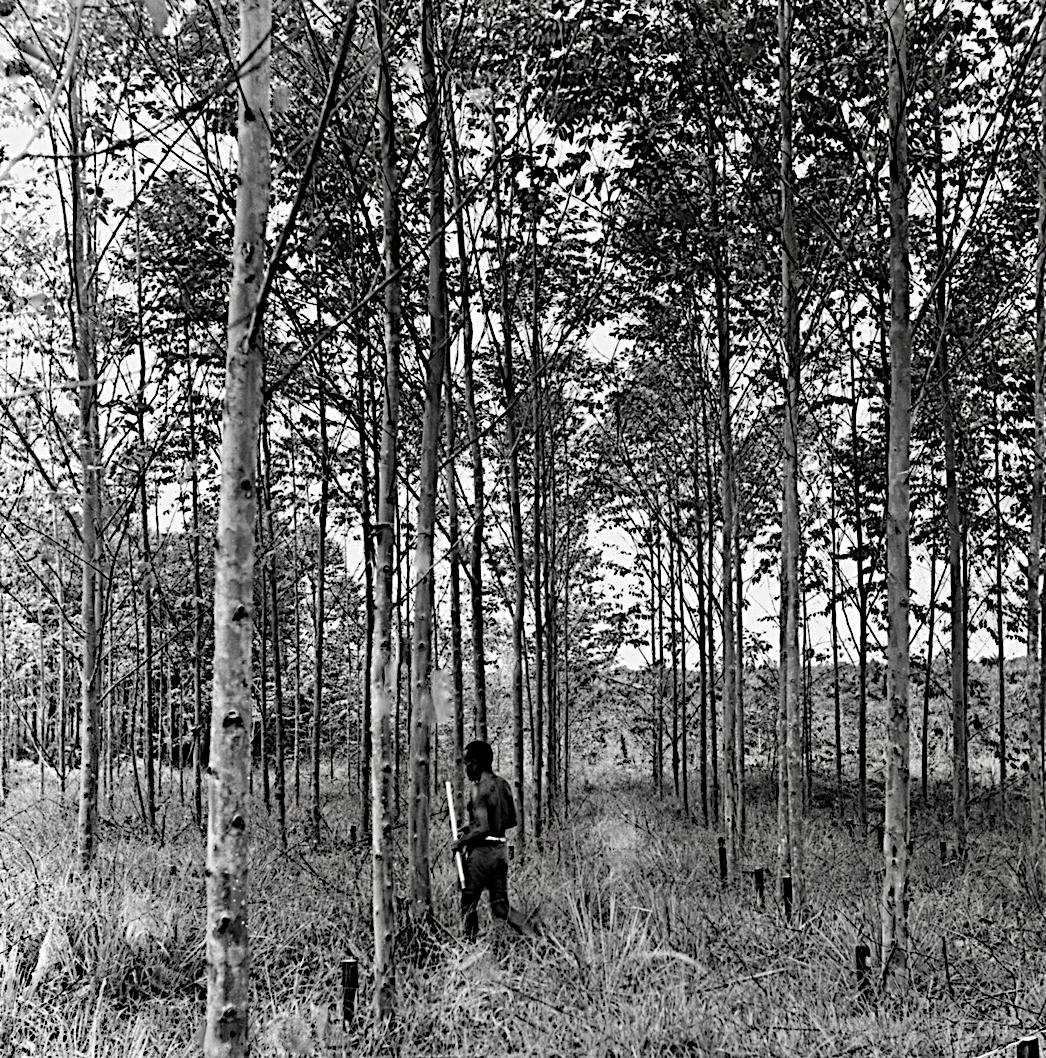
CONTENTS
PART 1
1967 2
Botanical exploration 2
Preparation of a paper for the Ninth Commonwealth Forestry Conference 29
Natural regeneration of E. deglupta 30
Artificial regeneration of E. deglupta from seed 32
Grafting E. deglupta 33
Growing cuttings of E. deglupta 37
Confirmation of E. deglupta as a major native tree species for continuing study 44
I enrol in a Master of Forestry Degree at the ANU 46
PART 2
1968 47
Ninth Commonwealth Forestry Conference 47
Duty travel to Canberra and ANU for initial wood properties examination on E. deglupta 47
Density of the wood of E. deglupta 48
Structure of the wood of E. deglupta 51
Fibre length 51
Statistical design required for the proposed tree improvement programme for E. deglupta 56
Continuation of research on E. deglupta at Keravat 57
Planting trials of E. deglupta 58
Preparation of a paper for a Conference of the Institute of Foresters of Australia 59
Selection and assessment of “candidate” and “breeding” populations of E. deglupta 59
Grafting and cuttings of E. deglupta 60
First visit to Keravat by Professor Pryor of the Department of Botany ANU 62
Helicopter reconnaissance of the Gazelle Peninsula and Central New Britain 66
Flowering and fruiting studies on E. deglupta 69
Emasculation technique developed for flowers of E. deglupta 71
Vegetative propagation of E. deglupta using epicormic and coppice shoots 71
Second visit to the Territory by Professor Pryor of the Department of Botany ANU 75
Wood density variation in E. deglupta 85
Silvicultural Research Conference Bulolo 26 to 30 August 1968 87
1968 96
Writing up a report on the fibre length and density work to date 96
Ordering of a rifle for seed and scion collection 96
Experimental proposals 96
E. deglupta fertilizer trial 98
Professor Pryor visits Mindanao in the Philippines to examine E. deglupta 98
Vegetative propagation of epicormic and coppice shoots of E. deglupta 99
Lopping and tying down branches of E. deglupta to control height growth 99
Establishment of a trial grafted seed orchard for E. deglupta 100
Ordering of a machine for removing wood samples from standing trees 102
Arrival of rifle for collection of seed and vegetative material from tall trees 103
1969 105
Collection of seed and vegetative material of E. deglupta 105
Grafting and cuttings experiments 105
Move to Canberra to take up PhD studies at the ANU 105
Aims of the experimental work to be undertaken during my PhD 104
FAO Forestry and Timber Bureau E. deglupta collecting expedition to Indonesia 106
Fibre wall thickness and lumen diameter 107
Arithmetic ratios of fibre length, wall thickness and lumen diameter 108
Cross sectional area of fibres, fibre wall material and lumens 109
Arithmetic ratios of fibre cross sectional dimensions 109
Percentage of tissue types by volume 109
Number of vessels per unit area of cross section 110
Mean cross sectional area of vessels 110
Co authored paper for 2nd World Consultation on Forest Tree Breeding 110
Formal transfer to a Commonwealth Postgraduate Scholarship 111
Chemistry of the wood of E. deglupta 112
End of wood parameter measurement 113
Associations among the primary and derived variables 114
The association between wood density and other measured wood parameters 116
Baku Forest Station 117
1970 117
Wood sampling in standing trees at Keravat 117
Growing plants in controlled environments 119
Experimental methods for growing plants of E. deglupta in the phytotron 120
Provenance studies in the phytotron 122 Fieldwork in Keravat 123
1971 126
Species trial at Baku, Gogol 126
Membership of Forest Research Working Group No 1 Forest Genetics 127
Wood density among random and candidate populations of trees 127
Environmental and genetic variation in wood density 127
Heritability of wood density in E. deglupta 129
Selection differential 130
Selection of propagation population trees 131
Establishment of provenance trials of E. deglupta in Keravat, Dami and Gogol 132
Investigation of heart rot in E. deglupta 133
Volume tables for E. deglupta 135
1972 139
Site Quality computation for E. deglupta 139
Growth and Yield for E. deglupta 139
Completion of my PhD studies at ANU 141
Bridging Report for Silvicultural Research in PNG 142
E. deglupta seed orchard establishment in Bulolo 142
Hybrid eucalypts 145
Hybridization of E. deglupta and E. “decaisneana” 147
Provenance trials of E. “decaisneana” at Bulolo 148
Simulated pulpwood logging at Baku 151
Confirmation of the award of PhD for my work on E. deglupta 153
First species trial at Baku at age two years 154
PART 4
1972 continued 161
Exploration of E. deglupta in the Garaina area, Morobe Province 161
Latest (1972), more detailed description of E. deglupta 164
Second provenance trial of E. deglupta at Baku 168
Reconnaissance on New Britain 170
PART 5
1973 183
JANT start up in the Gogol 1973 183
Membership of Appita 187
JANT harvesting and reforestation activities 187
E. deglupta spacing trial, Baku 190
Thinning trials Keravat 1973 192
Heartwood decay in E. deglupta 192
Continuing harvesting plots at Keravat for pulpwood volume table compilation 194
Overseas duty travel to east Africa and New Zealand 195
Travel Bulolo PNG to Johannesburg, South Africa 196
IUFRO Division 5 Forest Products meeting 24 September to 12 October 1973, Cape Town and Pretoria, South Africa 198
PART 6
1973 continued 203
Rhodesia 203
Malawi 203
Zambia 207 Kenya 208
Back to Australia and on to New Zealand 210
Recreation leave in Australia from 18 November 1973 to 3 January 1974 212 1974 212
Visit by Christian Cossalter of the Centre Technique Forestier Tropical Congo 212
Visit to Bulolo by Edgard Campinhos Jr of Aracruz Florestal S A 221
Papua New Guinea Tropical Forestry Research Note series 221
Assessment of E. deglupta provenance trial No 2, Keravat, New Britain in 1974 at age 2 years 223
Second provenance trial of E. “decaisneana” at Bulolo 226
July Oct 1974: Vegetative propagation of epicormic and coppice shoots of E. deglupta 229 Bole shape of E. deglupta 234
Provenances 235
Initial spacing or initial stocking 235
Site quality 236
Tree age and average size 237
Practical implications of bole shape 238
An updated general volume table for E. deglupta 241
Further provenance trial of E. “urophylla” 241
Forest Tree Series Leaflet on E. deglupta 243
Progress report on tree introduction and improvement 244
1975 244
Provenance seed collection of E. deglupta in the Celebes and Ceram Islands May 1975 244
Provenance seed collection of E. deglupta in Irian Jaya, Indonesia, 3 17 June 1975 247
Natural distribution of E. deglupta 261
Taxonomy of E. deglupta 268
Taxonomic characters 270
Measurements on E. deglupta leaves preserved as herbarium specimens 272
Measurements on leaves from a provenance trial at Keravat 277
Single taxon at the level of species for E. deglupta 281
Reprinting of my PhD thesis 282
Permission to publish my work on E. deglupta 284
PART 7
1976 285
E. deglupta progeny trial two years old, Kunjingini 285
XVI IUFRO World Congress, Oslo, Norway 287
1977 289
FAO/IUFRO Third World Consultation on Forest Tree Breeding 289
Post Consultation tour to Coffs Harbour 291
IUFRO Workshop, Brisbane 293
1978 293
Visit to Ulamona to investigate damage to a plantation of E. deglupta owned by the Catholic Mission and impacted by a recent volcanic eruption 293
Industrial Timber Corporation of Indonesia 300
Paper Industries Corporation of the Philippines 302
Jari Brazil 306
Seed production from the E. deglupta seed orchard, Bulolo 308 1979 310
Conference on Forest Land Assessment and Management for Sustainable Uses 310 1980 310
Visiting Scientist at the CSIRO Division of Forest Research, Canberra 310
IUFRO Symposium and Workshop on Genetic Improvement and Productivity of Fast Growing Tree Species, Brazil 311
Case studies on forest and watershed development in Asia and the Pacific 325
Reprint of Forest Tree Leaflets 326
1983 326
Publication of the papers given at the IUFRO Symposium on Genetic Improvement and Productivity of Fast Growing Tree Species in Brazil, August 1980 326
IUFRO meeting on frost resistant eucalypts 327 1984 328
Award of the Marcus Wallenberg Prize to the research team at Aracruz working on Vegetative propagation 328
PICOP at its peak in 1984 329
1986 329
Data book on endangered tree species 329 1993 330
PICOP revisited in 1993 330
PART 8
1993 continued 333
UNDP/FAO Regional Project FORTIP 333
Publication of Eucalypt Domestication and Breeding 333 1994 334
Second edition of Eucalypt Domestication and Breeding 334
1995 335
Genetic variation in height growth and leaf colour in E. deglupta 335
1997 336
Pulping and papermaking potential of plantation-grown E. deglupta from PNG 336
2003 336
Molecular studies on Eucalyptus subgenus Minutifructus 336
2007 342
Breeding programme for E. deglupta in the Solomon Islands 342 2008 342
E. deglupta Seed Orchard Bulolo 342 2011 342
Herbarium collections of E. deglupta by K Damas 342
Open Bay Timber Company 344 2013 345
E. deglupta chloroplast genome sequenced 345
ACIAR Project “Facilitating the availability and use of improved germplasm for forestry and agroforestry in Papua New Guinea” 347 2014 348
Reference genome of E. grandis released 348 2015 349
Article on E. deglupta in “The Forester” 349 2017 350
E. deglupta in the Adelaide Botanic Garden 350 2018 350
E. deglupta in “Trees for Life in Oceania” 350 2019 353
Our book on “Eucalypt Domestication and Breeding” 353 Geological time line with reference to some eucalypts 354
Open Bay Timber Plantations 359
Keravat 2019 360
ABBREVIATIONS AND ACRONYMS 361
1973
continued
Rhodesia
Rhodesia (now Zimbabwe) was bypassed on this trip because of security concerns. A guerrilla insurgency against white rule was intensifying, with rivals Zanu and Zapu operating out of Zambia and Mozambique. At the time Rhodesia had significant tree improvement programmes for eucalyptus, pine and acacias run from the John Meikle Forest Research Station near Mutare and carried out by R D Barnes, L J Mullin, R L Barrett, D T Carter, B R T Seward and others.1
Malawi
On Monday 15 October 1973 we flew from Johannesburg to Blantyre in Malawi.

Gloria and Ivon wait with me to board this South African Airlines Boeing 727 for the flight to Blantyre, Malawi.
We were met at Blantyre airport and taken from there by road to a number of locations to look at eucalypt and pine plantations, seed orchards and nurseries in southern Malawi (below).
1 For example, see Barrett R L and Carter D T 1970 Eucalyptus camaldulensis provenance trials in Rhodesia (Part 1, early results). Research Bulletin 2 (Part 1). Rhodesia Forestry Commission, Salisbury. A number of publications by the scientists mentioned followed in the late 1970s and through the 1980s.
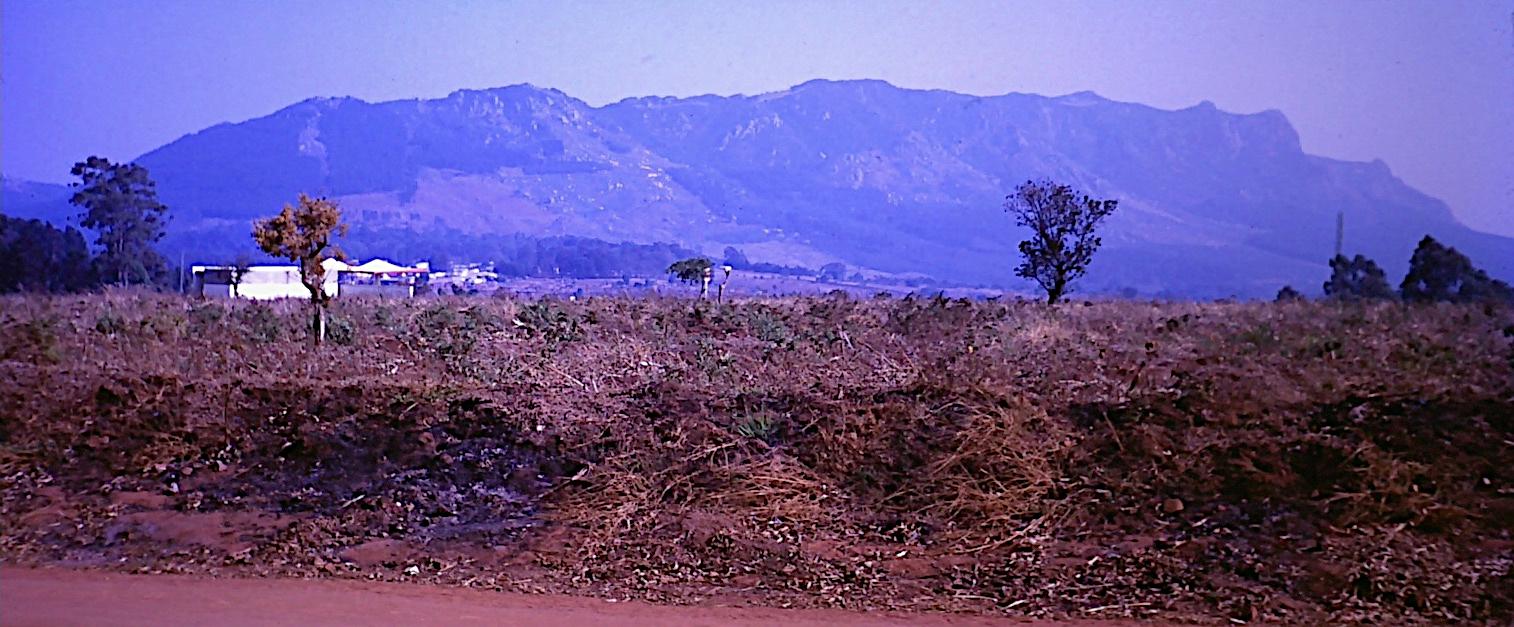
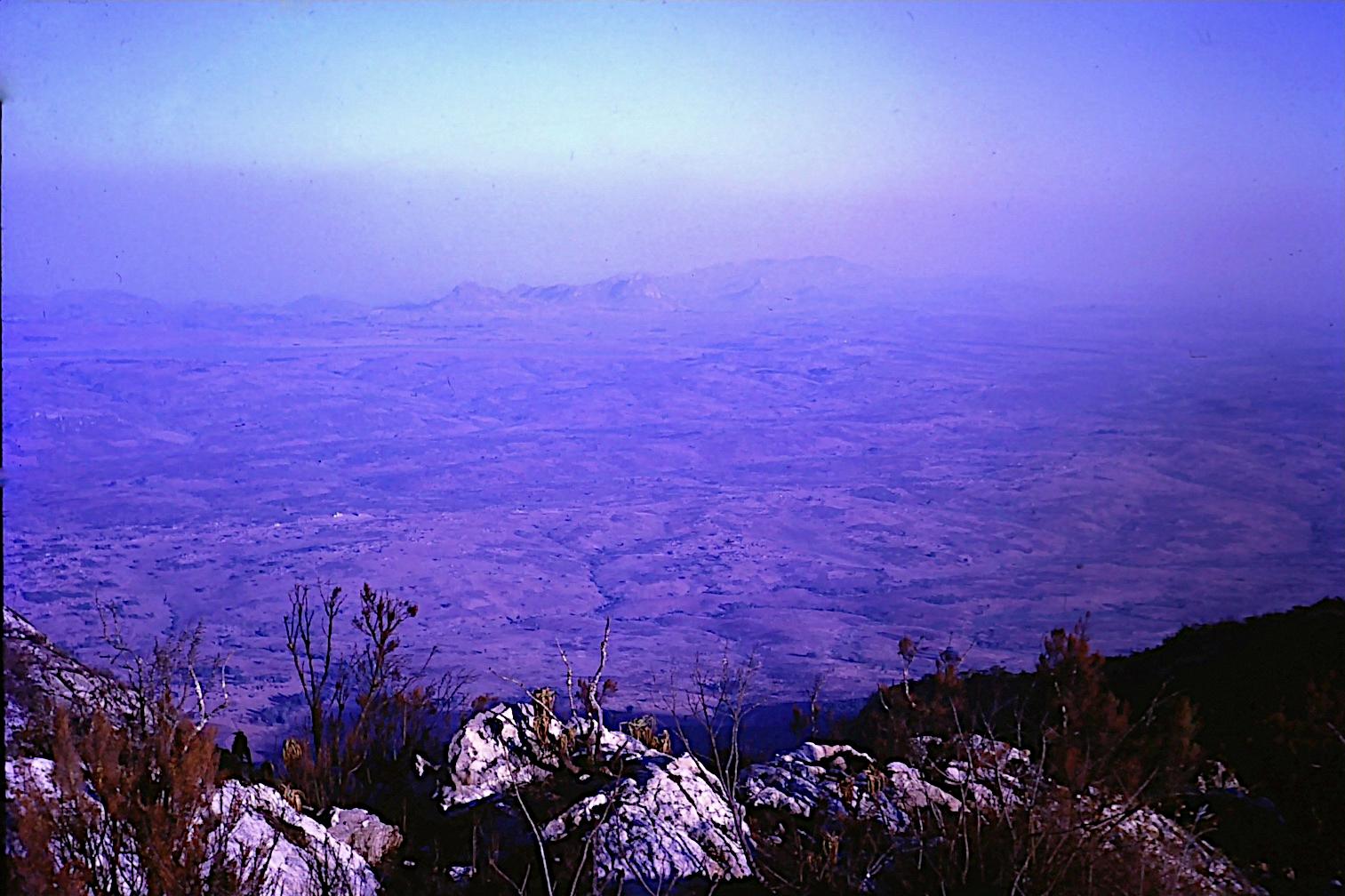


Overnight we made an unscheduled stopover without immigration and customs formalities just across the border in Mozambique in a non descript motel. With occasional nervous glances out the toilet window at the back into what was described as “guerrilla country” some sleep was achieved. Bread and fried eggs were found in the nearby restaurant for the three of us for breakfast. Then it was back to Blantyre on Tuesday afternoon to catch the flight to Lusaka, Zambia.

The location where we made our overnight stay just over the Malawi border in Mozambique. Top: Basic motel style rooms. Bottom: Adjacent restaurant where we were able to order fried eggs and bread for breakfast.
Zambia

Wednesday 17 October 1973 was spent in Lusaka and environs being briefed on EAAFRO activities on breeding pines and eucalypts. On 18 October at 7.45 AM we left Lusaka for Nairobi on Zambia Airways, remained at the airport and left for Entebbe, Uganda at 7.30 PM the same day on an East African Airways Douglas DC 9. Entebbe with its international airport sits on the northern shores of Lake Victoria, Africa's largest lake. The town is about 44 kilometres south of Kampala, now Uganda's capital and largest city.

Friday 19 and Saturday 20 October 1973 were spent in Entebbe and environs visiting and discussing EAAFRO activities on provenance studies and seed orchard establishment for eucalypts and pines. There was also time to celebrate Ivon’s first birthday. At 9.00 PM we left Entebbe for Nairobi again in Kenya.
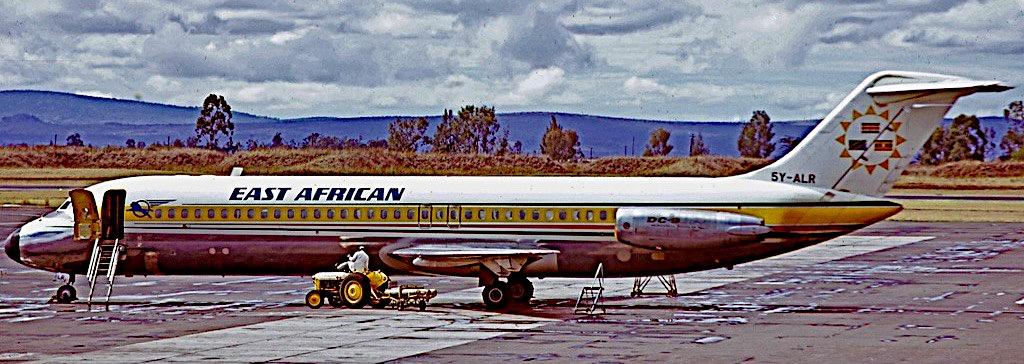
Kenya
From Monday 22 to Friday 26 October 1973 in Nairobi I attended a joint meeting on tropical provenance and progeny research and international cooperation by IUFRO Working Parties S2.02.8 Tropical Species Provenances and S2.03.1 Breeding Tropical and Subtropical Species.
In the formal part of the meeting, I presented four papers, three on provenance trials of pines in Papua New Guinea for which Nev Howcroft was senior co author and one authored by me on provenance trials on E. deglupta. 2These papers were published in the Proceedings.3
In discussion following my presentation on E. deglupta, the participants agreed with me that additional provenance seed collections were required from Sulawesi, Seram and Irian Jaya in Indonesia. It was suggested that CTFT personnel be requested to collect from Sulawesi and Seram because of their
2 Howcroft N and Davidson J 1973 A provenance trial of Pinus caribaea in Papua New Guinea. Combined Meeting of IUFRO Working Parties S2.03.1 and S2.02.8, Nairobi, Kenya; Howcroft N and Davidson J 1973 An international provenance trial of Pinus merkusii in Papua New Guinea. Combined Meeting of IUFRO Working Parties S2.03.1 and S2.02.8, Nairobi, Kenya; Howcroft N and Davidson J 1973 A provenance trial of Pinus kesiya in Papua New Guinea. Combined Meeting of IUFRO Working Parties S2.03.1 and S2.02.8, Nairobi, Kenya; Davidson J 1973 Provenance trials of Eucalyptus deglupta in Papua New Guinea. Combined Meeting of IUFRO Working Parties S2.03.1 and S2.02.8, Nairobi, Kenya.
3 Burley J and Nikles D G (eds) 1973 Proceedings of a joint meeting on tropical provenance and progeny research and international cooperation held in Nairobi, Kenya, 22 26 October, 1973 by IUFRO working parties: S2.02.8 Tropical Species Provenances, S2.03.1 Breeding Tropical and Subtropical Species. Oxford, Commonwealth Forestry Institute. 597 pp.
experience already in collecting eucalypts in eastern Indonesia and that FRI Australia and PNG personnel mount a separate mission into Irian Jaya from Vanimo in PNG.
I raised the issue that because of the rising prominence of breeding eucalypts, the Working Parties consider forming an “Action Group” of specialists on eucalypt provenances and breeding. I was willing to start up and lead such a group.
Since I would be attending the meeting of IUFRO Working Party S2.01.5 (Reproductive Processes) in Rotorua almost immediately after this meeting, participants in Nairobi requested I prepare a report on that meeting for later circulation to members of working parties: S2.02.8 Tropical Species Provenances and S2.03.1 Breeding Tropical and Subtropical Species
The 28 storey Kenyatta International Conference Centre, Nairobi, opened in September 1973, just before our visit.
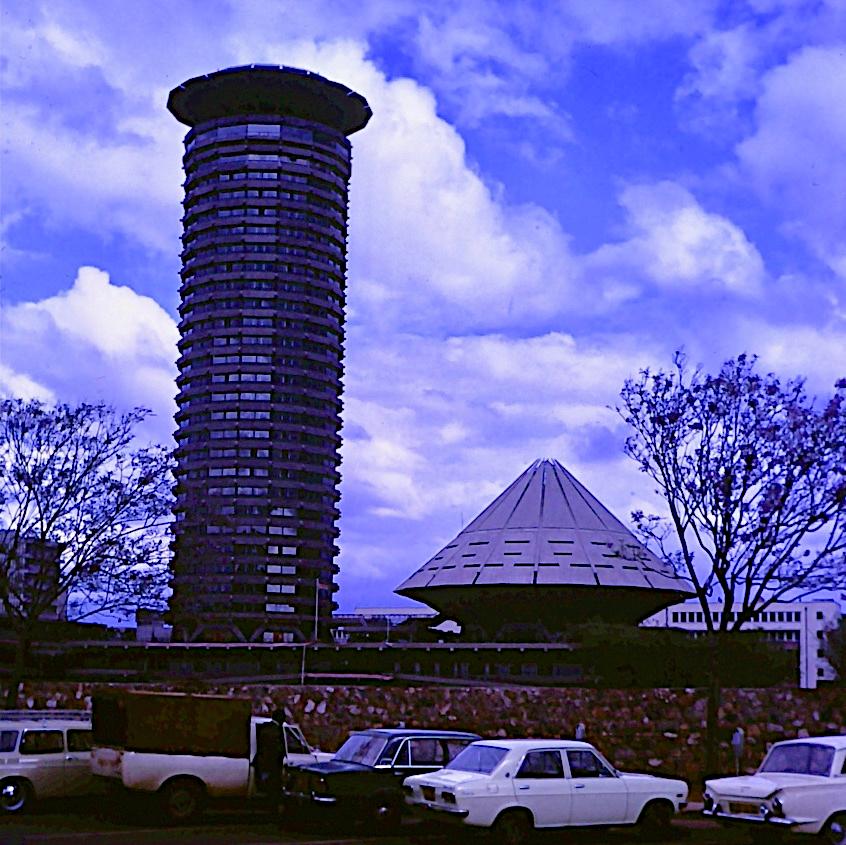
On Saturday 27 October 1973 we travelled to Muguga, about 24 km from Nairobi and at about 2,100 m altitude, the location of EAAFRO.4We were informed the Organisation came into being because the then governments of Kenya, Uganda, Tanganyika and Zanzibar agreed to cooperate in carrying out research in forestry and agriculture especially and also for animal husbandry, fish, tsetse flies and trypanosomiasis. Research work had to be practical and applied with a minimum of long term experiments, even in forestry. Examples included experiments in forest nursery techniques and trials of exotic tree species, forest entomology and maintenance of an East African Herbarium and an excellent library. At the time about a quarter of the recurrent costs were being covered by the United Kingdom.
We left Nairobi by road for Dar es Salaam, Tanzania, again calling in on field locations of a number of EAAFRO sponsored species trials of pines.
4 EAAFRO, the East Africa Agriculture and Forestry Research Organisation. From July 1977 its activities in Muguga were taken over by the Kenya Agriculture Research Institute.
Back to Australia and on to New Zealand
On Friday 2 November we flew out of Dar es Salaam on Air Madagascar for Tananarive, Madagascar. There was no suitable scheduled onwards flight until the following Tuesday, so the time was spent on some local touring of the city which had numerous monuments, historic buildings and sights of significance especially from the French colonial era. Our onwards flight was by Air France to Mauritius for an overnight stop, then on Qantas on Wednesday 7 November via Perth and Melbourne to Sydney
arriving early on Thursday 8 November 1973 . The only sleep possible was on the aircraft overnight because we took off again from Sydney for Auckland New Zealand at 8.00 AM and from Auckland on a connecting Mount Cook Airlines domestic flight to Rotorua. Once again jetlag set in!

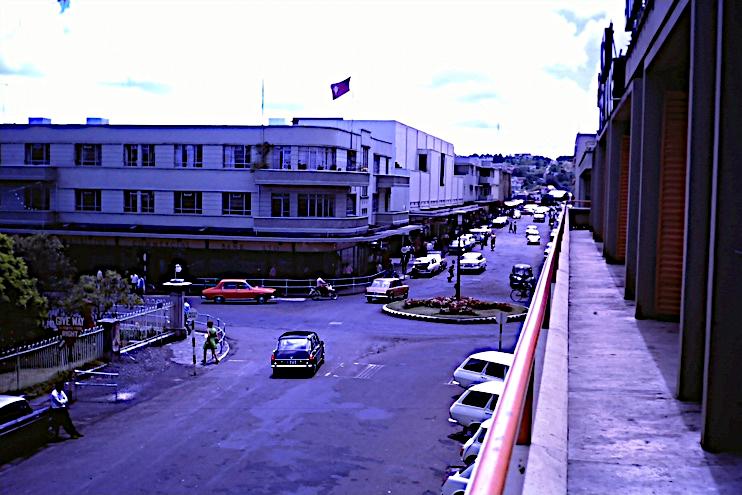
From 12 to 17 November was spent at the meeting of IUFRO Working Part S2.01.5 Reproductive Processes on “Vegetative Propagation of Forest Trees” in Rotorua. There were 28 participants from New Zealand, Australia and PNG as well as from USA, Japan, Korea, West Germany, Denmark, Brazil and Spain. All sessions were plenary. Topics included:
Physiology The Biochemistry of Rooting (4 papers)
Physiology The Physiology of Rooting (4 papers, including one of mine5)
Vegetative Propagation for Plantation Establishment A. Prospects and Problems (4 papers)
Vegetative Propagation for Plantation Establishment B. Differences Between Cuttings and Seedlings (4 papers)
Vegetative Propagation of Conifers A. Grafting (2 papers)
5 Davidson J 1973 Some physiological aspects of rooting cuttings of Eucalyptus deglupta. Meeting of IUFRO Working Party S2.01.5, Rotorua, New Zealand.
Vegetative Propagation of Conifers B. Cuttings (5 papers)
Vegetative Propagation of Hardwoods A. Other Genera (9 papers)
Vegetative Propagation of Hardwoods B. Eucalyptus (5 papers, including three of mine6 )
The Use of Cuttings to Provide Genetic and Other Information (3 papers)

Tissue Culture (4 papers)
Of particular interest was the paper by Peter Burgess on vegetative propagation of flooded gum, concerning his work with APM at Coffs Harbour Australia on E. grandis and assisted by Lindsay Pryor as consultant to APM. The representative from Brazil (W F Suiter, University of São Paulo) was particularly interested in the work on vegetative propagation of E. deglupta in PNG and E. grandis in Australia
During the discussion following my presentation on incompatibility symptoms in grafts of E. deglupta, I showed a slide illustrating an incompatible graft (left). This sparked some debate as to whether what was happening was an aberration of the phloem or xylem occurring at the cambial layer. No clear cut opinion emerged from the discussion by the delegates.
On Saturday 17 November, we flew Rotorua to Auckland on Mount Cook Airlines. Duty travel ended and recreation leave began at this time. On Sunday 18 November 1973, we flew Auckland to Brisbane, departing at 8.00 AM on Air New Zealand Flight TE80.
6 Davidson J 1973 Incompatibility symptoms in grafts of Eucalyptus deglupta. Meeting of IUFRO Working Party S2.01.5, Rotorua, New Zealand; Davidson J 1973 Techniques of grafting Eucalyptus deglupta. Meeting of IUFRO Working Party S2.01.5, Rotorua, New Zealand; Davidson J 1973 A technique for rooting seedling cuttings of Eucalyptus deglupta Meeting of IUFRO Working Party S2.01.5, Rotorua, New Zealand.
My four papers were edited into two and published later in a special number of the New Zealand Journal of Forest Science.7

Recreation leave in Australia from 18 November 1973 to 3 January 1974
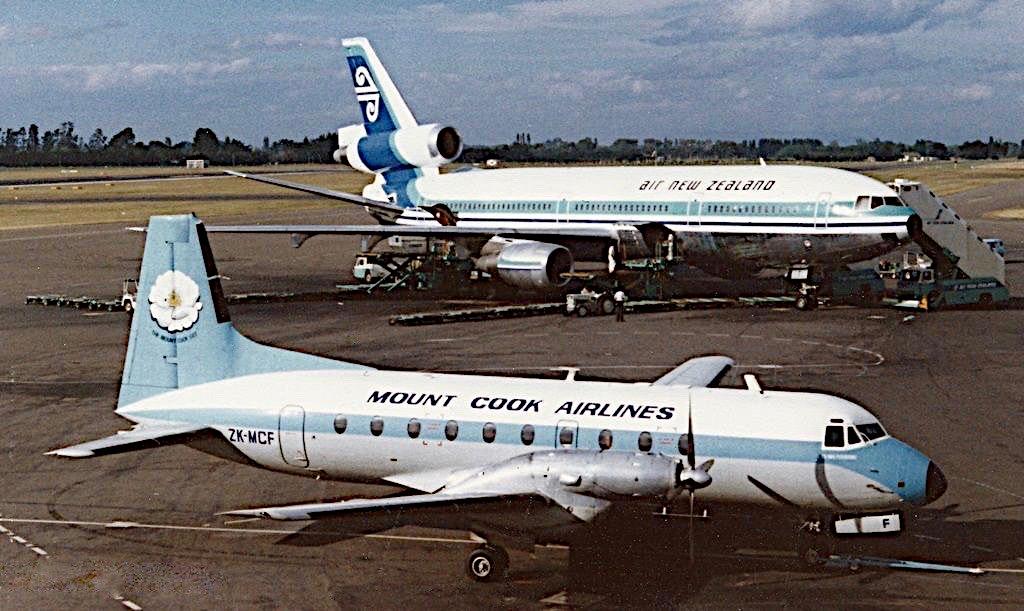
The granting of backdated six months study leave on full pay meant recreation leave started to accrue from October 1971 while I was still in Canberra, with the leave due to be taken after 21 months from then, that is from mid June 1973. At this time permanent expatriate members of the PNG public service were being pressured to take leave when it became due. I had to apply to have the start of leave deferred by about five months to take place immediately after the overseas duty travel to Africa and New Zealand. However, at the time, I only ended up drawing down the 12 weeks leave due by about 6½ weeks and returned to PNG on 3 January 1974.
1974
7 Davidson J 1974 Reproduction of Eucalyptus deglupta by cuttings. New Zealand Journal of Forest Science 4(2):191 203; Davidson J 1974 Grafting Eucalyptus deglupta New Zealand Journal of Forest Science 4(2):204 210.
Following his latest of several visits to the Lesser Sunda Islands of eastern Indonesia and Portuguese Timor exploring and collecting eucalypt species, Christian Cossalter, then Ingénieur de Recherches au Centre Technique Forestier Tropical Congo, contacted me to arrange a visit to Bulolo in early 1974 to discuss and observe my work on vegetative propagation of E. deglupta and to discuss his travels and collecting activities that he had undertaken for E. “decaisneana”. Before his arrival I prepared a synopsis of my own observations and work on E. “decaisneana” at Bulolo.
Bark:
For Timor, the two higher altitude provenances had rough bark, the lower altitude provenance smooth bark. The Flores provenance had smooth bark, peeling in broad flakes.
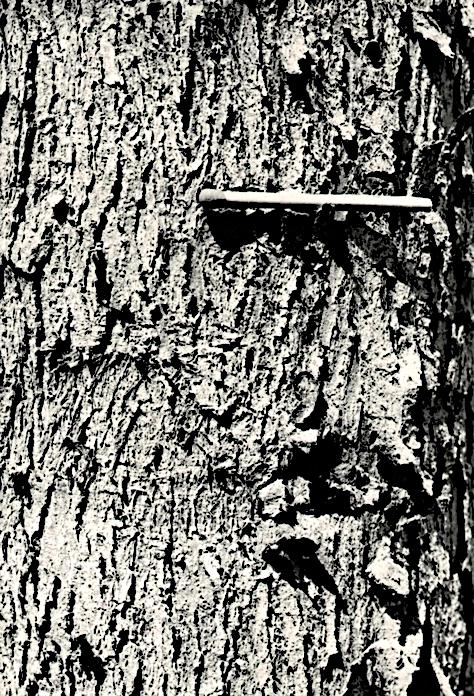


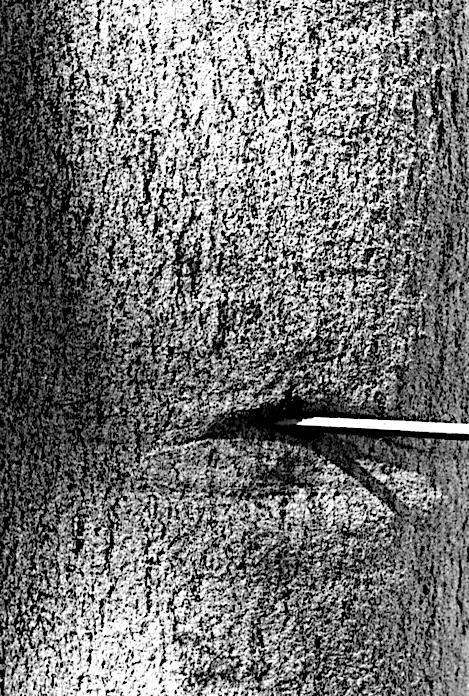
Images of bark one metre above ground for four provenances of E. decaisneana at age about three years. The included object is a matchstick, so the scale here is about 1:1. Top left: 338 Indonesian Timor 580 m, intact smooth bark with powdery glaucous surface; Top centre: 336 Dili, Portuguese Timor, 1,097 m, rough bark; Top right: Provenance 339 Portuguese Timor 1,250 m elevation, rough fibrous bark; Left: 337 Flores, Indonesia 425 m, smooth bark, peeling off in broad flakes.
Leaves:
Leaves from 336 Dili, Portuguese Timor (1,097 m elevation) are shown above at approximately half natural size. At the top is the underside with a raised mid rib. Below is the topside with a flush to somewhat indented mid rib. Typical penniveined main venation and a visible intra marginal vein are shown. However, leaf morphology was found to variable in this species. In an attempt to make sense of the variation a number of morphometric characters was measured on individual leaves as shown in the list below and matched to the diagram on the left.
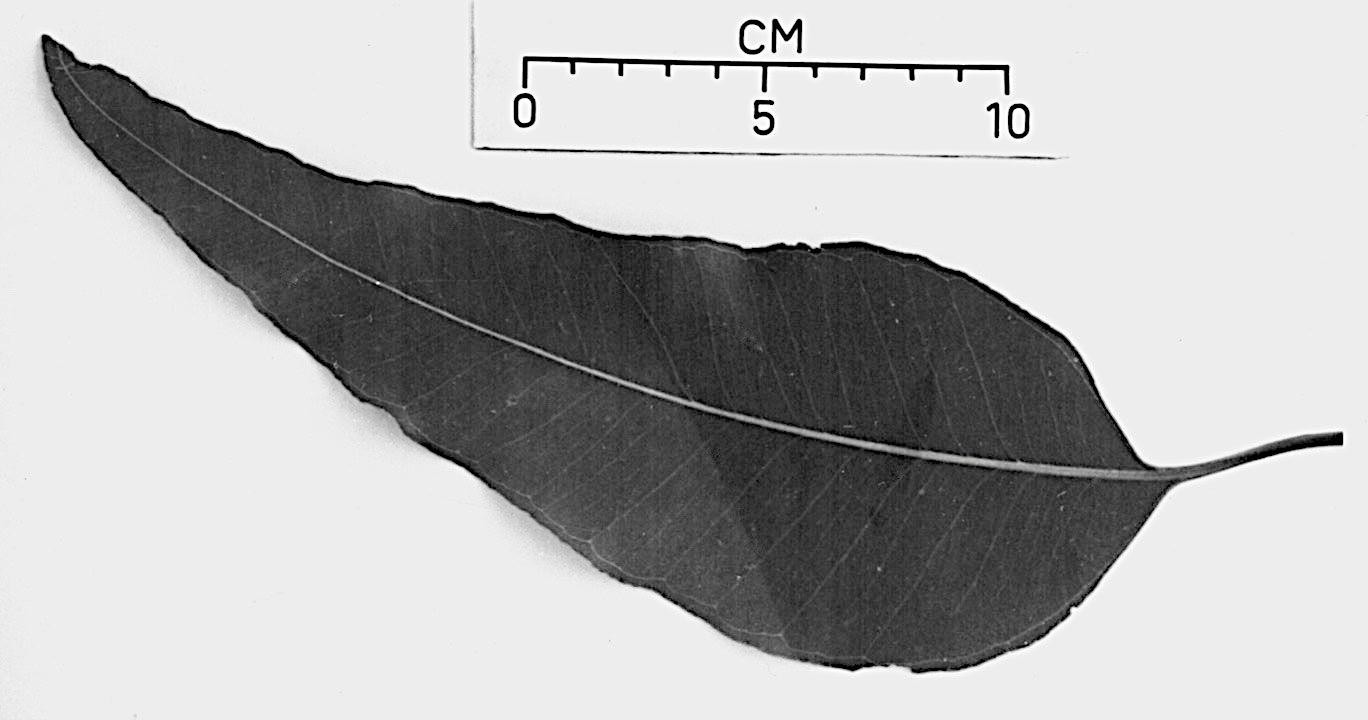
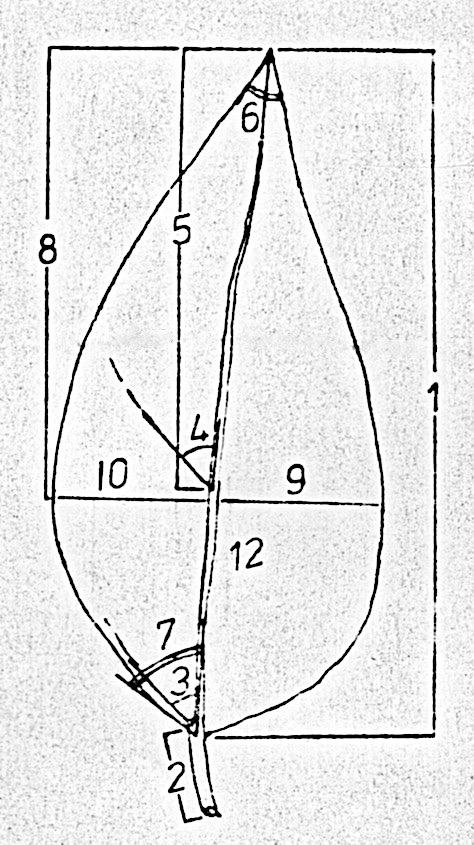
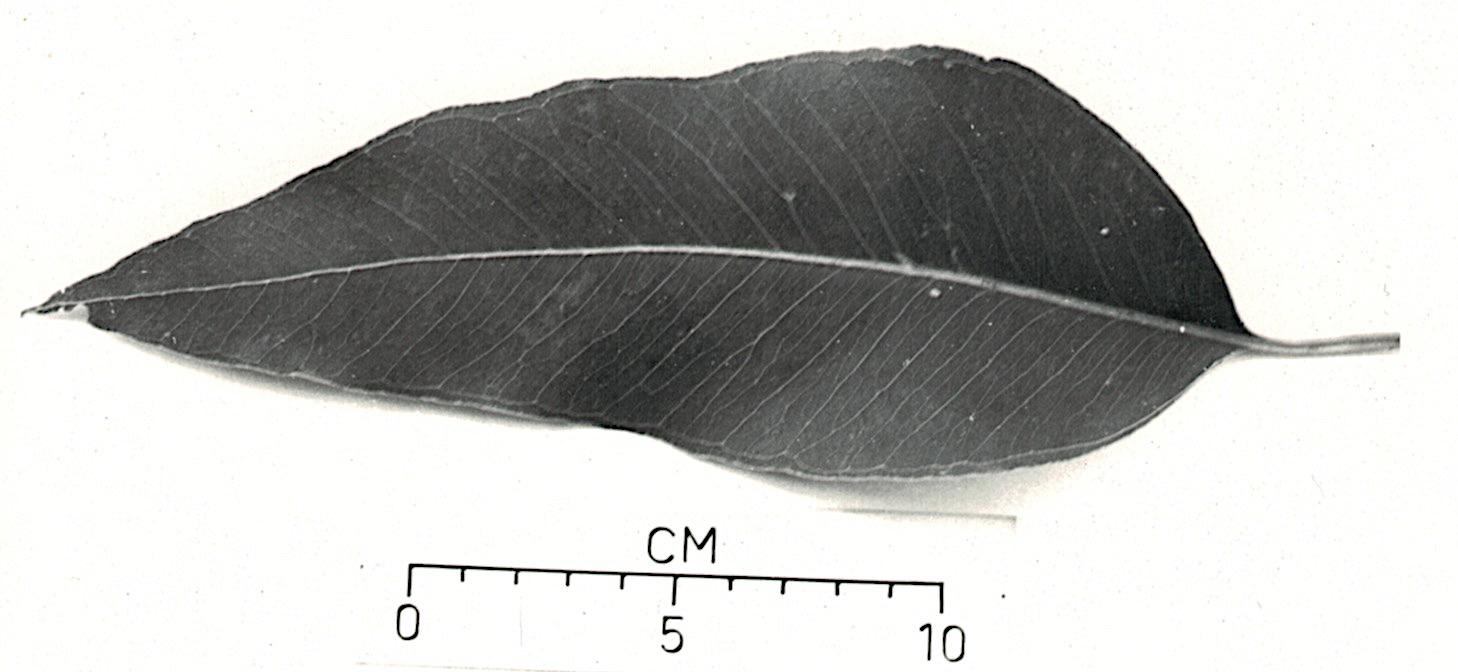
1. Blade length
2. Petiole length
3. Angle of the first lateral vein to the mid rib
4. Angle of the fourth main lateral vein to the midrib
5. Distance between the base of the fourth vein and the tip
6. Apex angle
7. Base angle (margin to mid rib)
8. Distance of the widest part from the tip
9. Half blade width, narrower half, measured at the widest part of the blade
10. Half blade width, wider half, measured at the widest part of the blade
11. Ratio 8/1
12. Leaf area
Ten trees from each provenance were chosen at random at age three years. Six leaves were measured on one of the high terminal branchlets of each. These comprised leaves 4 9 counting back from the tip of the branchlet. Results are in the tables below. Jeff Fairlamb assisted with the measurements.
AVERAGE MORPHOMETRIC LEAF DATA FOR FOUR PROVENANCES OF E. “DECAISNEANA” GROWN AT BULOLO
Provenance and Number Latitude Longitude Altitude (m) Blade Length (mm)
Flores, Indonesia (337)
Petiole Length (mm)
Angle 1st Vein (°)
Angle 4th Vein (°)
8° 40` 122° 30` 425 132 18 60 63
Portuguese Timor (338) 8° 39` 125° 27` 580 147 27 65 59
Dili, Portuguese Timor (336) 8° 47` 125° 25` 1,097 174 21 67 61
Indonesian Timor (339) 9° 37` 124° 15` 1,250 142 21 58 55
AVERAGE MORPHOMETRIC LEAF DATA FOR FOUR PROVENANCES OF E. “DECAISNEANA” GROWN AT BULOLO (Continued)
Provenance and Number Distance 4th Vein to Tip (mm)
Apex Angle (°)
Base Angle (°)
Distance Widest Part from Tip (mm)
Half Blade Width Narrower Half (mm)
Half Blade Width Wider Half (mm)
Ratio: Distance Widest Part Over Total Length
Leaf Area (mm2)
Flores, Indonesia (337) 97 19 60 97 25 28 0.74 47.1
Portuguese Timor (338) 102 37 67 108 38 41 0.73 76.8
Dili, Portuguese Timor (336) 115 13 65 125 32 37 0.72 82.9
Indonesian Timor (339) 95 12 50 101 22 25 0.71 43.4
When “average” leaves were drawn to scale there was a marked difference with altitude among the Timor provenances. Leaves with the greatest area and length were from the mid altitude. Relatively broad leaves from the low altitude provenance contrasted with narrower leaves as altitude increased. The base angle became more acute and the apex angle forming a drip tip became more pointed (more acute). The Flores leaves, though from a relatively low altitude, were more like the higher altitude Timor leaves in size, area and shape.
Scale drawings of “average” leaves constructed from data in the tables above. As presented here the drawings are reduced to about 25% of actual size.
Buds, flowers and fruits
Bud and fruit morphologies were variable across the four provenances. In the Timor provenances, umbellasters were axillary, usually 7 flowered sometimes up to 10 flowered comprising a rosette surrounding a single central bud. Peduncles were long (to 2 3 cm), slightly flattened and expanded towards the distal end. The larger diameter peduncles tended to be two and four ribbed. Pedicels were 5 10 mm long and also tending to be 2 or 4-ribbed. The calyptra was rugose, about equal to the length of the hypanthium,
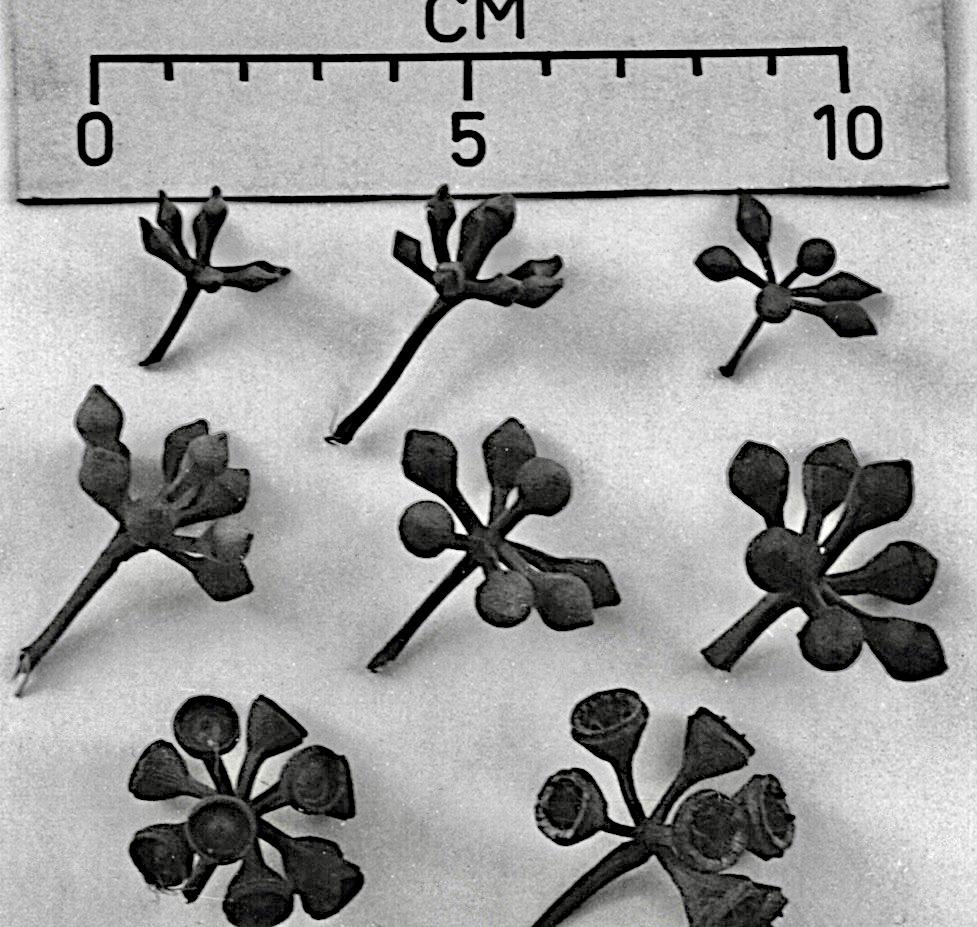
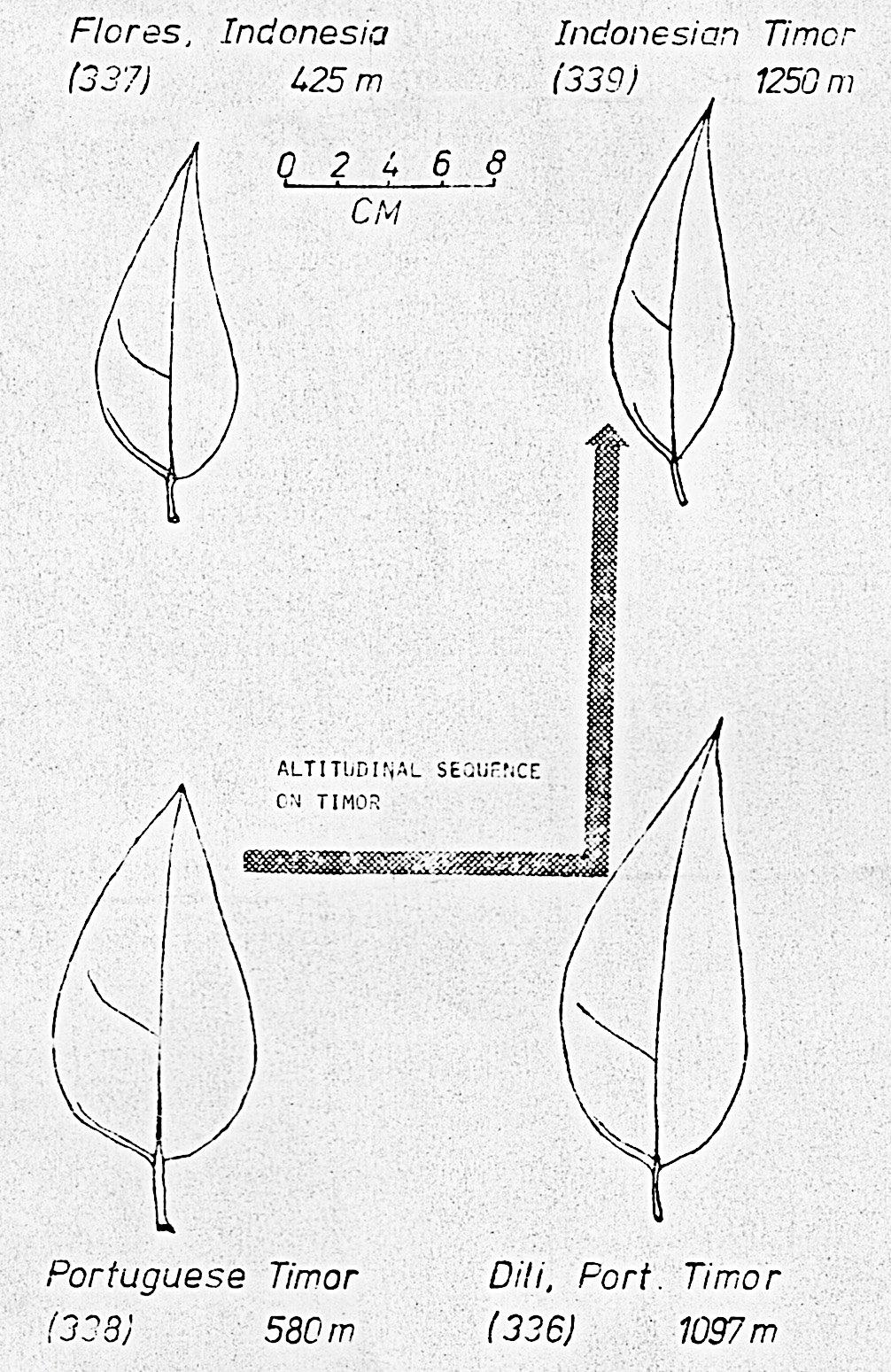
and from broadly conical when young to somewhat hemispherical umbonate just before anthesis. The outer calyptra was shed early leaving an irregular scar. Fruits were hemispherical to campanulate, generally somewhat longer than broad, smooth or two to four ribbed toward the base. The inner calyptra scar was about 2 mm wide, elongated upwards to meet a sunken disc between the stemonophore scar and the base of the valves, which were deltoid, short and barely exsert. Loculi were usually four in number.
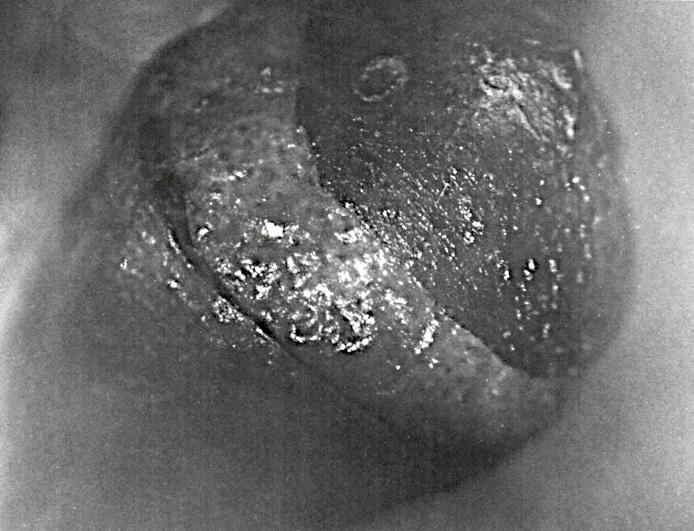

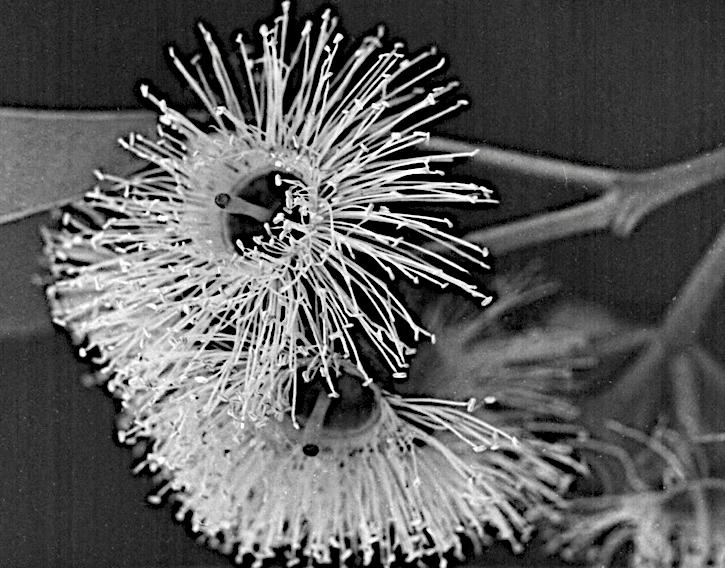
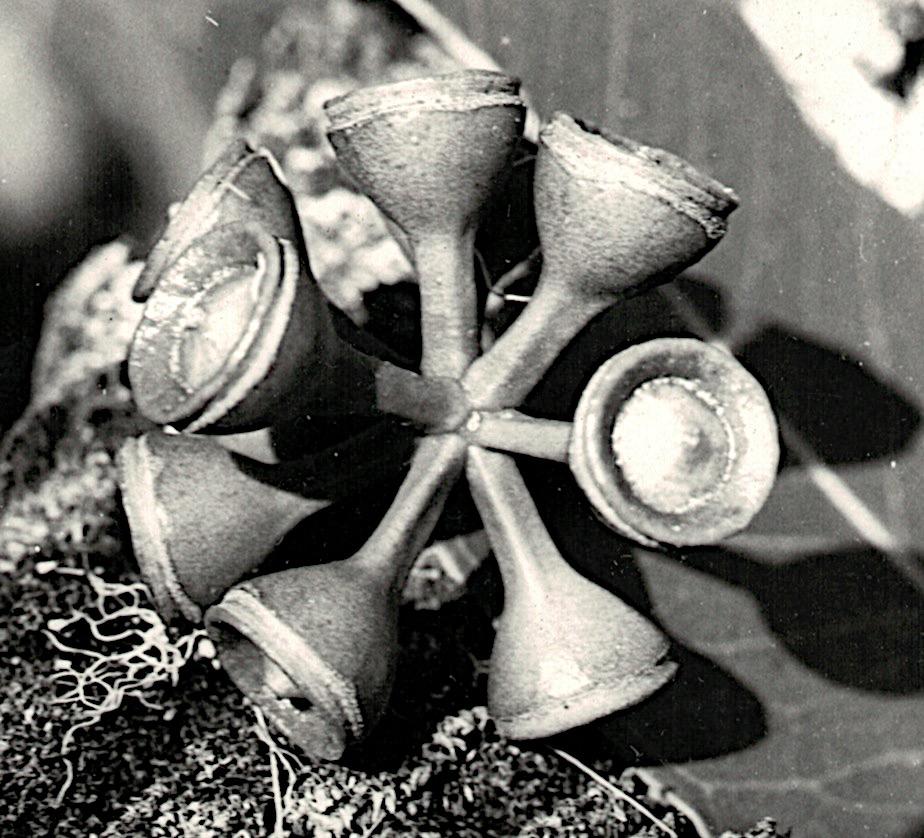
Top left: Outer calyptra being shed. Top right: Narrow outer calyptra scar and rugose surface of the maturing bud in the Timor provenances. Bottom left: Flowers with white stamens, style elongated and receptive. Anthers were oblong, rounded and dehisced by separate slits. Right: An 8 flowered umbellaster after fertilization showing an inferior ovary, hemispherical faintly ribbed lower hypanthium and four ribbed peduncles. The central bud stood vertically above the rosette of other radially arranged buds.
Buds of the Flores provenance differed from those of the Timor provenances. The axillary umbellasters were usually 7 flowered, rarely more, and the pedicels were very long, 3 4 cm, barely flattened or
expanded at the distal end. Buds were glabrous not rugose, broadly conical, tapering into short quadrangular peduncles.
Buds of 337 Flores, Indonesia, showing the long, narrow axillary pedicels, quadrangular peduncles and smooth umbonate, almost short conical, calyptra typical of this provenance.
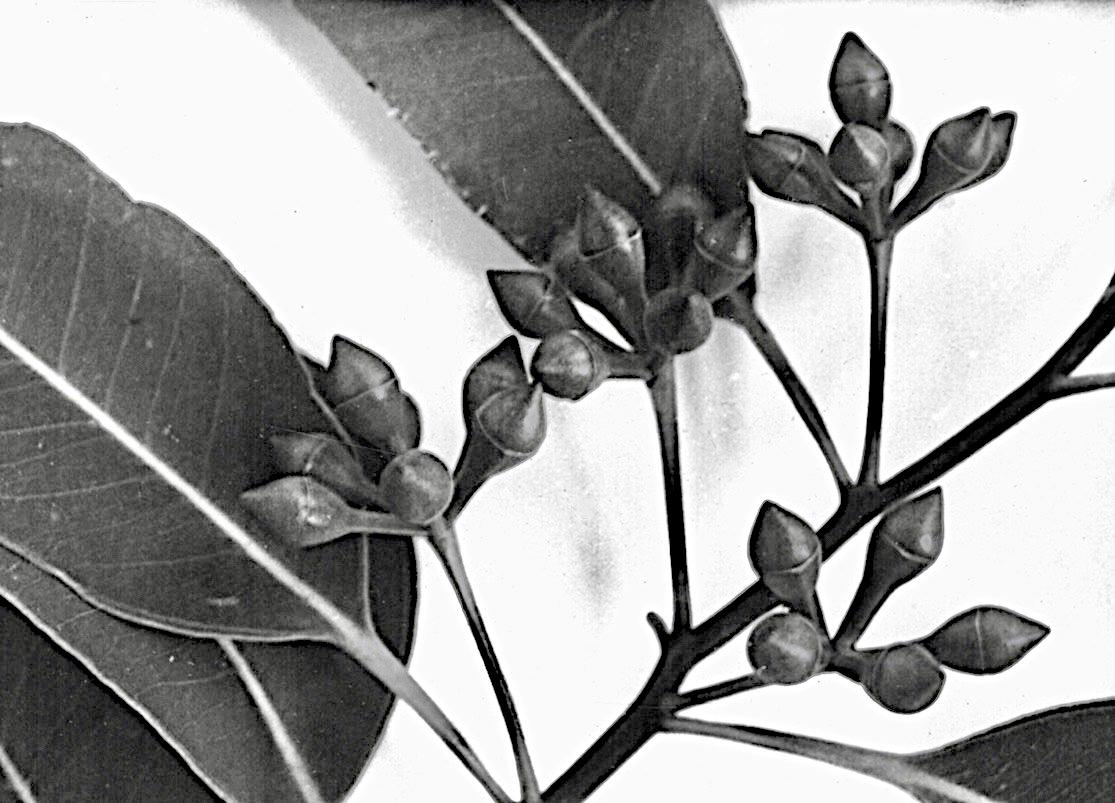
Diagram of parts of E. “decaisneana” intended to show the approximate mid point of the range of variation in taxonomic characters for the Timor provenances. 1. Leaves and buds, 2. Leaves and fruits, 3. Flower, 4. Capsule end view, showing 4 loculi, 5. Capsule side view, showing barely exsert deltoid valves, ribbed lower hypanthium and peduncle, 6. Rugose, hemi spherical umbonate inner calyptra, 7. Longitudinal section of bud just before anthesis, 8. Longitudinal section of bud just after anthesis, 9 11 Anthers (9 showing dehiscence by separate slits). (Drawings by Neville Howcroft, Bulolo, 1973.)
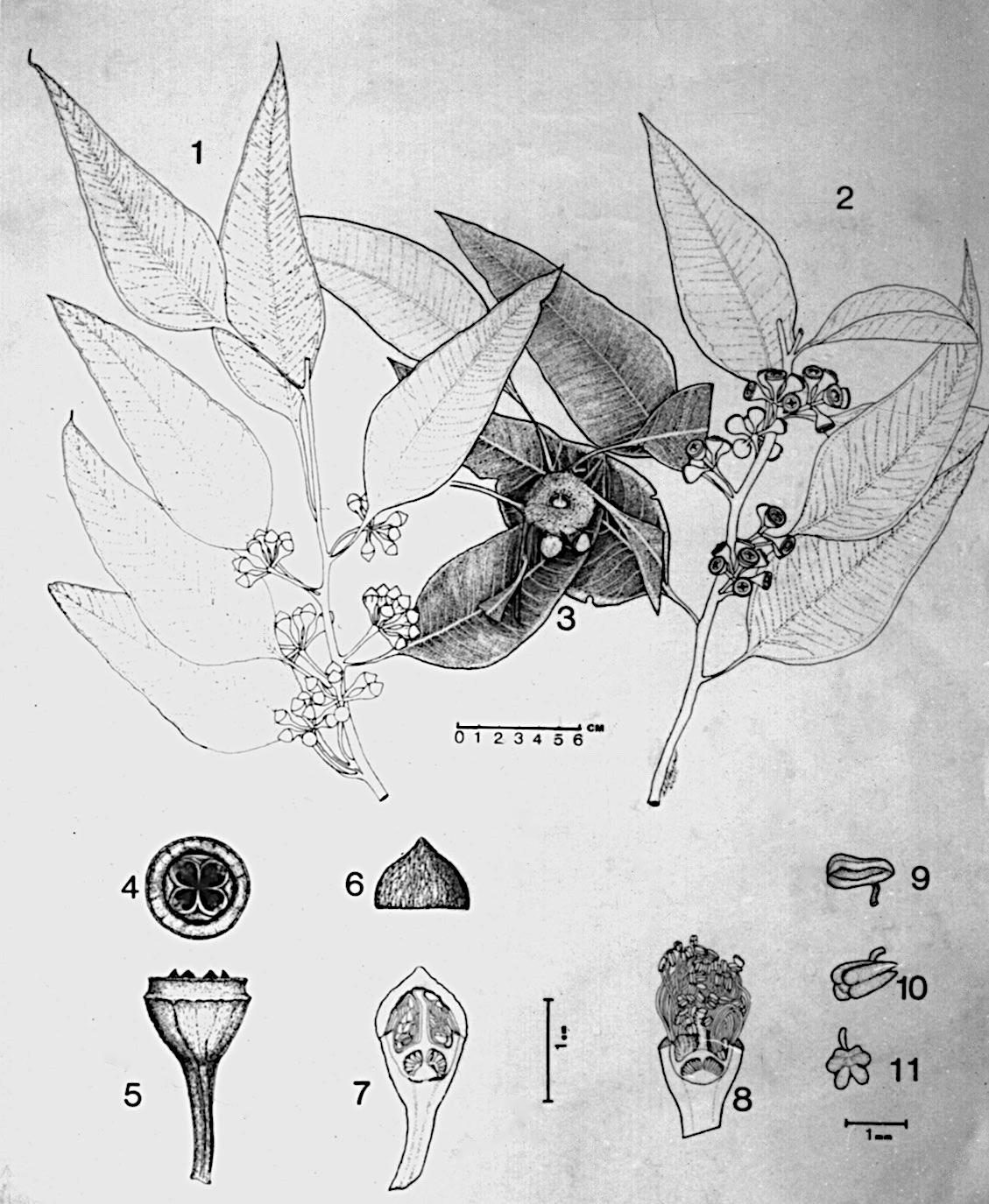
In discussion with Christian, I mentioned that to get around the continued use of the illegitimate name E. “decaisneana”, I would propose to publish a new name for the species, as “Eucalyptus malesiana”.8 I drove Christian to Lae, where we visited the Herbarium to look through the eucalypt specimens held there. There were no specimens of E. “decaisneana” held there at the time but one sheet caught our attention (next page). This sheet (No. 13517) collected by L Long 15 March 1954 at Djidjurug, altitude 5 m, in the Merauke region of Dutch New Guinea (now Papua Province, Indonesia) was a duplicate of No. B. W. 569 “ex Herbario Lugduno Batavo” (Duplicates had also been sent to Kew, UK and the NSW Herbarium and Herbarium Australiense (CANB) in Australia.) On the Lae specimen, the miss spelled name “Eucalyptus falba” had been corrected to “alba”, authority “Reinw” added, and the handwritten note “Det at Kew, April, 1958” was signed by John Womersley, then Forest Botanist at the Herbarium in Lae.
Christian and I agreed the specimen was not E. alba because of a number of features. Strongly discolourous narrow lanceolate leaves with pronounced drip tips were present. Leaf venation was closely parallel and at an acute angle to the mid vein. Branchlets were angular. The two fruits present were shortly pedicellate, almost hemispherical and ribbed, and too compact for E. “decaisneana”. The location of collection at low altitude on the western extremity of the Oriomo Plateau was an unlikely one for an E. alba. Christian was sure it was not “E. decaisneana” because the specimen was somewhat different to the wide range of specimens he had come across in his recent extensive travels in eastern Indonesia and Portuguese Timor. Nevertheless, it could be a close relation to the red mahogany group. My thoughts leaned towards the specimen being E. pellita since there were similarities to specimens held in the Herbarium of E. pellita that had been collected by P. Van Royan from the southeast part of the then Netherlands New Guinea in 1954, and W Paijmans from the Western District of PNG in 1961.9
Before Christian left, I expressed interest in obtaining some seed of E. “decaisneana” from his recent collecting expeditions to the Lesser Sunda Islands.
8 We were unaware at the time that Dr S T Blake, late of the Queensland Herbarium, had proposed the name E. “urophylla” in a manuscript prepared before his death in February 1973 and published posthumously four years later: In Blake S T 1977 Four new species of Eucalyptus Austrobaileya 1(1):1 9. The publication of the manuscript name “E. malesiana” never eventuated, being withdrawn by me in favour of the name E. urophylla. During 1975 and 1976 B Martin and C Cossalter published their work on an extremely variable E “urophylla” and E. alba in the lesser Sunda Islands using Blake’s manuscript name: Martin B and Cossalter C 1975 1976 Les eucalyptus des iles de la Sonde. Bois et Forêts des Tropiques 163:3 25; 164:3 14; 165:3 20; 166:3 22; 167:3 24; 168:3 17; 169:3 13. In 1995, Pryor, Williams and Gunn further analysed E. urophylla sensu lato and separated two new species from it, E. orophila and E. wetarensis. See Pryor L D, Williams E R and Gunn B V 1995 A morphometric analysis of Eucalyptus urophylla and related taxa with descriptions of two new species, Australian Systematic Botany 8:57 70. 9In 1987 I visited the area north of Merauke in Irian Jaya in which specimen BW569 was collected and I confirmed the species growing there was E. pellita. In 2000. Hill and Johnson placed the NSW Herbarium duplicate of Long BW569 in their new species Eucalyptus biterranea see L. A. S Johnson & K. D. Hill. See: Hill K D and Johnson L A S 2000 Systematic studies in the eucalypts. 10. New tropical and subtropical eucalypts from Australia and New Guinea (Eucalyptus, Myrtaceae). Telopea 8(4):503 540.
The L Long specimen, B. W. 569, originally in the Forest Division Herbarium, Manokwari in the former Netherlands New Guinea and since held in the National Herbarium in Lae and inspected by Cossalter and Davidson and photographed in 1974. John Womersley, Botanist at Lae, had made the deletion of the question mark before the species name and added the handwritten citation “Reinw” and note “Det[ermined] at Kew, April, 1958” followed by his signature. My view in 1974 was that it was not E. alba and belonged in the red mahogany group, possibly E. pellita
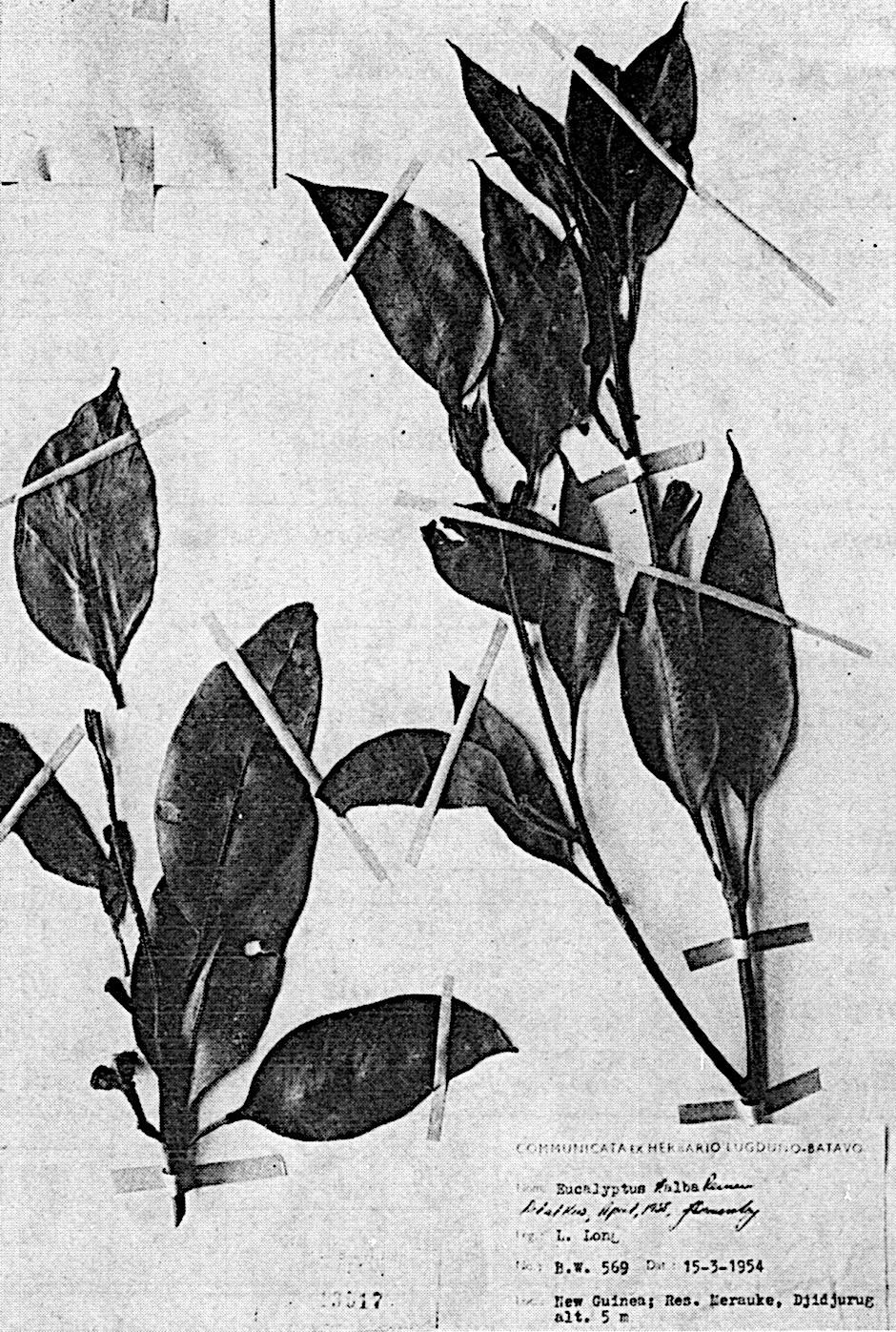
Aracruz Florestal S A at the time was a forest company responsible for the management of 85,000 hectares in northern Espirito Santo and southern Bahia states of Brazil. Many of the early plantings of Eucalyptus at Aracruz originated from Brazilian seed from hybrids of E. grandis, E. saligna and E.
“urophylla”. These plantings were extremely variable, had relatively low yields and high susceptibility to certain diseases. The yields averaged 22m3/ha/yr and 80% of the trees infected by a canker. Later plantings with seed from South Africa and Zimbabwe had somewhat higher yields and greater disease resistance, but production was still below Aracruz’s expectations.
The Company began research on vegetative propagation of eucalypts in 1974 as part of a tree improvement programme to increase yields and produce more homogenous planting stock. The Company learned of the work by Peter Burgess on vegetative propagation of E. grandis with APM at Coffs Harbour, Australia and my work on E. deglupta in PNG through the papers presented by us at Rotorua in 1973 and published in 1974. Edgard Campinhos, head of the Aracruz research team was despatched to Coffs Harbour and Bulolo in 1974 to meet both of us in turn face to face.
At Bulolo I showed Edgard the work on grafting, rejuvenation and growing cuttings of E. deglupta. He was provided with copies of several papers of mine on vegetative propagation including Tropical Forestry Research Note SR 8 that, among the methodology described, contained the circuit diagram for the “artificial leaf” that controlled the periodic operation of the mist sprays.10 I also showed him photographs of the clonal plantation I had established at Vudal in 1967/68 and revisited in 1970. The initial work by the Aracruz researchers was successful and by 1975 the first clonal material was planted in the field. In 1979 they made the first commercial planting of one million rooted cuttings. The Company supported the research work at the time by injecting nearly three million US dollars a year, almost 4% of recurrent expenditure.
Papua New Guinea Tropical Forestry Research Note series
This Research Note series started in June 1973 with the printing of a paper presented by me to Research Working Group No. 1 of the Research Committee of the Australian Forestry Council Meeting on Tree Improvement and Introduction. This was the Third Meeting of Representatives held at Mt Gambier, South Australia, 30 October to 3 November 1972. The reason for printing the paper in full as a research
10 When I visited Aracruz in 1980, I found they had built from scratch artificial leaf controllers by following that circuit diagram.
note SR. 1, with Neville Howcroft as co author, was because only a summary was included in Appendix 1 of the Proceedings of the Meeting at Mt Gambier.

Similarly, a paper on “Natural variation in Eucalyptus deglupta” and another on “A tree improvement programme for Eucalyptus deglupta” summarised as Appendices 22 and 23 in the Proceedings of the same RWG Meeting were printed in full as SR. 2 and SR. 3. Below is a list of Research Notes with me as author or co author that were printed from June 1973 through to the end of the year.
Davidson J and Howcroft NHS 1973 Papua New Guinea Tree Improvement and Introduction Progress Report 1972. Papua New Guinea Tropical Forestry Research Note SR. 1, Department of Forests, Boroko, PNG. 9 pp.
Davidson J 1973 Variation in Eucalyptus deglupta and its effect on choice of criteria for selection in a tree improvement programme. Papua New Guinea Tropical Forestry Research Note SR. 2, Department of Forests, Boroko, PNG. 9 pp.
Davidson J 1973 A tree improvement programme for Eucalyptus deglupta in Papua New Guinea. Papua New Guinea Tropical Forestry Research Note SR. 3, Department of Forests, Boroko, PNG. 5 pp.
Davidson J 1973 Improving production from Eucalyptus deglupta in the Territory of Papua New Guinea. Papua New Guinea Tropical Forestry Research Note SR. 5, Department of Forests, Boroko, PNG. 9 pp.
Davidson J 1973 Forest tree improvement Kamarere. Papua New Guinea Tropical Forestry Research Note SR. 6, Department of Forests, Boroko, PNG. 14 pp.
Davidson J 1973 A description of Eucalyptus deglupta. Papua New Guinea Tropical Forestry Research Note SR. 7, Department of Forests, Boroko, PNG. 10 pp.
Davidson J 1973 A technique for rooting seedling cuttings of Eucalyptus deglupta Blume Papua New Guinea Tropical Forestry Research Note SR. 8, Department of Forests, Boroko, PNG. 12 pp.
Davidson J 1973 Techniques of grafting Eucalyptus deglupta Blume. Papua New Guinea Tropical Forestry Research Note SR. 9, Department of Forests, Boroko, PNG. 15 pp.
Davidson J 1973 Some physiological aspects of rooting cuttings of Eucalyptus deglupta Blume. Papua New Guinea Tropical Forestry Research Note SR. 10, Department of Forests, Boroko, PNG. 20 pp.
Davidson J 1973 Incompatibility symptoms in grafts of Eucalyptus deglupta Blume. Papua New Guinea Tropical Forestry Research Note SR. 11, Department of Forests, Boroko, PNG. 10 pp.
Davidson J 1973 Conservation of the gene resources of tropical Eucalyptus deglupta. Papua New Guinea Tropical Forestry Research Note SR. 12, Department of Forests, Boroko, PNG. 10 + xi pp.
Davidson J and Fairlamb J 1973 Provenance trials of Eucalyptus deglupta in Papua New Guinea. Papua New Guinea Tropical Forestry Research Note SR. 17, Department of Forests, Boroko, PNG. 21 pp.
Davidson J 1973 Decay in living trees of Eucalyptus deglupta. Papua New Guinea Tropical Forestry Research Note SR. 18, Department of Forests, Boroko, PNG. 31 pp.
Assessment of E. deglupta provenance trial No 2, Keravat, New Britain in 1974 at age 2 years
The E. deglupta provenance trial No 2 at Keravat, New Britain established in 1972 was assessed just prior to thinning at age about 2 years. Wilelo provenance from New Britain (PNG seedlot no. 325) was the best for wood volume production. Philippines No. 1 (PNG seedlot 260, FRI Canberra combined seedlots nos S9291/9292) from Caliwan River, Davao del Norte Province and south of Bislig Bay, southern Surigao del Sur Province, Mindanao was second for wood volume production. There was a noticeable difference between the dark green foliage of the New Britain provenance and the slightly glaucous foliage and stems of the Philippines provenance. Third placed was Keravat (PNG seedlot 260, FRI Canberra seedlot S8861) and fourth placed Philippines 2 (PNG 281, FRI S9408 Milbuk, Cotabato Province). There was statistically no significant difference among the best four provenances.
Mindanao locations are shown at the time of the E. deglupta provenance seed collections were made. Modern day provincial boundaries and names in Mindanao are substantially different. Seed collection locations were: Philippines No. 2 (PNG 281, FRI S9408) Milbuk, Cotabato Province (location shown by * and numeral 1 on map); Philippines No. 1 (PNG seedlot 260, FRI Canberra combined seedlots Nos S9291/9292) from Caliwan River (a tributary of the Agusan River), Davao del Norte Province (* and 2) and south of Bislig Bay, southern Surigao del Sur Province (* and 3).

Next to worst was Mingende (PNG 206 to 209 combined, from 2,500 m altitude) and the worst was Raba Raba (PNG 346, FRI S8863). There was statistically no significant difference among the worst three provenances (Mingende, Raba Raba and Palopo, Southern Sulawesi, Indonesia (the latter PNG 265, FRI S9313).
However, there was a significant statistical difference between the top four provenances as a group and the bottom three provenances as a group.
E. deglupta provenance trial No 2, Keravat, New Britain in 1974 age about 2 years, before thinning. On the left is Wilelo provenance from New Britain (PNG seedlot no. 325), the best provenance for wood volume production. On the right is Philippines No. 1 (PNG seedlot 260, FRI Canberra seedlots nos S9291/9292) from Caliwan River and south of Bislig Bay, Mindanao, second for wood volume production. There was a noticeable difference between the dark green foliage of the New Britain provenance on the left and the slightly glaucous foliage and stems of the Philippines provenance on the right when grown sid by side
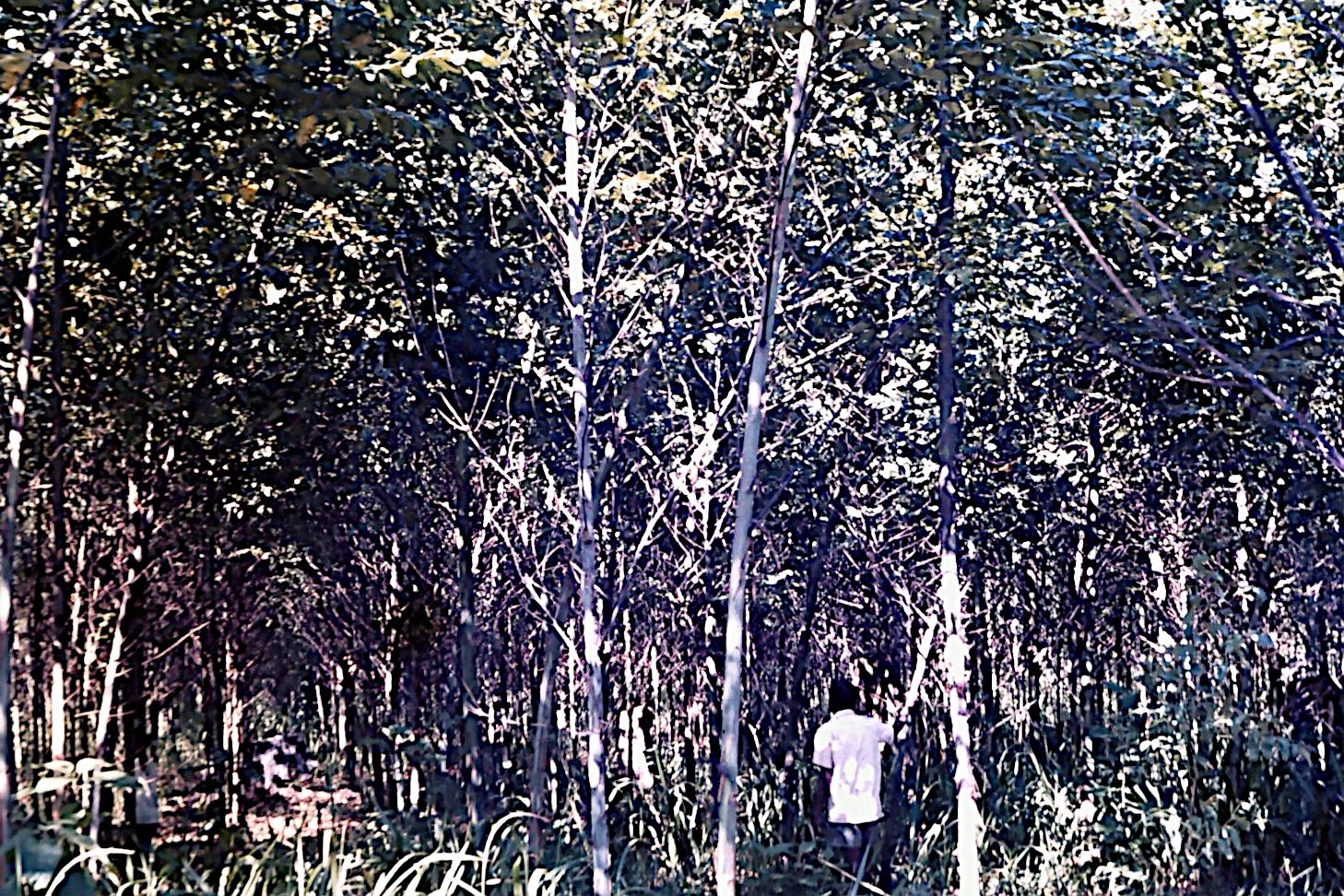
A comparison between third placed Keravat (PNG seedlot 260, FRI Canberra seedlot S8861) (left) and fourth placed Philippines 2 (PNG 281, FRI S9408 Milbuk, Cotabato Province) after thinning. In the background, on the left, was the next to worst Mingende (PNG 206 to 209), on the right the worst Raba Raba (PNG 346, FRI S8863). There was statistically no significant difference among the best four provenances.
The same E. deglupta provenance trial No 2, Keravat, New Britain in 1974, age about 2 years and un thinned. On the left is the next to worst Mingende provenance (PNG 206 to 209 combined, from 2,500 m altitude) and on the right the worst Raba Raba (PNG 346, FRI S8863). There was statistically no significant difference among the worst three provenances (these two and Palopo, Southern Sulawesi, Indonesia (PNG 265, FRI S9313).


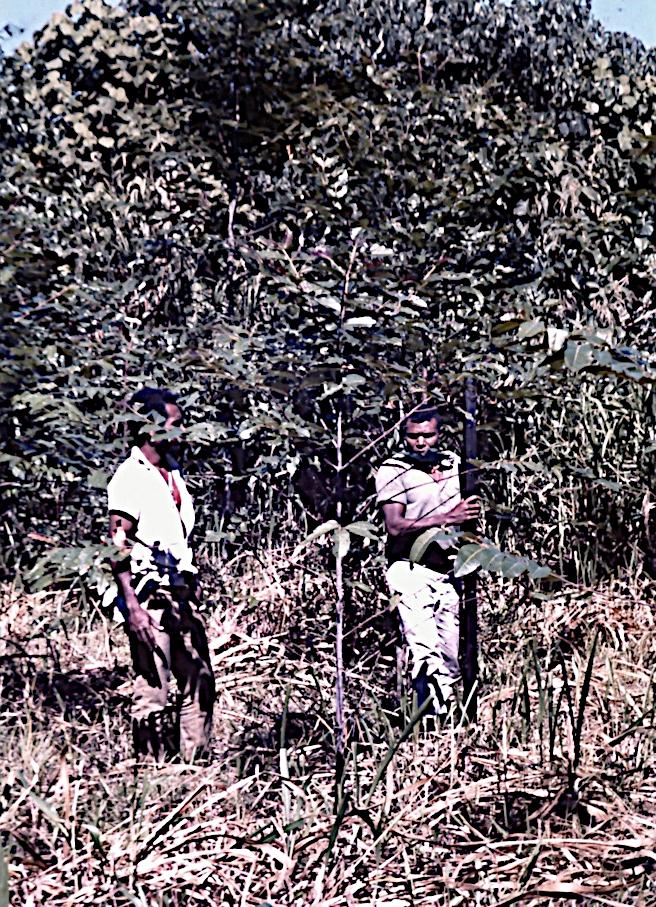
Second
provenance trial of E. “decaisneana” at Bulolo
John Turnbull, in February 1973, sent seven seedlots collected by him on Timor during the Turnbull, Cole and Pryor Forestry and Timber Bureau expedition during August 1971 to the Chief Research Officer, Department of Forests, PNG. Six were E. “decaisneana” and one E. alba. Also included were two seedlots (9003 and 9016) that had been included in the first trial in Bulolo to make a total of nine provenance locations (table below).
Seed lot no.* Species Quantity (ounce) Locality Latitude Longitude Altitude (feet) Soil Viable seeds/ounce 9016 (580) Euc. decaisneana ¼ Nr. Dili, Port. Timor 8° 39’ 125° 27’ 1,900 Schist 15,000 10140 (581) Euc. decaisneana ¼ Queorema, Port. Timor 8° 53.5’ 125° 35.5’ 6,800 Clay loam 10,200 10135 (579) Euc. decaisneana ¼ Aifefu, Port. Timor 8° 54’ 125° 36’ 5,100 Yellow clay 7,400 10146 (577) Euc. decaisneana ¼ Taco Lulic Port. Timor 8° 42’ 125° 27’ 2,650 Clay clay loam 5,400 10139 (576) Euc. decaisneana ¼ Mt. Tatamailau, Timor
8° 55’ 125° 30.5’ 8,100 Brown loam 12,800 10144 (575) Euc. decaisneana ¼ N. Aileu, Port. Timor 8° 38’ 125° 36’ 4,000 Clay loam 19,300 9003 (582) Euc. decaisneana ¼ Nr. Dili, Port. Timor 8° 47’ 125° 25’ 3,600 Schist 6,500 10136 (578) Euc. decaisneana ¼ Mt. Tatamailau, Timor
8° 55’ 125° 30’ 9,000 Clay loam 25,300 10141 (574) Euc. alba 1 NE Same, Port. Timor 9° 00’ 125° 41’ 1,250 Clay loam 1,700
* 9xxx and 10xxx numbers were Forest Research Institute, Canberra seed lot numbers; numbers in brackets were the Department of Forests PNG seed batch numbers assigned at HQ. One ounce = 28.35 g. 100 feet = 30.5 m.
Additional data were provided for some of the seedlots, all collected under the supervision of John Turnbull: 10135: Date collected: 14 August 1971, Locality: Aifefu, 15.1 km south of Maubisse on the road to Same, Portuguese Timor, Slope: Southwest, steep, Association: Pure E. “decaisneana”, small stand of coppice origin, no E. alba in the area, Soil: Yellow, brown clay over a hard, whitish rock (limestone?), pH 5.5, Altitude: 1,554 m, Nearest meteorological station: Maubisse (altitude 1,432 m), Average daily maximum temperature, warmest month 30.0°C, Average daily minimum temperature, coldest month 11.9°C, Lowest recorded 5.5°C, nil frost, Precipitation: Annual 1,438 mm, Monthly J 186, F 233, M 167, A 184, M 115, J 65, J 36, A 18, S 20, O 29, N 137, D 245 mm, Evaporation: Annual 1,034 mm, Nine trees in lot: JT181, voucher specimen with foliage buds capsules, H 45`, DBH 6``, straight slightly sinuous, fibrous bark to ¾``; JT182, voucher specimen with foliage buds capsules, H 40`, DBH 5``, crooked butt, then straight, all primary branches decorticating; JT183, voucher specimen with foliage buds, H 36`, DBH 5``, bark rough to 1`` branches; JT184, no voucher specimen, H 38`, DBH 6``, slightly sinuous, thick fibrous bark, flaky and scaly above 2`` branches; JT185, voucher specimen with foliage buds capsules, H 40`, DBH 5``, one stem crook, rough bark to 1`` branches; JT186, voucher specimen with foliage, capsules, H 40`, DBH 5``, crook at 5`, otherwise straight; JT187, voucher specimen with foliage buds capsules, H 45`, DBH 8``, slightly sinuous, thick fibrous bark at the base, scaly near top of tree, only branches less than 2`` smooth; JT188, no voucher specimen, H 36`, DBH 5``, fibrous bark at base, rough and scaly to ½``; JT189, voucher specimen with foliage buds capsules, H 42`, DBH 7``, straight stem.
10136: Date collected: 15 16 August 1971, Locality: Near the summit of Mount Tatamailau, 2 km from Hato Builico, Portuguese Timor; Slope: West, slight, undulating, Association: Pure E. “decaisneana”, the high mountain form with large capsules, thick leaves, ¼ ½ barked trunks (to 12 15`) with upper bark scaly to smooth decorticating in strips higher up the
trunk, Soil: Yellow brown loam clay loam over metamorphosed sedimentary rock with some volcanic intrusions, pH 6, Altitude 2,743 m, Nearest meteorological station: Hato Builico (see 10140), Ten trees in lot: JT190, voucher specimen with foliage buds capsules, H 45`, DBH 18``, trunk contorted, bark scaly to smooth at base becoming smooth and decorticating in strips above; JT191, five trees similar to JT 190, H 40 50`, DBH 12 20``; JT192, no voucher specimen, H 40`, DBH 18``, poor form, low fork, 6 ft of scaly bark, smooth above; JT 193, voucher specimen with foliage buds capsules, H 50`, DBH 15``, contorted with wide spreading crown, rough bark to 5 ft; JT194, voucher specimen with foliage buds capsules, H 50`, DNH 18``, spreading crown, lowest branch 8 ft, bark scaly flaky to 5 ft then smooth and decorticating in strips; JT195, voucher specimen with foliage buds capsules, H 50`, DBH 19``, straight for 18 ft, then broken crown, smooth bark from 6 ft.
10140: Date collected: 18 20 August 1971, Locality: Queorema 9.5 k east of Hato Builico on the road to Maubisse, Portuguese Timor; Slope: East, steep, Association: Pure E. “decaisneana”, majority of trees with rough bark to the very smallest branches (½``), the form of the trees particularly the regeneration very good, trees of H 150`and DBH 36`` in the area, Soil: Yellow brown clay loam over shale, pH 5.5, Altitude: 2,073 m, Nearest meteorological station: Hato Builico (altitude 1,890 m) Average daily maximum temperature, warmest month 20.7°C, Average daily minimum temperature, coldest month 8.6°C, Lowest recorded 3°C, occasional frosts, Precipitation: Annual 1,947 mm, Monthly J 356, F 384, M 249, A 212, M 150, J 77, J 22, A 18, S 10, O 25, N 135, D 309 mm, Evaporation: Annual 789 mm, Seven trees in lot: JT199, seedlots from seven trees H 40 80`, form average to good, all with rough bark to small branches; JT 200, voucher specimen with foliage buds capsules representing the seven seed trees, H 60`, DBH 24``, forked at 35`, one of the seven trees in JT199.
10144: Date collected: 26 August 1971, Locality: 18.4 km north of Aileu on the road to Dili, Portuguese Timor; Slope: West, steep, Association: Pure E. “decaisneana” but a few E. alba in the area, this association is in the north coastal mountain fog belt, in this locality there was a mixture of half and full barked trees, Soil: Yellow brown clay of clay loam, Altitude: 1,219 m, Nearest meteorological station: Remexio (no data). JT207, voucher specimen with foliage buds capsules, H 45`, DBH 7``, half barked tree, straight bole but forked in the crown; JT208, voucher specimen with foliage buds capsules, H 60`, DBH 12``, full barked tree (to 2`` limbs), straight, well formed; JT209, no voucher specimen, H 50`, DBH 8``, straight, half barked tree.
10146: Date collected: 28 August 1971, Locality: 1.7 km east of Dili Ermera Road, on the road to Aileu Taco Lulic, Portuguese Timor; Slope: Southwest, steep, Association: E. alba E. “decaisneana” occurred only in the gullies and sheltered sites, Soil: Red brown clay to clay loam, Altitude: 808 m, Nearest meteorological station: Dare (altitude 492 m), Average daily maximum temperature, warmest month 28.5°C, Average daily minimum temperature, coldest month 19.6°C, Lowest recorded 14°C, nil frosts, Precipitation: Annual 1,644 mm, Monthly J 284, F 302, M 242, A 149, M 74, J 90, J 51, A 27, S 11, O 22, N 120, D 263 mm. JT213, voucher specimen with foliage capsules, H 40`, DBH 10``, forked low but may have been the result of lopping for firewood.
Jeff Fairlamb fumigated soil for the seed trays with methyl bromide under a plastic sheet11 on 8 July 1974. After three days were allowed for the soil to re aerate, four grams of each seed batch (15 grams for E. alba) were sown after dusting with Ceresan12 on 11 July 1974.
Germination started on 16 July. By 18 July the cotyledons of the E. alba were noted to be about twice the size of the E. “decaisneana” ones. Tubing commenced with E. alba 574 on 7 August 1974.
A second round of germination in 10 trays (two of E. alba ) was started with sowing on 26 August. Tubing these started from the end of September 1974. I prepared a balanced lattice design of four replications of the nine provenances, each replication in three blocks. Plot size was to be square, with 6
11 Methyl bromide (Bromomethane CH3Br) was a highly toxic, colourless, odourless gas used in a wide range of fumigation uses on soils, timber and other products, especially for quarantine purposes. The user needed to don a full facemask with special filter canister, rubber gloves and protective clothing to fumigate soil covered by a plastic sheet in the open air. It was banned for most fumigation uses from 1989 under the UN Montreal Protocol because it depletes the atmospheric ozone layer.
12Ceresan, an ethyl mercury fungicide (C15H17HgNO2S), back then was widely used as a dry seed fungicide treatment, and much later implicated as a carcinogen in humans and animals.
x 6 = 36 trees and with the inner net measured plot of 4 x 4 = 16 trees, all at 2 x 2 m spacing. After allowing for the requirement for a Bulolo trial it was expected there would be enough stock (except 579 and 576) to send to Madang to establish a second trial at Gogol.
From the 18 November 1974 I started my secondment to the University of Technology in Lae as Acting Head of the new Department of Forest Science in the School of Natural Resources.13
When I returned to my former position as Officer in Charge, Forest Research Station, Bulolo in mid August 1975, I found that the Bulolo trial had been destroyed by fire soon after its establishment in grassland at Geshes. Jeff Fairlamb had left the Department and the stock destined for Madang had not been sent, but had been potted up into larger plastic bags and held in the Bulolo high shade nursery area (photograph at left).
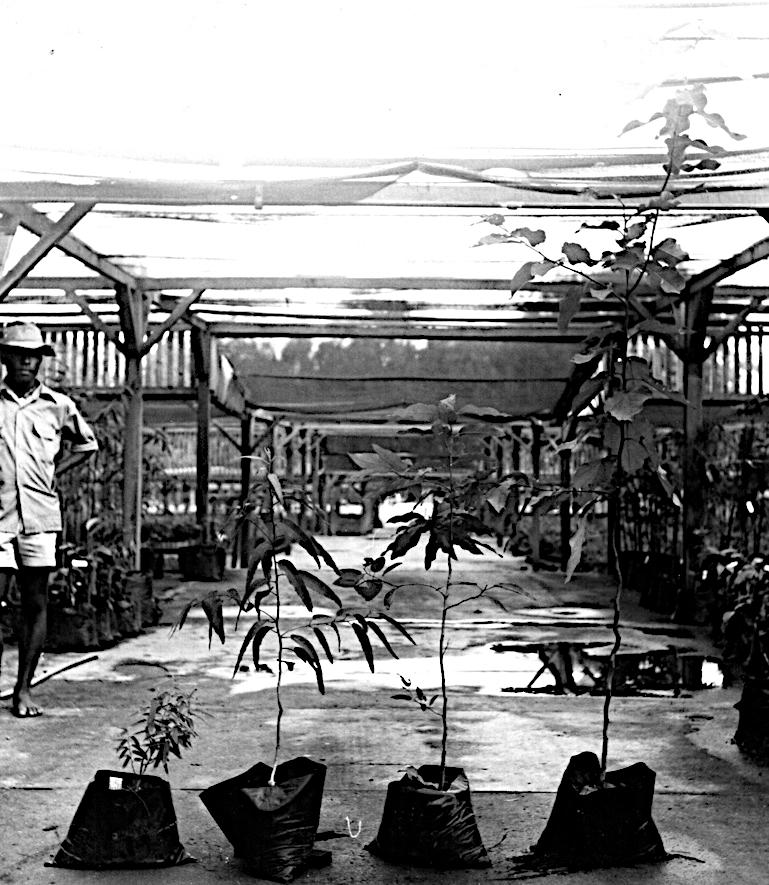
Examples of representative advanced seedlings at the same age from the second E. “decaisneana” provenance trial set out in the Bulolo high shade nursery in November 1975. Left: The worst was provenance 578/10136 from near the summit of Mount Tatamailau, 2 km from Hato Builico, Portuguese Timor at 2,743 m. Second from left: Marginally second best was 575/10144 from north of Aileu, Portuguese Timor at 1,219 m altitude (note long leaves and the lignotuber just visible above the bag). Third from left: Marginally the best provenance was 580/9016 from north of Aileu on the road to Dili, Portuguese Timor at 580 m. On the right was one of the vigourous hybrids of E. alba♀ x E. “decaisneana”♂ from within the E. alba 574/10141 provenance seedlot
From what I could learn, marginally the best provenance was 580/9016 from north of Aileu on the road to Dili, Portuguese Timor at 580 m, which was also the best provenance in the first trial. Marginally second best, was 575/10144 from north of Aileu, Portuguese Timor at 1,219 m altitude. The worst was 578/10136 from near the summit of Mount Tatamailau, 2 km from Hato Builico, Portuguese Timor at 2,743 m. All of the provenances developed lignotubers, the size and speed of development of which closely followed the ranking by growth.
The occurrence of a few vigourous natural hybrids of E. alba♀ x E. “decaisneana”♂ with large lignotubers in the E. alba 574/10141 provenance seedlot from northeast of Same, Portuguese Timor at
13 Soon after renamed the Department of Forestry in the Faculty of Natural Resources.
380 m was particularly significant. Lignotuberous eucalypt species are good and reliable coppicing species. The prospect of creating a fast growing, reliably coppicing hybrid such as E. deglupta♀ x (E. alba♀ x E. “decaisneana”♂) with clonal selection and mass propagation of elite clones by cuttings was exciting for me at the time but was not able to be realised as I relinquished my post as Officer in Charge of the Forest Research Station and left Bulolo for the final time for Lae in December 1975 to take up the post of Head of the Department of Forestry at the Papua New Guinea University of Technology.14
July Oct 1974: Vegetative propagation of epicormic and coppice shoots of E. deglupta
For vegetative propagation of epicormic and coppice shoots of E. deglupta to be useful, reliable methods of predicting or alternatively inducing the occurrence of these types of shoots, were required. As there appeared to be no easy objective method of predicting epicormic or coppice growth, means of artificial stimulation were trialed.
General control on the development of buds in plants was known at the time to be exercised by hormones (otherwise known as “growth substances”). There may have been two or more substances involved but for convenience they usually were known by the single term, “auxin”. Auxin was produced in the leaves and buds of trees, and translocated within them to other locations. A minute quantity of auxin was known to have a profound effect on living plant tissues and its action in eucalypts was particularly significant. Auxin inhibited the development of the dormant bud strands preventing the growth of epicormic shoots while the crown and translocation system of the tree remained intact. Hormones were also known to move in response to gravity and light.15
Therefore, some possible methods of induction of epicormics in E. deglupta were:
(a) Ring barking or frilling of the stem (to prevent the flow of bud inhibiting hormone from the crown allowing dormant buds to develop),
(b) Bending the stem to horizontal (gravity would cause a reduction in the concentration of bud inhibiting hormone on the top side of the stem and allow the dormant buds there to develop),
(c) Thinning of nearest neighbour trees (increased light on one side of the stem would cause the auxin concentration to be lowered, thus allowing the dormant buds to develop on that side),
14 At the time this was a unique and unusual appointment, strongly supported by the then Director of Forests J Auna, to continue to assist in the development of the new forestry degree course at the University. I had successfully applied for and been confirmed in the post of Foundation Chairman and Professor of Forestry in November 1975, but continued on secondment from the PNG Public Service as a Forest Officer Class 4 from December 1975 until 16 June 1976, with my Forest Officer Class 4 salary topped up to Head of Department level by the University. I left the PNG Public Service with the full benefits of the Employment Security Scheme and moved wholly onto a University Professorial contract from 16 June 1976.
15 A reference much consulted at the time was: Curtis O F and Clark D G 1950 An Introduction to Plant Physiology, McGraw Hill and I also had the benefit of what I had learnt about plant hormones in my science botany major at the UNE.
(d) A combination of (a) with addition of chemical hormones to further stimulate shoot development.
A stand of E. deglupta (2 ha) growing in a plantation sixteen years of age at Keravat was selected and thinned from 250 stems per hectare (sph) down to 100 sph leaving the dominants. Ten trees were chosen randomly and marked as controls. Thirty randomly chosen trees were frilled using an injecting axe (left) while applying three different treatments.
The ten control trees were injected with distilled water (about 10 ml per tree), ten were injected with about 10 ml of a solution containing 50 parts per million (ppm) of indole 3 acetic acid and the remaining ten with about 10 ml of 30 ppm gibberellic acid. All frills were made on only half of the bole circumference, on the sunny side and within 0.5 m of the ground. The cuts penetrated at least 2 cm into the wood.
Staff at Keravat, K D Romijn (OIC Keravat) and Owen Poate (Acting OIC Keravat), monitored the trial from July through to October 1974.
Most of the frilled trees developed swellings above and below the cut and a wrinkled appearance to the bark adjacent to the swellings. Of the frilled trees, the number producing epicormics below the frill after four months were:
Gibberellic acid: 2 out of 10
Indole 3 acetic acid: 5 out of 10
Water (control): 4 out of 10
An epicormic shoot developed between the frill and the ground on a tree treated with indole 3 acetic acid.
Two of the controls produced epicormic shoots on the bole up to two metres above the ground, probably as a result of the opening up of the stand. The same reason may be why four of the controls produced epicormic shoots.
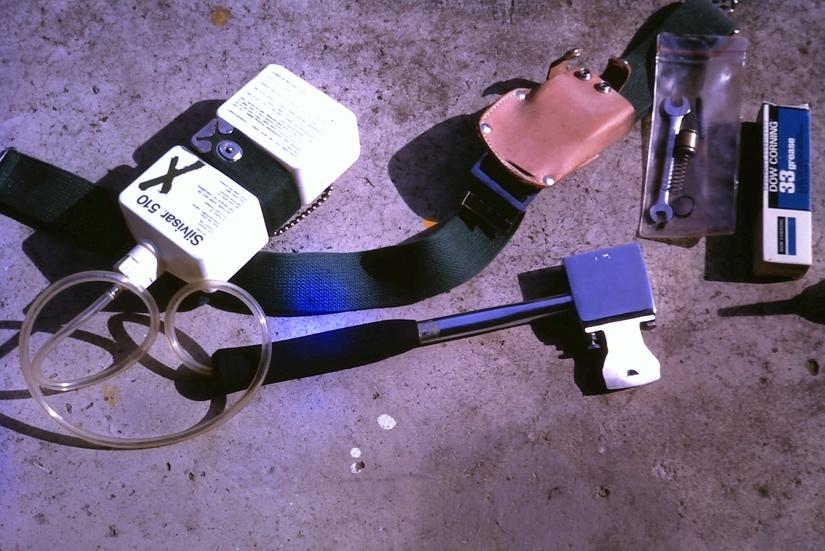
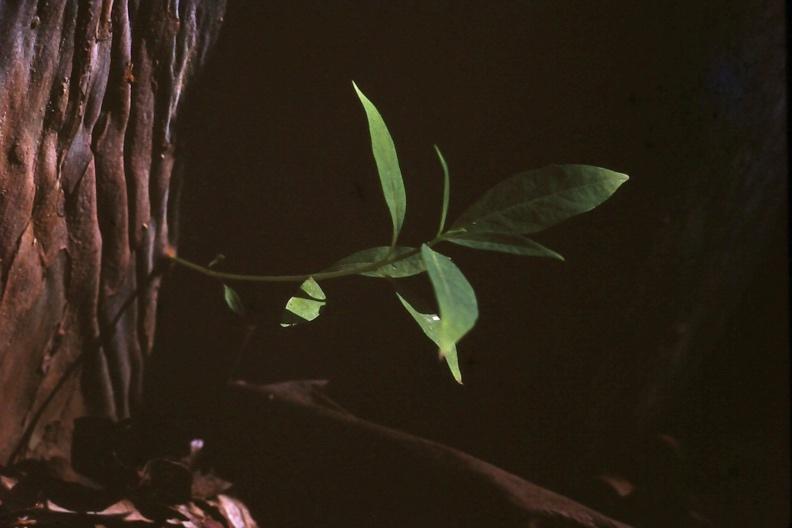
In the same stand stumps left by the thinning were used to trial the induction of coppice on cut stumps. Twenty stumps (10 each) were treated with the two hormones in the same quantities and concentrations used in the frilling trial. The solution was brushed on the bark, cambial zone and the outer sapwood of the stump, using a new brush for each treatment. The entire cut surface was then smeared with a thin coat of grafting mastic. The remaining untreated stumps served as controls. Stump height varied from 10 to 30 cm.
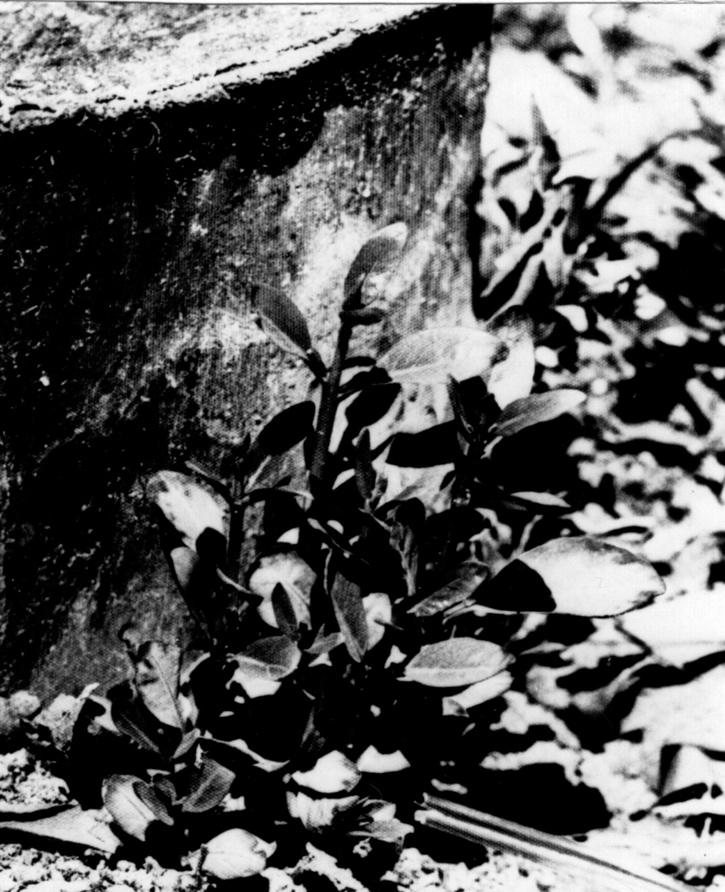
All the treated stumps retained living bark for at least two weeks while the controls quickly dried out, the bark separating from the wood above ground level. Of the treated stumps only two each in the indole 3 acetic acid and gibberellic acid treatments produced coppice shoots. The types of shoots produced from the treated stumps are illustrated. These shoots grew profusely for the first few weeks then some began to die off because of competition.

Left: A group of coppice shoots arising from the one “epicormic knob” 15 cm above ground level.
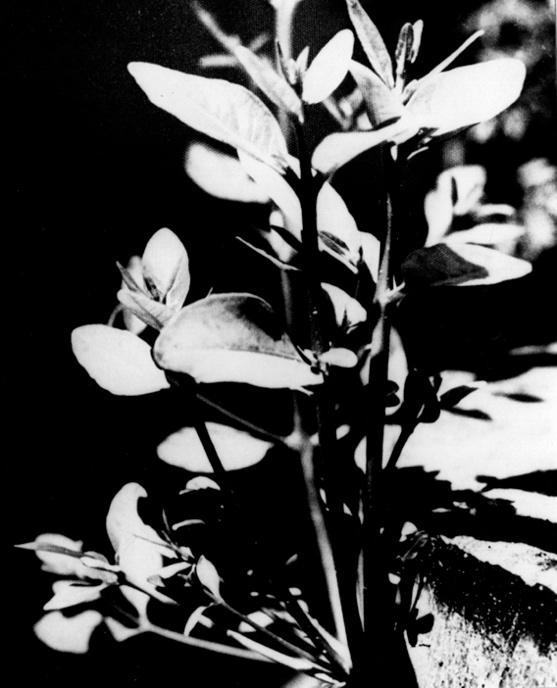
Right: Profuse growth of coppice shoots after one month on a stump treated with indole 3 acetic acid. After a few weeks some of these shoots begin to die off because of the effects of competition.
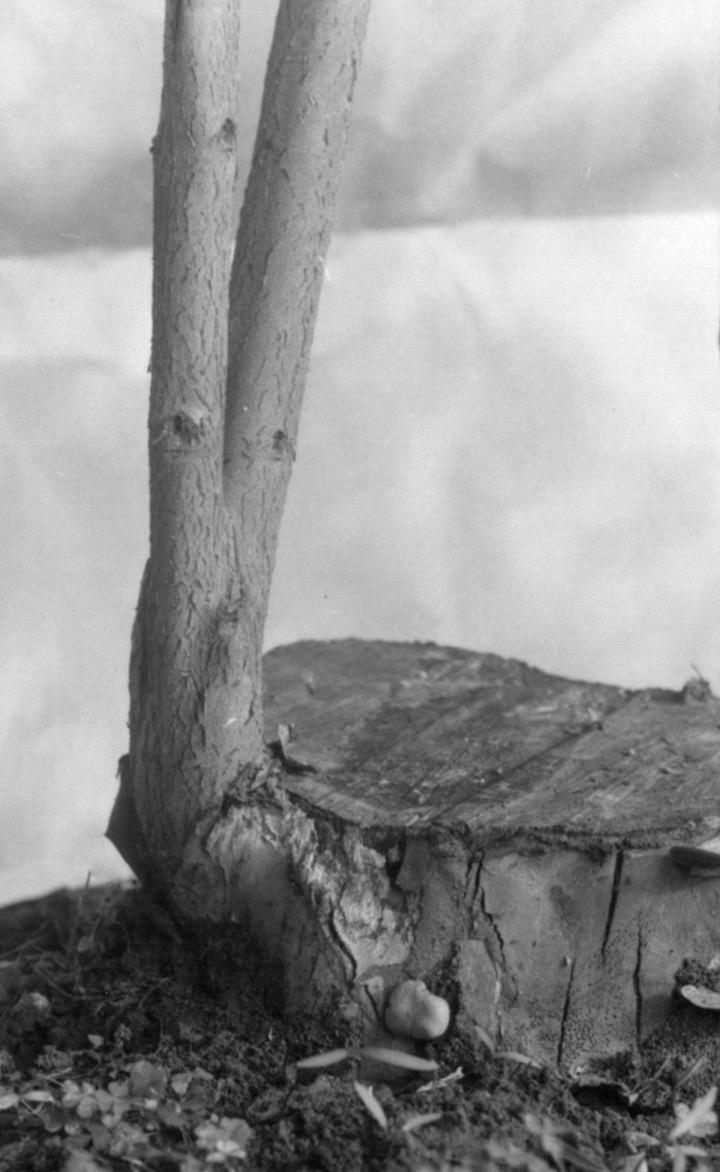
After four months of growth some of the induced coppice shoots had reached a height of more than three metres (left).
The area of attachment of these large shoots was relatively minute for their size. Also, wood rotting fungi attacked the stumps.
In the tree improvement programme for E. deglupta, the establishment of clonal seed orchards has been carried out using scions taken from the upper crowns of selected trees 15 25 years of age (50 60 m tall) grafted on to seedling rootstocks.
Disadvantages of this method include: i) Scions need to be collected by shooting with a rifle, as trees of E. deglupta, at the age of selection, are too tall to climb safely.

ii) There is a risk of graft incompatibility when using “foreign” root stocks.
iii) Grafting is a time consuming, labour intensive activity.
iv) A large area of nursery space is required for growing vigourous stocks in large pots to a size suitable for grafting (1.5 m tall) and to store grafted plants until they are ready for the field (in 6 9 months).
The method of frilling described gave some promise for stimulating the growth of epicormic on trees selected for inclusion in a tree improvement programme. Provided only half or less of the circumference of the lower bole was frilled, the technique was non destructive. Shoots could be collected after a few weeks and propagated as cuttings. Once an epicormic knob was formed several crops of shoots could be harvested from it. There was evidence that treatment with hormones would further stimulate the development of shoots.
Many of the disadvantages of grafting mentioned elsewhere were removed because:
i) All work could be carried out quickly at ground level with little labour and materials.
ii) Cuttings were simple to harvest and prepare, required little attention and only a small amount of nursery space.
iii) Cuttings grow their own roots, so issues with scion stock incompatibility do not arise.
The treatment of cut stumps to induce coppice would lead to the same end result except that the felling of the tree potentially ends its life, whereas the frilling treatment on half or less of the circumference of the trunk usually allows the tree to go on living.
At the time, these techniques were not considered to have any potential for enabling plantations of E. deglupta to be grown on a commercial coppice regeneration system over several rotations as the growth of the coppice shoots, even with hormone treatment, was too unreliable. The coppice was rarely firmly attached and under the ever wet tropical lowlands weather conditions fungi invaded the stump before the cut surface was occluded.
In addition, it was considered too risky to frill the selected elite trees, as they were too valuable to lose. Therefore, collection of half sib seed and scions for grafting remained the available options for propagation of mature elite trees of E. deglupta.
Bole shape of E. deglupta
After a database comprising detailed sectional measurements from some 800 trees had been compiled, it was possible to divide the data to study separately the effects of any change in the bole shape on the computation of stand volume tables. Genetic (provenance), environmental (site quality, silvicultural and management practices) and developmental (age and size) effects could be studied on the partitioned data.
If one could determine the shape and rate of taper of a stem, or that part of it of interest, one could derive its volume readily by multiplying the product of the height and sectional area of the base by some factor which would reduce the volume of the cylinder, implied by the product of height and sectional area at the base, to that of the appropriate solid to which the stem is approximated.
The volume (V) of an appropriate cylinder is given by V = π(D/2)2H where D = diameter at the base of the cylinder and H = height of the cylinder or V = (π/4)D2H ………. (1)
A similar equation is, having the form V = fD2H ………..….. (2) Where D and H are as given above.
When the factor f in equation 2 incorporates π/4 plus a term for the reduction of the cylinder to the prescribed bole volume it is called a “form factor”. The concept of form factors is a very old one. Some early tree volume tables included an expression of form factor that was assumed appropriate for a particular species.
The form factor was used as a guide to the requirements for volume tables for E. deglupta in PNG. In this sense it was an abstract variable. The form factor was not measured directly on trees but was derived as a regression coefficient relating both diameter at breast height (D) and total height (H) to total volume (V).
Equations showing volume as a function of diameter squared and height were derived by selecting appropriate sums of squares from cross product matrices and solving the least square equations.
Provenances
Sample trees were available from two trials in PNG each of eight provenances: Keravat, Wilelo, Raba Raba, Mingende and Mt Hagen from PNG, two from Mindanao Philippines and one from Celebes Indonesia.16 Form factors in descending order for each provenance are shown in the following table, as are sample sizes and multiple correlation coefficients of the regressions. For trees having the same D and H values, those from Raba Raba provenance are of a shape that takes up a greater proportion of a cylinder of the same basic dimensions than does the Wilelo provenance. In other words, the middle and upper stem of Raba Raba is “fatter” than the others listed below it.
VOLUME REGRESSIONS AND FORM FACTORS FOR TREES OF E. DEGLUPTA OF EIGHT PROVENANCES GROWN AT TWO SITES
+ (KERAVAT AND BAKU) IN PAPUA NEW GUINEA
Provenances
Volume Regression# Form Factor (X10 5)* No. of Trees Sampled
Multiple Correlation Coefficient
1. Raba Raba
V=3.988X10 5D2H 3.988 (0.51) 21 0.988
2. Mingende V=3.815X10 5D2H 3.815 (0.49) 15 0.988
3. Keravat V=3.813X10 5D2H 3.813 (0.49) 32 0.994
4. Philippines (1) V=3.812X10 5D2H 3.812 (0.49) 54 0.997
5. Celebes V=3.751X10 5D2H 3.751 (0.48) 30 0.993
6. Mt. Hagen V=3.745X10 5D2H 3.745 (0.48) 50 0.989
7. Philippines (2) V=3.701X10 5D2H 3.701 (0.47) 52 0.995
8. Wilelo V=3.595X10 5D2H 3.595 (0.46) 28 0.986
+ Spacing was the same (2.5 x 2.5 m) at both sites and trees were of equal age, however site quality was not strictly comparable. # V = total volume in cubic metres, D = diameter at breast height in centimetres, H = total height in metres. * The figures in brackets exclude a constant value of 0.785 x 10 4 derived from the term π/4 and the conversion of square centimetres to square metres for D2
Initial spacing or initial stocking
Data for trees of approximately the same age, planted at five different initial spacings on several sites were available. Volume regressions, form factors and other information are in the table on the following page 16
It is clear the form factors rise with increasing spacing among trees in stands of this age (3 years). The rate of rise is greater at closer spacings where lateral competition is more intense. At wider spacings where competition among trees is less the rate of rise is slower.
VOLUME REGRESSIONS AND FORM FACTORS FOR TREES OF E. DEGLUPTA PLANTED AT FIVE INITIAL SPACINGS AT SEVERAL SITES+ IN PAPUA NEW GUINEA
Initial Spacing (mxm)
2 x 2
2.5 x 2.5
3 x 3
4 x 4
5 x 5
Volume Regression# Form Factor (X10 5)*
No. of Trees Sampled
Multiple Correlation Coefficient
V=3.596X10 5D2H 3.596 (0.46) 46 0.995
V=3.715X10 5D2H 3.715 (0.47) 32 0.997
V=3.731X10 5D2H 3.731 (0.49) 22 0.996
V=3.770X10 5D2H 3.770 (0.49) 48 0.994
V=3.816X10 5D2H 3.816 (0.48) 50 0.990
+ Sites were all on well drained terraces which formerly supported natural stands of E. deglupta but data for close comparison of sites were lacking. # V = total volume in cubic metres, D = diameter at breast height in centimetres, H = total height in metres * The figures in brackets exclude a constant value of 0.785 x 10 4 derived from the term π/4 and the conversion of square centimetres to square metres for D2 .
Site quality
E. deglupta is very responsive to differences in site quality. Four site quality classes were distinguished on the basis of mean stand height at age ten years. Sampled trees were assessed in three overlapping site quality categories (classes 1 2, 2 3 and 3 4). Site quality 1 included the best sites available for E. deglupta, while site quality 4 produced very poor growth.17
The volume regressions for each of the three categories are given in the table on the following page From the limited data available there appeared to be only a slightly reduced form factor on the poorer site class. That is the trees are slightly slimmer on the poorer site quality.
17
For example, see Davidson J 1973 Decayed wood in living trees of Eucalyptus deglupta Blume. Proceedings of IUFRO 5 Meeting, South Africa, pp 208 224, and table of yields on different quality sites presented earlier.
VOLUME REGRESSIONS AND FORM FACTORS FOR TREES OF E. DEGLUPTA GROWING ON THREE DIFFERENT SITE QUALITIES+ IN PAPUA NEW GUINEA
Site Quality Class Volume Regression# Form Factor (X10 5)*
1 2
No. of Trees Sampled
Multiple Correlation Coefficient
V=3.715X10 5D2H 3.715 (0.47) 161 0.995
2 3 V=3.738X10 5D2H 3.738 (0.48) 46 0.996
3 4 V=3.514X10 5D2H 3.514 (0.45) 56 0.997
+ Spacing and age of the trees were approximately the same at each site. # V = total volume in cubic metres, D = diameter at breast height in centimetres, H = total height in metres. * The figures in brackets exclude a constant value of 0.785 x 10 4 derived from the term π/4 and the conversion of square centimetres to square metres for D2 .
Tree age and average size
Data were available for segregation into three age classes (1 5, 6 10 and11 20 years) growing on similar sites. These age class ranges were selected arbitrarily to obtain sufficient data from comparable sites.
The volume regressions for each of the three age classes are given in the table below. There are considerable differences in the form factors across the age classes.
VOLUME REGRESSIONS AND FORM FACTORS FOR SAMPLE STANDS OF E. DEGLUPTA IN THREE DIFFERENT AGE CLASSES+
1 5 V=3.813X10 5D2H 3.813 (0.49) 32 0.994 6 10 V=3.632X10 5D2H 3.632 (0.46) 100 0.988 11 20 V=3.090X10 5D2H 3.090 (0.39) 227 0.993
+ Spacing was approximately similar. The sites were on well drained terrace soils consisting of pumice and pumice alluvia. # V = total volume in cubic metres, D = diameter at breast height in centimetres, H = total height in metres. * The figures in brackets exclude a constant value of 0.785 x 10 4 derived from the term π/4 and the conversion of square centimetres to square metres for D2 .
By extrapolation, there are considerable differences in the form factors for diameter and height size classes also. The form factor for large (older) trees is quite low (3.090) when compared with that for small trees (very young) (3.813).)
Practical implications of bole shape
The form factor for E. deglupta was found to vary from about 0.7 x 10 5 units for age/size effects, through 0.4 x 10 5 units for provenance effects, to only 0.2 x 10 5 units for site and stocking rate effects. What this magnitude of variation in form factor means can be determined by looking at one of the graphs and the table below.
INCREASE IN VOLUME (M3) PER TREE FOR TREES OF VARIOUS SIZE CLASSES FOR EACH 0.1X10 5 UNIT INCREASE IN FORM FACTOR
Height Classes (m) Diameter Classes (cm) 5 10 15 20 25 30 35 5 0.001 0.005 0.011 0.020 0.031 0.045 0.061 10 0.002 0.010 0.022 0.040 0.062 0.090 0.122 25 0.005 0.025 0.055 0.100 0.155 0.225 0.305 50 0.010 0.050 0.110 0.200 0.310 0.450 0.610
For trees having an average diameter at breast height of 30 cm and an average height of 50 m, the total volume varies linearly, increasing at an average rate of 0.45 cu m for each 0.1 x 10 5 unit increase in form factor. A form factor of 3.0 x 10 5 represents about 40 percent of the true cylindrical volume (based on sectional area at breast height and total tree height) occupied by the tree bole, while a form factor of 4.0 x 10 5 represents about 50 percent. This means each 0.1 x 10 5 unit change in form factor represents about 1 percent of the volume of a cylinder of the dimensions equivalent to sectional area at breast height and total height in trees of E. deglupta.
If this reasoning was extended to estimation of volume across various size classes, considerable variation in estimation of volume per tree would occur, especially in the larger size classes (see graphs below). Further, when volume per hectare is estimated from the number of trees present per unit area, the variation is greatly magnified, especially at high stocking rates.
Effective plantation management requires a reliable volume table as a base from which yield and economic criteria can be derived. A volume table is only reliable if it is fit for the purpose for which the particular stand being investigated. The results of these studies indicated that a single volume table might not meet the requirements of all the silvicultural and management situations in which E. deglupta would be grown in PNG.
The variation in tree shape among provenances takes on less significance when it is realized that only one or two of the best provenances would be grown on a large scale. The better provenances have form factors in the narrow range 3.7 3.8 x 10 5. However, when volumes of trees within provenance tests say more than five years old are required, a separate volume table for each provenance would need to be derived and used.
Only a single average initial spacing would likely be used in plantation establishment for a planned particular end use such as for short rotation pulpwood. This would circumvent the differences in shape found among trees of grown from different initial spacing/stocking rates and only one volume table would suffice. Nevertheless, for accurate determination of volume production in spacing research trials individual tables would need to be derived for each spacing/stocking.
It is also expected E. deglupta would be planted always on sites suitable for a good growth rate, i.e., site qualities 1 3. The form factor does not vary much over that range of site quality. For fertilizer trials it would be necessary to consider separate volume tables for each treatment, since the trees are likely to be of a different shape in each treatment depending on their growth rate response.
In conclusion it was stressed again that volume tables for E. deglupta must not be haphazardly constructed and indiscriminately used. Because the shape of trees was found to vary with genetic (provenance), environmental (site quality, silvicultural and management practices) and developmental (age and size) effects, each situation has to be considered carefully before a particular volume table is applied.
It is interesting that for, E. deglupta, Lane Poole in 1925 estimated a form factor or taper of 0.518, and Heather in 1955 a form factor of 0.419 for the merchantable bole of large trees of E. deglupta based on limited data. In Indonesia a form factor of 0.56 is often applied in the absence of any precise information on stand composition.
18 Page 55 In Lane Poole C E 1925 Forest Resources of the Territories of Papua and New Guinea. Government Printer, Melbourne. 209 pp.
19 Page 277 In Heather W A 1955 The Kamarere Forests of New Britain. The Empire Forestry Review, 34:255 278.

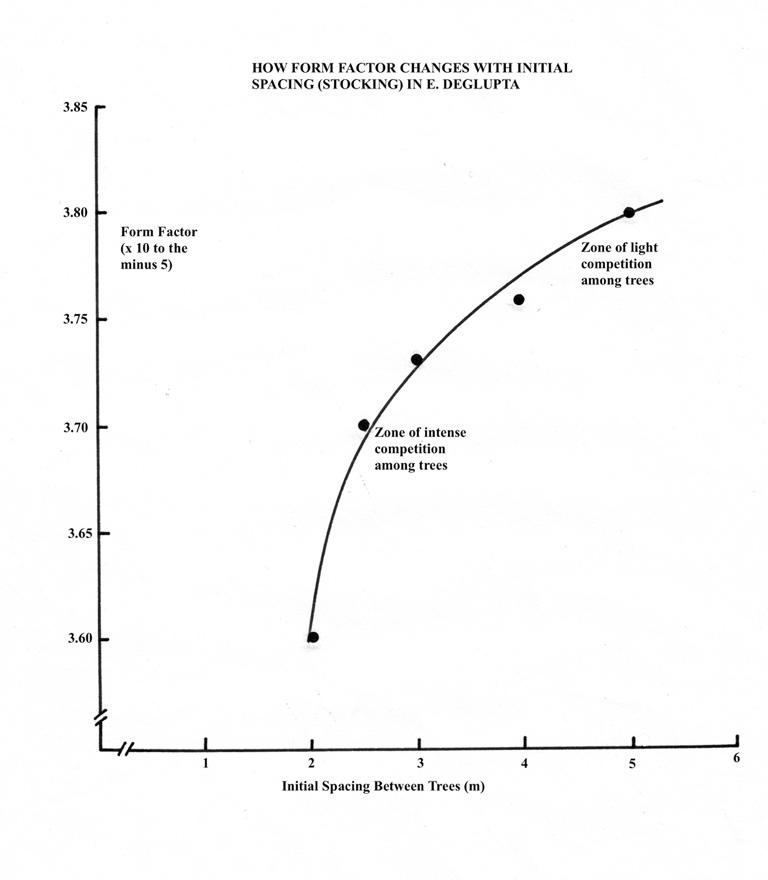
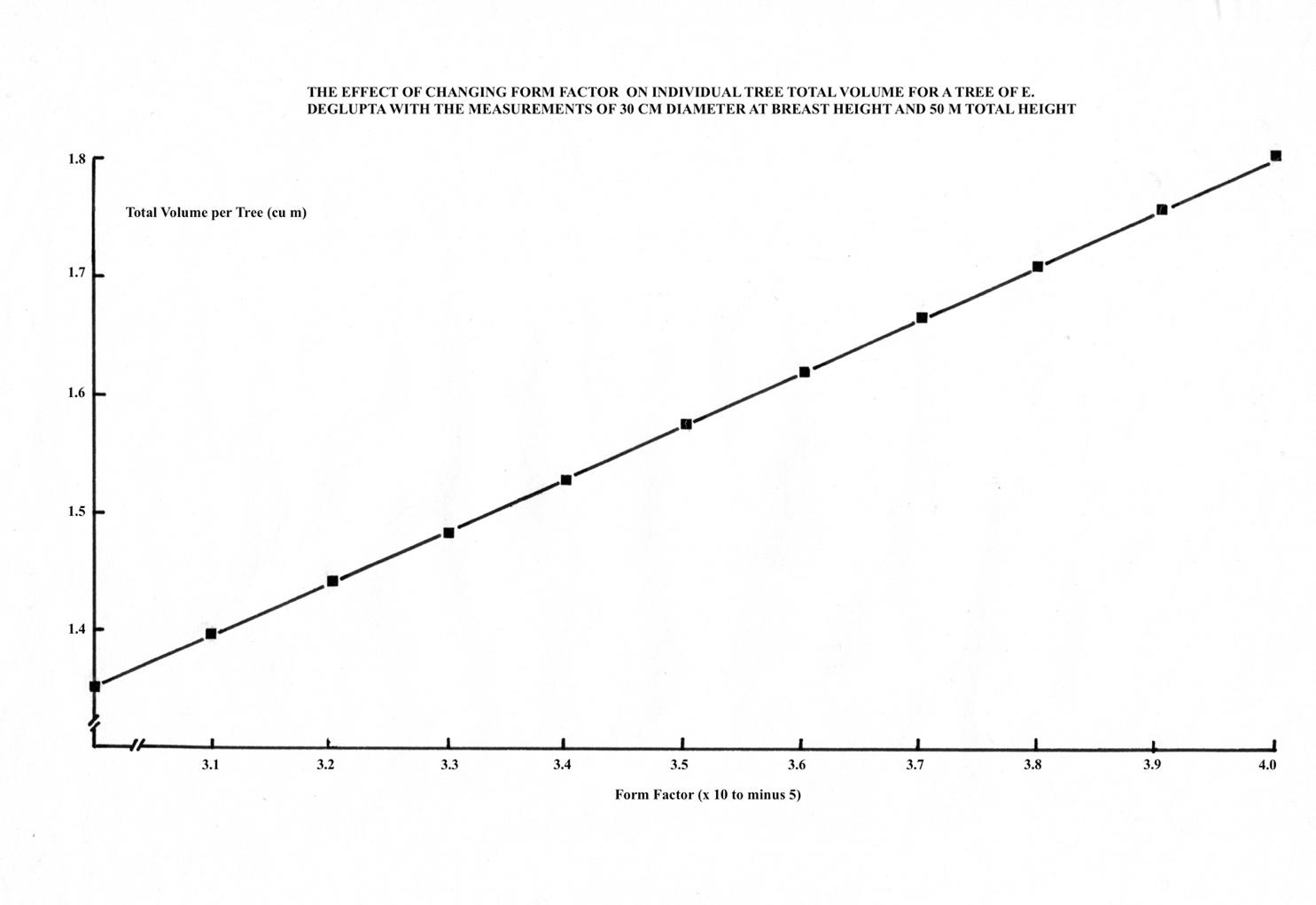
An updated general volume table for E. deglupta
As a result of the work on bole shape updated metric volume tables were prepared for E. deglupta. One was for application to pulpwood plantations of Keravat provenance grown on land of site quality 1 or 2 and an initial spacing of from 2.5 x 2.5 m to 4 x 4 m or other arrangements of spacing between rows and between trees that would produce an equivalent stocking, diameters up to 20 cm and heights up to 25 m The regression of best fit led to the following:
V = 0.0005601 + 0.0000804D2 + 0.000020D2H 0.0000314H2 + 0.0000111DH2 where: V = total volume in m3 under bark, D = mean diameter at breast height in cm under bark, and H = total height in m.
For sawlog plantations diameters between 20 cm and 100 cm and heights between 25 m and 85 m, the regression of best fit was the following:
V = 0.0000636D1.9037H0.9139 where V, D and H are as above.
A measurement plot of not less than about 1/20 ha was recommended. The height H of all trees in a plot could be measured easily using height rods if the stand was not much more than a year old. For older (and thus taller) trees, the measurement of fewer trees in the plot was desirable. Only 10 tallest trees could be measured (200/ha) in stands 18 months or more in age. The mean of these trees was the “predominant height” of the stand (Hdom). A good relationship was found between predominant height and mean height at different ages, enabling predominant height (Hdom) to be converted into mean height (H) for use in the above volume equation.
At 18 months: H = 0.92Hdom 1.3 (r = 0.94, significant at the 0.1% level)
At 30 months: H = 0.97Hdom 2.03 (r = 0.92, significant at the 0.1% level)
At 42 months: H = Hdom 3.0, at 54 months H = Hdom 4.1, at 66 months H = Hdom 5.2 (all r = 0.90, significant at the 0.15% level).
Alternatively, the following relationship could be used (based on a sample of 300 trees, all sizes):
V = 0.1753941 + 0.0148645Hdom + 0.00004065D2Hdom 0.00035082Hdom 2 0000001578D2Hdom 2 Where V = total volume in m3 under bark, D = mean diameter at breast height in cm under bark, and Hdom = predominant height in m.
Further provenance trial of E. “urophylla”
Just as I departed Bulolo 20 seedlots from the Centre Technique Forestier Tropical (CTFT) collections of E. “urophylla” were received via HQ, which had assigned local seed batch numbers in the range 816 to 835. These lots were:
816: 3g. CTFT Provenance No. 47, Seed tree Nos 235 239, Maubisse Region, Portuguese Timor, Altitude: 1,430 m, Annual rainfall: 1,400 1,800 mm, Number of dry months: 3 4 less than 50 mm, nil less than 10 mm, Mean annual temperature: 14 20°C.
817: 3 g. CTFT Provenance No. 55, Seed tree Nos 272 276, Ermera Region, Portuguese Timor, Altitude: 1,090 m, Annual rainfall: 2,500 mm, Number of dry months: 3 less than 50 mm, 0 1 less than 10 mm, Mean annual temperature: 19 20°C.
818: 3 g. CTFT Provenance No. 70, Seed tree Nos 349 352, Mount Moutis, Indonesian Timor, Altitude: 2,030 m, Annual rainfall: 1,700 2,000 mm, Number of dry months: 3 4 less than 60 mm, Number of wet months: 6 more than 100 mm
819: 3 g. CTFT Provenance No. 80, Seed tree Nos 392 394, Bakan, Lomblen Island, Indonesia, Altitude: 520 m, Annual rainfall: 900 1,000 mm, Number of dry months: 6 7 less than 60 mm, Number of wet months: 3 more than 100 mm
820: 3 g. CTFT Provenance No. 85, Seed tree Nos 417 420, Mount Wuko, Flores Island, Indonesia, Altitude: 900 m, Annual rainfall: 1,200 1,500 mm, Number of dry months: 3 4 less than 60 mm, Number of wet months: 4 5 more than 100 mm. 821: 6 g. CTFT Provenance No. 90, Seed tree Nos 442 446, West Alor Island, Indonesia, Altitude: 300 400 m, Annual rainfall: 1,200 1,400 mm, Number of dry months: 3 4 less than 60 mm, Number of wet months: 3 4 more than 100 mm. 822: 8 g. CTFT Provenance No. 89, Seed tree Nos 436. 437, 439, 440, Mount Moena, Flores Island, Indonesia, Altitude: 700 800 m, Annual rainfall: 1,200 1,400 mm, Number of dry months: 6 7 less than 60 mm, 3 4 more than 100 mm. 823: 6 g. CTFT Provenance No. 91, Seed tree Nos 447 449, West Alor Island, Indonesia, Altitude: 500 600 m, Annual rainfall: 1,200 1,400 mm, Number of dry months: 6 7 less than 60 mm, Number of wet months: 3 4 more than 100 mm. 824: 8 g. CTFT Provenance No. 92, Seed tree Nos 455 457, West Alor Island, Indonesia, Altitude: 300 400 m, Annual rainfall: 1,200 1,400 mm, Number of dry months: 6 7 less than 60 mm, Number of wet months: 3 4 more than 100 mm. 825: 4 g. CTFT Provenance No. 93, Seed tree Nos 459, 462, North coast of Alor Island, Indonesia, Altitude: 800 m, Annual rainfall: 1,200 1,400 mm, Number of dry months: 6 7 less than 60 mm, Number of wet months: 3 4 more than 100 mm. 826: 2 g. CTFT Provenance No. 94, Seed tree No. 467, Central region of Alor Island, Indonesia, Altitude: 900 m, Annual rainfall: 1,200 1,400 mm, Number of dry months: 6 7 less than 60 mm, Number of wet months: 3 4 more than 100 mm. 827: 5 g. CTFT Provenance No. 95, Seed tree Nos 471, 472, South coast Alor Island, Indonesia, Altitude: 450 500 m, Annual rainfall: 900 1,000 mm, Number of dry months: 7 less than 60 mm, Number of wet months: 3 4 more than 100 mm.
828: 7 g. CTFT Provenance No. 96, Seed tree Nos 473 477, South coast Alor Island, Indonesia, Altitude: 600 700 m, Annual rainfall: 900 1,000 mm, Number of dry months: 7 less than 60 mm, Number of wet months: 3 4 more than 100 mm.
829: 6 g. CTFT Provenance No. 98, Seed tree Nos 482, 483, 485, Central region of Alor Island, Indonesia, Altitude: 800 850 m, Annual rainfall: 900 1,000 mm, Number of dry months: 7 less than 60 mm, Number of wet months: 3 4 more than 100 mm
830: 6 g. CTFT Provenance No. 101, Seed tree Nos 494, 495, 497, Siroeng Volcano, Pantar Island, Indonesia, Altitude: 500 700 m, Annual rainfall: 600 800 mm, Number of dry months: 8 less than 60 mm, Number of wet months: 2 3 more than 100 mm.
831: 6 g. CTFT Provenance No. 101, Seed tree Nos 500, 501, 503, Siroeng Volcano, Pantar Island, Indonesia, Altitude: 500 700 m, Annual rainfall: 600 800 mm, Number of dry months: 8 less than 60 mm, Number of wet months: 2 3 more than 100 mm.
832: 9 g. CTFT Provenance No. 102, Seed tree Nos 504, 506 510, East coast, Pantar Island, Indonesia, Altitude: 600 m, Annual rainfall: 900 1,000 mm, Number of dry months: 7 less than 60 mm, Number of wet months: 3 4 more than 100 mm.
833: 5 g. CTFT Provenance No. 103, Seed tree Nos 511, 513 515, East coast Pantar Island, Indonesia, Altitude: 350 400 m, Annual rainfall: 900 1,000 mm, Number of dry months: 7 less than 60 mm, Number of wet months: 3 4 more than 100 mm.
834: 7 g. CTFT Provenance No. 104, Seed tree Nos 516 520, South coast Wetar Island, Indonesia, Altitude: 300 m, Annual rainfall: 700 800 mm, Number of dry months: 7 8 less than 60 mm, Number of wet months: 3 more than 100 mm.
835: 3 g. CTFT Provenance No. 106, Seed tree Nos 526, 528, 533, South coast Wetar Island, Indonesia, Altitude: 300 400 m, Annual rainfall: 1,200 1,300 mm, Number of dry months: 4 5 less than 60 mm, Number of wet months: 6 more than 100 mm.
I am not aware of what became of these seedlots.
Forest Tree Series Leaflet on E. deglupta
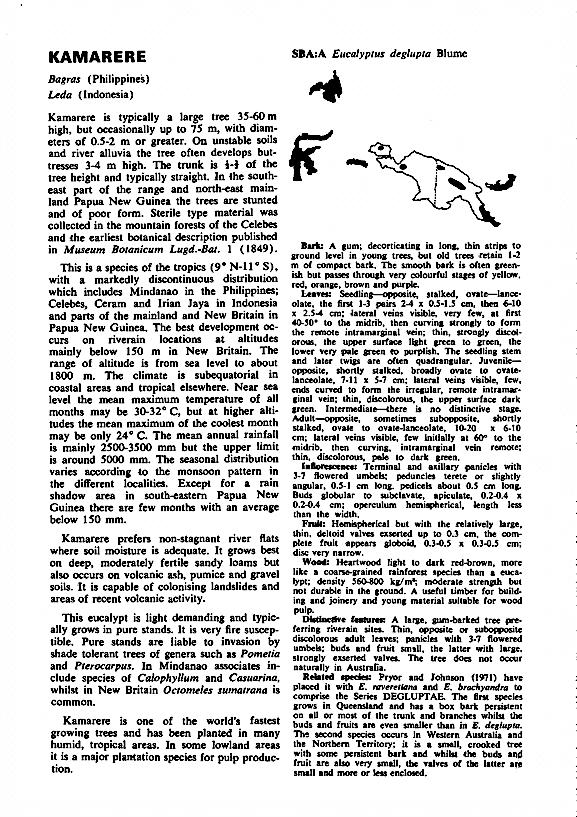
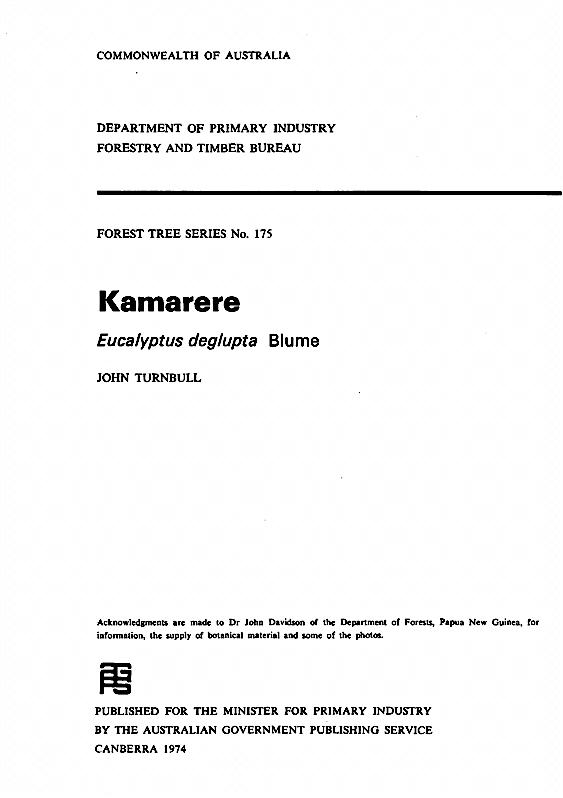
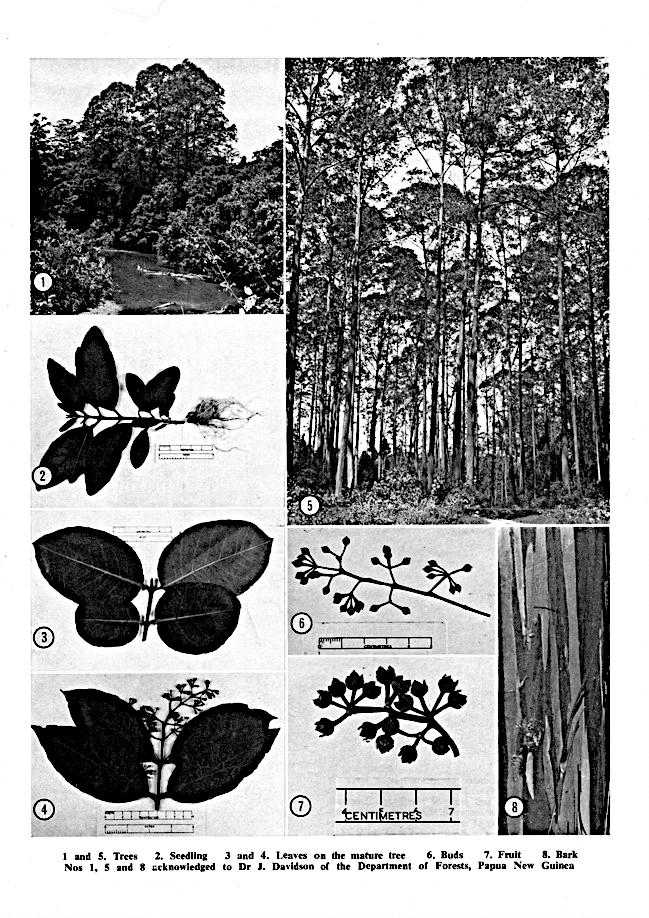
Photographs and fresh specimens of E. deglupta along with the latest detailed description of the species prepared by me were sent to the Forestry and Timber Bureau in Canberra, for preparation by John Turnbull of a leaflet (No. 175) in their Forest Tree Series seen here.20
Note that for “leaves of the mature tree” the leaflet illustrated both the broad type of variety schlechteri (No. 3) and the narrower type with acute drip tips (No. 4) like those of variety deglupta, but did not make reference to that distinction in the text. The map included overemphasised somewhat the actual distribution of the species.
Progress report on tree introduction and improvement
21
1975
Provenance seed collection of E. deglupta in the Celebes and Ceram Islands May 1975
After my presentation22 at the combined meeting of IUFRO Working Parties S2.02.8 (Tropical Species and Provenances) and S2.03.1 (Breeding Tropical and Sub tropical Species) held in Nairobi, Kenya, in October 1973, the importance of E. deglupta in tropical and sub tropical forestry was acknowledged and the need to increase the range of provenance material available was recognised. Sometime after the Nairobi Meeting it was agreed that the Centre Technique Forestier Tropical (CTFT) would make collections of E. deglupta in Ceram and in Sulawesi, where previous collections had been small, and that a collection team co ordinated from the Forest Research Institute (FRI) Canberra would make collections in Irian Jaya (see next section). Christian Cossalter, then Ingénieur des Traveaux des Eaux et Forêts, CTFT, Nogent sur Marne, France led an E. deglupta seed collection mission to Indonesia in May 1975.23Extracts from his account follow with numbers referring to his map reproduced here.
In Sulawesi (Celebes Island)
“In the Indonesian province of Sulawesi (Celebes Island) Eucalyptus deglupta is known under the vernacular name of Kaju Leda. Between latitudes one degree North and two degrees South, pure stands of this species are growing at a number of locations, both coastal and at higher elevation. Examples of coastal sites are …. : Dumoga 1, Tapa 2, Ongka 3, Tolitoli 4, Balukan 5, Kolawi 6, Saweiti 7, Tibao 8, Ampibabo 9, Marantalo 10, Sausu 11, Lariang 14, Kolonodale 16, Bongka 17, Ampana 18, Kabali 19, Batui 20, Balantal 21. Examples of higher elevation sites are: Palolo 12, Gimpu 13, Pindolo 15. South of latitude 2° S, the natural stands which have been located are rarer, they are mainly concentrated in the coastal plain reaching from Palopo to Malili, north of the Bone gulf, between the S.E. and the S.W. peninsulas (Parara 23, Kaloukou 24, Tobou Tobou 25, Todantana Padang 26, Mario 27, Kandoa 28). At similar latitudes the natural stand on the swampy plain of Sampaga (22) occurs on the west coast. Below parallel four degrees South, E. deglupta is only found along two rivers (Wempalle River 29 and Berong River 30) flowing toward the west coast. These two locations do not contain stands but scattered trees growing along the torrents, which cross the last ridges before reaching the coastal plain. The natural stand of Parenglui on the Berong River is the farthest location from the equator of the Indonesian E. deglupta. Parenglui is located at 5°15' S in the extreme S.W. of the island.”
“Climatic factors are the main reason why the species is restricted almost entirely to a strip 5 degrees wide, on both sides of the equator. Most of the provenances are concentrated in coastal plains close to latitude 0°. A hot and very humid climate,
21 Howcroft N and Davidson J 1974 Papua New Guinea tree introduction and improvement progress report 1972 1974. Tropical Forestry Research Note SR 26. Department of Forests, Boroko, PNG. 10pp.
22 Davidson J 1973 Provenance trials of Eucalyptus deglupta in Papua New Guinea. Paper presented to a Combined Meeting of IUFRO Working Parties S2.03.1 and S2.02.8, Nairobi, Kenya.
23 See Cossalter C 1977 Location and ecological data of some provenances of Eucalyptus deglupta in the Celebes and Ceram Islands characteristics of the natural stands. Forest Genetic Resources Information, FAO, Rome 6:16 23.
with high rainfall and no dry season, is particularly well suited for this species. The following climatic data are characteristic over a great part of the Celebes coast, independently of the exposure and aspect:
• mean annual temperature around 25 to 27° C,
• relative humidity uniformly high all the year,
• total annual rainfall between 2,000 mm and 3 500 mm, generally close to 2 500 mm.
In a normal year, monthly rainfall is over 100 mm for 9 to 11 months a year and less than 60 mm for one month. Exceptionally, the dry period (less than 60 mm a month) may last 3 or 4 months in a few places. This type of climate is typical of the provenances of the western coast to latitude 3° S (provenances 4,5,6,7,8,14,22), of the provenances of the coastal plain north of the Bone Gulf (provenances 23,24,25,26), of the provenances of the Poso area on the Tomini Gulf (provenances 11,17,18) and of the Kolonodale area on the Tolo Gulf (provenances 16,19).”
“Provenances occurring on the plateaux of the central massif, near the Lindu and Poso lakes, have similar conditions (provenances 12,13,15), but mean annual temperature is slightly lower (around 22 to 24° C) due to the altitude which varies from 500 m to 1,000 m. The dry season is even less marked than on the coast. Monthly rainfall may drop under 60 mm for 1 or 2 months in the driest years but usually the dry period lasts only 10 to 20 days a year. In an average year, 11 months have more than 100 mm of rainfall and total rainfall in the year may reach 5,000 mm. The coasts of Tomini Gulf facing east and south, the tip of the Luwuk peninsula and the SW coast of the island are subject to drier climatic conditions. Average annual rainfall varies from 1,500 mm to 2,300 mm and there are 3 or 4 dry months with less than 60 mm of rainfall. The dry season may exceptionally last 5 to 6 months. The wet season (over 100 mm a month) usually lasts 7 to 8 months. This type of climate corresponds particularly to provenances 2,3,9,10,20,21.”
In Ceram Island
“Contrary to Celebes, where it occurs over a wide range of ecological conditions from the coast to elevated plateaux, it seems that in Ceram E. deglupta (called Kaju Patola in the vernacular language) is limited to a few sites located in the eastern part of the island. It grows along rivers with an average length of 10 to 15 km, which rise in the northern and eastern slopes of this mountainous island and flow across a narrow coastal plain covered, like the slopes, with tropical rain forest. The main stands of E. deglupta in this area are found on the banks of rivers that have the strongest flow (Samal River 35, Matakabo 36, Boebi 37, Masiwang 40) but it also occurs along smaller rivers (Wahi River 31, Taloearang 32, Moeal 33, Isal 34, Lola 38, Nif 39). The western limit seems to be the Wahai River, flowing north in the central part of the island.”
“On Ceram, the climate of the NE and east coast is intermediate between the two types of coastal climate in Celebes. Total annual rainfall is around 1,800 mm to 2,300 mm, the dry season normally lasts 1½ to 3 months, and 5 to 6 months during occasional dry years, the wet season lasts 7 to 9 months. Provenances 31 to 40 are subject to such conditions, as are provenances 27 and 28 from the Bone Gulf in Celebes.”
Regeneration, characteristics of natural stands and habitat
Regeneration: “Flower buds appear at the height of the wet season as rainfall and vegetative growth reach their maxima. Heavy flowering usually follows the wettest period. Within 12 weeks buds develop into mature capsules; when ripe, fruits keep their seeds for 2 or 3 more weeks before opening. The period of seed dissemination occurs at the end of the wet season, as the floodwater retreats and large banks of gravel and sand mixed with silt are uncovered in the river beds and along the banks. The diminishing river flow deposits the seeds in full sunlight, on the banks bare of vegetation. These are ideal conditions for seed germination and for establishment and growth of seedlings. Successive deposits of silt during the later flooding periods build up the soil of the future forest.”
Characteristics of Natural Stands: “E. deglupta is a light demander. It is very demanding in its water requirements and will tolerate neither poor drainage and stagnant water, nor a water table of excessive depth. Its requirements for soil water and regeneration explain both its habitat and the structure of the natural stands. It is restricted mainly to the banks and islets of rivers, which it colonises in pure, even aged groups of limited area. These uniform high forest groups contain trees of slender form, growing at high density and all of approximately the same size. During the first stage of development, the understorey is missing. Species of the tropical rain forest such as Vitex cofassus, Dillenia sp., Pterospermum celebicum, Calamus sp., Pangium edule, Dracantomelon mangiferum, Calophyllum soulathi become established late under the canopy of mature stands.”
“Under the oldest stands such as Tobou Tobou on the Tomini River (25), a dense second stratum of forest had become established. The density of the dominant E. deglupta was around 30 40 trees per ha; the average tree reached the following dimensions:
• total height 65 to 70 m,
• 40 to 45 m of clear, straight, bole,
• DBH of 115 cm.
The biggest trees of this stand had a total height of 75 to 80 m and a DBH of 150 cm. Closed stands of E. deglupta did not contain natural regeneration at any stage of development.”
Habitat: “From the mouth to the source of a river, many suitable sites could be found for E. deglupta to become established. The species may occur along the last meanders of a river in the coastal plain. In Ceram it extended downstream as far as the river remained non tidal. In Celebes no provenances have been found less than 15 km from the sea. It can also colonise banks of torrents in the upper valleys. Plateaux seem to be particularly suitable for the species to become established and to spread. On the Palolo plateau at the confluence of the Sopou and Lindu Rivers, the banks of both rivers are covered with a mosaic of groups varying in age from patches of seedlings to mature stands of approximately 100 trees per ha, 50 m tall and 1 m in DBH. Gimpu plateau on the upper part of the Lariang River is another good example of the vigour of the species on this type of site. The spread of the species mainly depends on the size of the stream. Along torrents running down steep mountain slopes, the species was restricted to some clumps of small area, sometimes only scattered trees (Tampak and Ampibabo Rivers for instance). In Ceram the species occurs along large and medium sized rivers. Stands are more frequent and of bigger area on the bigger rivers. On these, they often increase as one goes upstream. In areas like the coastal plain situated north of the Bone Gulf, where there are 6 rivers, of which 5 are large, E. deglupta occurs at a number of locations without ever becoming common. Its occurrence is occasional.”
Key: CELEBES ISLAND: 1. Dumoga area, 2. Tapa area, 3. Ongka area, 4. Toli Toli area, 5. Balukan area, 6. Kolawi area, 7. Saweiti area, 8. Tibau River, 9. Ampibabo River, 10. Marantalo River, 11. Sausu River, 12. Palolo Plain, 13. Gimpu Plain, 14. Lariang River, 15. Pindolo area, 16. Konolodale area, 17. Bongka River, 18. Ampana area, 19. Kabali area, 20. Batui River, 21. Balantal area, 22. Sampaga (Karana River), 23. Parara (Kong Kong River), 24. Kaloukou (Tampoke River)*, 25. Tobou Tobou (Tomoni River)*, 26. Tedantana, Padang (Kalaena River)*, 27. Mario (Tampak River)*, 28. Kandoa, 29. Wempalle River, 30. Parenglui (Berong River); CERAM ISLAND: 31. Wahai River, 32. Toloearang River, 33. Moeal River, 34. Isal River, 35. Samal River, 36. Matakabo River*, 37. Amboli (Boebi River)*, 38. Lola River, 39. Nif River, 40. Masiwang River. *Sites visited by the CTFT Seeds Mission during May 1975. Source C Cossalter 1975, with edits and addition of the location of the type specimen for E. deglupta by me.
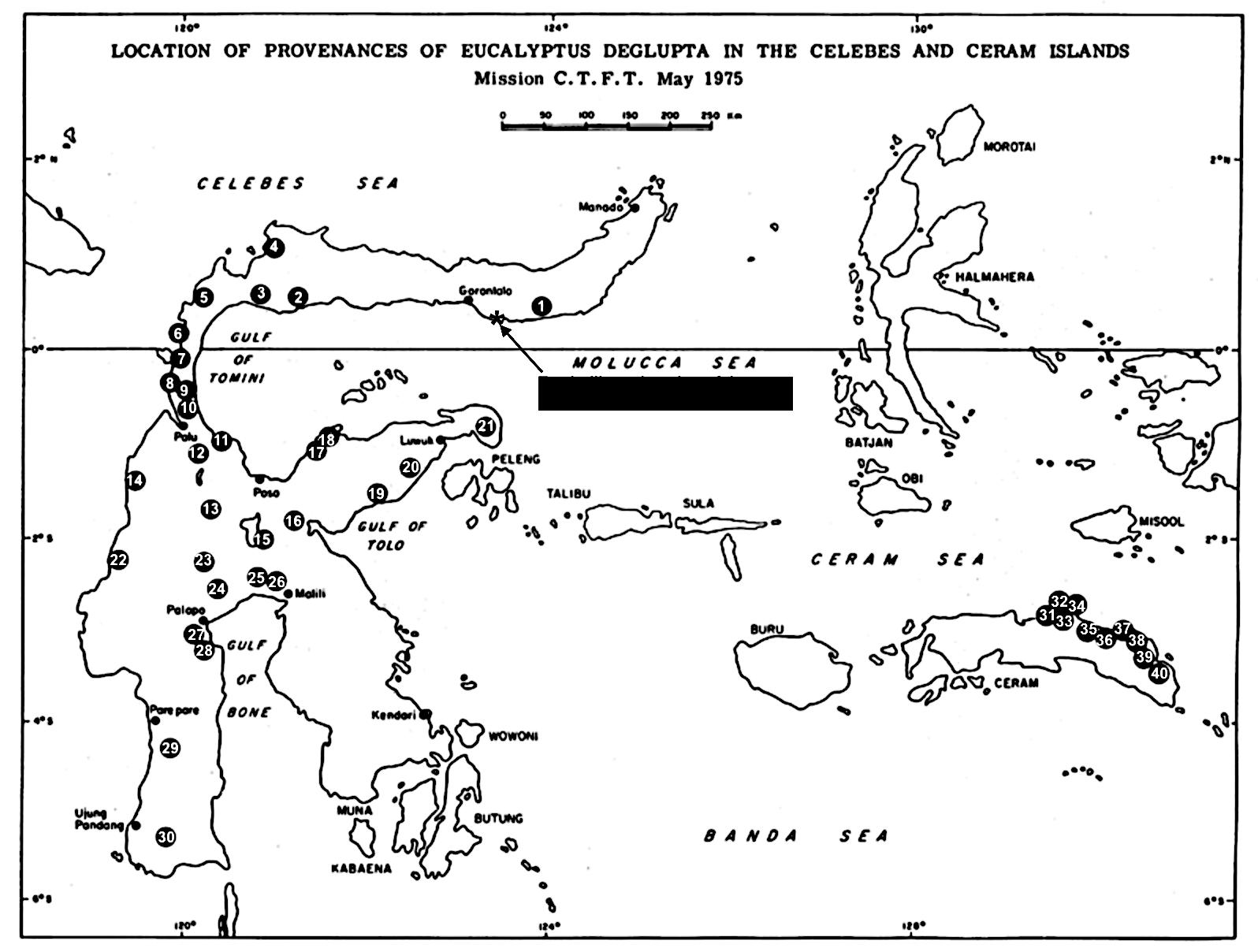
E. deglupta in Central Celebes. Top left: Cohorts of different ages on the banks of the Lindu River, Palolo Plain (location no. 12 on map). Top right: Trees on the banks of the Tampak River (location 27). Left: Stand on the bank of the Tomini River (location 25). Below: Young regeneration in the foreground and larger trees behind on the bank of the Sopou River (near location 12). (Photographs by C Cossalter 1975.)
Provenance seed collection of E. deglupta in Irian Jaya, Indonesia, 3 17 June 1975
The second major seed collecting activity agreed by the IUFRO meeting in Nairobi was an expedition to Irian Jaya24 , Indonesia. This was undertaken from 3 17 June 1975. The distribution of E. deglupta had been broadly mapped,25 though its distribution in Irian Jaya was less well known because of the inaccessibility of the province’s interior. The only hard evidence available comprised Eyma’s specimen 5360 collected from Bogesiga, Wissel Lakes area in 1939, Zeick’s herbarium specimens including BW3286 collected near Kebo north of the Wissel Lakes in 1960 and Van Royen and Sleumer’s specimen




24 In 2002 Irian Jaya was granted “special autonomy”, the Province was divided into two east west, and the names Papua and West Papua allowed respectively. Enarotali and Lake Paniai are in Papua Province at the western end of the central highlands (Maoke Mountains) (see map next page).
25 Davidson, J. 1973 Conservation of the gene resources of tropical Eucalyptus deglupta Blume. Tropical Forestry Research Note SR 12, Department of Forests, PNG; and Turnbull, J.W. 1974 Kamarere: Eucalyptus deglupta Blume. Forest Tree Series, No. 175, Forestry and Timber Bureau, Australian Government Publishing Service, Canberra.
7946 collected in 1961 from Mt Nettoti in the headwaters of the Andjai and Wekari Rivers on the Vogelkop Peninsula at about 1,800 m elevation (illustrated earlier in this account).
The collection party consisted of D. Boland, FRI Canberra, Australia, myself (then seconded to the Papua New Guinea University of Technology) and N. Howcroft, Research Station, Department of Forests, Bulolo, PNG, J. Dali, Forest Research Institute, Bogor and S. Hutagaol, Department of Forestry, Jayapura, Indonesia. Airfares and travelling allowances for party members were paid for from an FAO fund for seed collection granted to FRI Canberra. It was previously agreed that all seed collected would be divided half each between the Indonesian and the Papua New Guinea/Australian participants.
An unsuccessful attempt was made to determine the precise time to make collections before departure. For this reason, the timing of E. deglupta collections was predicted from known collection times in Papua New Guinea.

Boland, Howcroft and myself assembled with our gear at the airport in Lae to catch the scheduled Air New Guinea flight to Madang on the afternoon of 2 June 1975. We suffered an immediate setback in that facing bad weather, the DC3 would not be able to uplift our accompanying cargo. This meant we would not be in a position to join the flight to Vanimo and Jayapura the following day. A hasty visit was made by Nev Howcroft to the Regional Forest Office in Lae where a Cessna 402 charter was immediately arranged to take the party and the essential equipment to Madang that evening.
We left Lae in the dark, travelling just off the coast towards Madang in deteriorating weather. Visibility was nil. We were buffeted by rain and severe turbulence. Lightning flashed in the clouds. The pilot’s
instrument flying was dead on and we broke out of the cloud at the last minute perfectly aligned with the runway lights of the Madang airport.
The next morning was fine and the party successfully joined the scheduled flight to Vanimo, and after a brief stopover continued on to Jayapura on the morning of 3 June 1975. The collection team met our Indonesian counterparts in Jayapura. They were J. Dali, Forest Research Institute, Bogor and S. Hutagaol, Department of Forestry, Jayapura, Indonesia. Some time was expended to obtain travel permits for the next leg which was to Kota Biak on the south coast of Biak,26 a small island in Cenderawasih Bay of the north coast of Papua.




More visits to the authorities in Biak were required to obtain travel permits for our onward journey. We divided into two groups at Biak.27 Boland, Davidson and Dali went to Enarotali via Nabire to make collections of E. deglupta and Howcroft and Hutagaol to Manokwari with the object of proceeding into the Kebar area to make collections of E. deglupta and Araucaria
transport difficulties, the latter party was unable to proceed into the Kebar valley.
26 Now called Pulau Supiori.
27 This account is derived from and expands on: Boland D J, Davidson J and Howcroft N 1977 Eucalyptus deglupta Blume and Araucaria cunninghamii Lambert provenance seed collections in Irian Jaya, Indonesia, 3 17 June 1975. Forest Genetic Resources Information 6:3 15.



The Boland team hired nine carriers at Enarotali to transport camping gear, tools, equipment, plant presses, a chainsaw, food and fuel. The forester at Enarotali and two members of the local police accompanied the team. An outboard motorboat was hired from the local Catholic Mission to transport the team from Enarotali, across the Lake to Little Kebo (see map). On the way it was noted many of the 200 or more blunt ended canoes without outriggers (“proas”) seen were hewn from solid logs of E. deglupta that would have been up to one metre in diameter.





Left: The team moves out towards the Lake with a policeman in the bow. Another policeman in the stern caused concern by firing his pistol over our heads at cormorants (shags) perched on driftwood while rocking the boat in the process which made his aim erratic! Right: A typical blunt ended canoe hewn out of a solid log of E. deglupta used by the local villagers for transport and fishing on the Lake.


When the motorboat could proceed no further the team disembarked with their gear in the shallow swampy area on the northeast shore of Lake Paniai near Little Kebo. Doug Boland is the person in the white shirt.


The team walked from Little Kebo through Kebo to Giteuto northwest of Kebo where a base camp largely constructed from local bush materials was set up on the bank of the Koebejo River. On the way two tree climbers were recruited from Kebo to assist the collection team.

Left: Our arrival in Giteuto
base camp area. Most of the pig fences were split E. deglupta and Casuarina sp. Many of the latter nearby were pruned of their branches all or almost all of their length for fuel, and some kind of rotation was practised for this, with some stems still intact or regrown, and some only partially harvested.
Top: Our base camp in Giteuto Village. Sleeping places off the ground for Doug Boland and myself and cooking facilities. Part of the food we had carried in comprised Australian army one day ration packs that we had acquired in Madang. Bottom: A constant stream of curious locals came to visit. (The colour balance of some of these photographs was affected by the high humidity that the exposed films were kept in, before they were sent to Kodak in Melbourne for processing after our return to PNG.)






Four patrols (numbered 1 4 on the map) were made from Giteuto to inspect E. deglupta (local name “djewo”) and collect herbarium specimens and seed. The first was made to the steep hillsides immediately northeast of the base camp. The second was made to the west bank and adjacent hillsides of the Koebejo River. The third patrol was made into the headwaters of the Koebejo River from where an unsuccessful attempt was made to cross the high ground above 2,300 m elevation with the intention to descend into the Erome River valley. The fourth patrol was made to Kederebutu.
Sketch map showing the routes taken by the collection party across Lake Paniai and into the hills north of the Lake. Enarotali is considered to be the only colonial town built in the interior of New Guinea by the Dutch.

Left: On the way into the forest, we came across this felled E. deglupta which was destined to be made into a canoe. Right: Large E. deglupta trees. These had been climbed and branches harvested to provide material for pig fences. Note that in the tree in the background one of the severed branches has “hung up”. Steel axes were used by the tribespeople for these tasks and represented a prodigious expenditure of human energy. Crowns of E. deglupta near Kebo were large with heavy branches that were swollen at the junction with the trunk. As the crowns of these adult trees emerged 10 15 m above the surrounding canopy, it was possible to recognise the species from a great distance on land and also from the air because of its characteristic crown shape, branching habit, open foliage and lighter coloured leaves.

In the Koebejo River valley E. deglupta usually occurred as scattered veteran individuals or sometimes in small clumps of up to seven trees. One large stand of about 20 trees was observed in a gully behind a ridge on the eastern side of a tributary of the Koebejo River, known locally as Gummi River. Very few trees were seen in riverain positions and most were situated high up on the steep hillsides and on ridges. Several E. deglupta stumps and logs from recently felled trees were seen on hillsides facing the Lake. The local villagers valued the timber of E. deglupta for several uses. The most important was for the building of the canoes already mentioned but the species was also in demand for pig fence stakes, bridges over small streams and firewood. Some of the short span bridges were constructed from retired

canoes. The bark of E. deglupta was sometimes used as a roofing material. The survival of the remaining trees was probably associated with their position on hillsides facing away from the Lake and being difficult for the villagers to fell and extract logs for canoes or drag roughly hewn canoes at first uphill before being able to take advantage of the downhill slope towards the Lake. It was estimated that altogether 400 standing trees were seen. Regeneration of E. deglupta was entirely lacking in the areas visited The base of the trunks of many of the large trees were enlarged and knotty, a feature not seen elsewhere with E. deglupta, and here may indicate fortuitous origin through coppice from stumps of trees harvested by tribal people perhaps hundreds of years ago. The main associate species were Castanopsis, Palaquium, Cryptocarya, Garcinia, Myristica and Eugenia spp.
The soils around the Wissel Lakes were derived mostly from limestone parent material. In the Koebejo River valley and near Little Kebo, the soils were derived from sandstone and siltstone parent materials. E. deglupta was found growing only on these latter soils. Between Kebo and Little Kebo there was a small area of soils apparently volcanic in origin. The altitudinal range of the species was approximately 1,700 2,000 m. Rainfall averaged 2,500 3,500 mm per annum. Because of altitude the nights were very cool.
Over a period of five days, two trees were felled with great difficulty because of their size. Wood samples were taken from these two trees. Herbarium specimens and fruits were collected from these two trees and specimens and fruits from another five trees were obtained by climbing. The climbers used a technique of climbing a nearby smaller tree then crossing over to the collection tree, bypassing the smooth broad part of the trunk of the target tree. Sometimes a vine bridge would be made between the two trees. A vine loop was also placed loosely around the climber’s ankles to provide frictional support while climbing. Seed bearing branches were severed by machete. The seed crop was generally poor with approximately 160 g of seed collected from four trees (the two felled and two of those climbed). Several trees were carrying dry open fruits. Apparently in this location most of the seed had fallen in a peak period about one to two months before the team arrived so scheduling of the mission based on typical seed collection times in PNG proved to be unhelpful. Nevertheless, there were many individual trees with inflorescences at widely different stages of development. This suggests that the period in which seed can be collected is lengthened although the number of individuals from which seed can be collected outside of the peak period is fewer. Collection by whole tree felling is unsatisfactory because fruits scatter when the crown hits the ground. Good aeration of the fruits after collection is also essential in humid conditions to avoid seed deterioration through fungal growth.
The maximum size of trees was 50 70 m in height and 160 200 cm diameter. Clear boles were up to 30 40 m. However, on average they were somewhat smaller in size than the very large veterans encountered by me in New Britain. The forest type in which E. deglupta was found was in a mixed broadleaved forest having a stocking and volume per unit area of not less than that found in typical tropical lowland forest elsewhere in New Guinea. In this primary forest no natural regeneration of the light loving E. deglupta was found. Two young saplings were located on the bank of a creek in a place where mature trees had been felled.



The trunk of these trees was usually straight, or slightly twisted, and buttressed at the base. The diameter of the trees and the substantial buttresses presented a challenge to fell them with our chainsaw with only a 24 inch cutter bar and limited fuel and oil supplies. Left: scaffolding erected to be able to cut above the buttresses. Above: It required both chainsaw and axes to fell this tree. Below left: This tree was mostly sound to the centre with only some evidence of incipient decay near the pith, in marked contrast to veterans of similar size in New Britain that typically had very large pipes and only 20 30 cm of solid wood on the outside. Below right: Substantial wood sample collected for transport back to PNG.

Herbarium specimens collected:
Near Koebejo River, Wissel Lakes, Irian Jaya, altitude 1,850m, 10 June 1975, Davidson 1010 (WL1), Diameter 130 cm, Height 50 m. Among single dominants on steep slopes. Veteran trees with long raking branches, in fruit (LAE, FRI).
Near Koebejo River, Wissel Lakes, Irian Jaya, altitude 1,825m, 11 June 1975, Davidson 1011 (WL2), Diameter above buttress 125 cm, Height 50 m. On steep slope, north of Kebo Mission Station. Top broken out. On shallow yellow brown soil over sandstone (LAE, FRI).
Near Kebo, on slope near Koebejo River, Wissel Lakes, Irian Jaya, altitude 1,850 m, 12 June 1975, Davidson 1012 (WL3), Specimens with dry capsules collected (LAE, FRI).
Near Kebo, on the bank of the Koebejo River, Wissel Lakes, Irian Jaya, altitude 1,750 m, 12 June 1975, Davidson 1013 (WL4), Near stream bed, Diameter 55 cm, Height 35 m. In bud (LAE, FRI)
Near Kedergboetoe, Wissel Lakes, Irian Jaya, altitude 1,750 m, 12 June 1975, Davidson 1014 (WL5), Large tree, twisted trunk, foot of the trunk with a stocking of reddish brown fibrous bark, strips of bark falling off and piling up at the base of the tree (LAE, FRI)
Near Koebejo River, Wissel Lakes, Irian Jaya, altitude 1,850 m, 13 June 1975, Davidson 1015 (WL6), On steep slope, Diameter 140 cm, Height 65 m, flowers and fruit present (LAE, FRI)
Koebejo Valley, near Kebo, Wissel Lakes, Irian Jaya, altitude 1,750 m, 14 June 1975, Davidson 1016 (WL7), on steep slope away from river, Diameter 75 cm, Height 35 m, clear bole 20 m. Main associates Castanopsis, Palaquium, Cryptocarya, Garcinia and Eugenia species, (LAE, FRI)
Upon return to Enarotali unconfirmed reports were received from villagers that E. deglupta also occurred in the Pugo River valley south of Enarotali and in the Koto River valley near Obano at the western extremity of the Lake. A motorboat trip from Enarotali up the Pugo River and some walking along the shoreline and inland in the vicinity of Kaitadi failed to locate any E. deglupta
The collecting teams re grouped in Kota Biak and all material collected was divided two ways, one lot for Bogor, Indonesia the other for PNG/FRI Boland, Davidson and Howcroft returned to Lae PNG via Jayapura and Vanimo. Unfortunately, the viability of seed taken into PNG was extremely low apparently because of zealous quarantine treatment with methyl bromide fumigation of all specimens, seed, clothing, boots and equipment at the Herbarium in Lae. Seed taken from Biak to Bogor was believed to be viable. At Bulolo a few viable seeds were obtained by shaking them from the drying fruits on herbarium specimens and 11 trees were eventually raised.28
The density of the wood samples of the large trees ranged from 600 900 kg/m3. At this locality in a cool moist climate, the dense (for E. deglupta) heartwood high in extractives seemed to impart a degree of durability in the air (for house and bridge construction), in the ground (sharpened stakes for pig fences) and in the water (canoes).
E. deglupta fruits from near the Wissel Lakes were morphologically different from other known
28According to Neville Howcroft, three of these trees still remained near Bulolo in 2018.
provenances. They were larger and the fruit valves were not prominently exserted. The ovary was inferior and not half inferior as is the general case for E. deglupta. The number of valves per fruit was mostly four, but occasionally five and six, or more. Other provenances usually have three or four valves. The staminal ring was deciduous, but this was not uncommon in E. deglupta elsewhere The pedicels were longer and more markedly quadrangular than seen in other provenances.



Top left: Near mature capsules typical of the E. deglupta at the Wissel Lakes shown close to natural size. The capsules were larger and the ovaries inferior (depressed almost completely below the rim) giving a hemispherical appearance rather than the near globular appearance of smaller capsules at a similar stage in other provenances. Top right: After dehiscence and seed shed, capsules here show from four to six loculi, with the valves not prominently exserted. Left: Diagrams comparing a capsule from Wissel Lakes (on the left side) with a capsule of the Keravat provenance of E. deglupta. Here both examples are four valved and the prominence of the open valve scales in the Keravat example is marked. (Drawings by N Howcroft, Bulolo, 1975; about 5x.)
The shape of adult leaves from the Wissel Lakes area was also different from other provenances. Leaves were from 5 to 11 cm (average 8 cm) in length and from 3 to 7.5 cm (average 4.5 cm) in width. The basal angle of the leaf lamina was markedly obtuse, similar to the Waria River (PNG) provenance (type locality of E. schlechteri Diels) and very different from Mindanao (Philippines) and New Britain (PNG) specimens which normally had more acute basal angles. Some of the trees had pronounced drip tips, others not so.
The collection mission concluded there was a strong need for gene conservation of the Wissel Lakes population of E. deglupta. The population was morphologically distinct. The number of trees that was seen was relatively few. Natural regeneration was very poor. The overall impression was that the few remaining trees would soon disappear.29
Natural distribution of E. deglupta
With the completion of the missions to Celebes, Ceram and Irian Jaya, I undertook an up to date assessment of the natural distribution of E. deglupta.
E. deglupta occurs between tropical latitudes 9°N and 11°S, in a markedly discontinuous distribution from longitude 119°E, through Mindanao in the Philippines, Sulawesi, Seram and West Papua in Indonesia, to longitude 153°E on New Britain in Papua New Guinea. The numbers in brackets in the following paragraphs refer to locations on the map (next page) and are cross referenced to the listed herbarium specimens that support the distribution.30
Philippines, Mindanao:
E. deglupta occurred in at least eight of the present day Provinces of Mindanao: Zamboanga del Norte, Zamboanga del Sur, Sultan Kudarat, Cotabato, Misamis Orientalis, Davao del Norte, Surigao del Sur and Agusan. The best stands occurred near the Agusan River and its tributaries (3 5 and 7).
Along the Caliwan River (an east bank tributary of the upper Agusan River) the species occurred from 400 950 m altitude, mainly confined to the valley floor on rocky alluvium. E. deglupta generally dominated the sites, with Casuarina (as the major associate), Pometia and Calophyllum species present. Regeneration of E. deglupta was variable, in some places from seedling to pole sizes, at others none, because of invasion by Dipterocarps.
Isolated large trees of E. deglupta existed on the lower slopes and were dominant on the valley floor on shallow sands and sandy loams over boulders along the Sumlug River in Davao Province.
29 The Paniai mountain villages became an increasing area of unrest and rebellion against Indonesian rule. 2,500 villagers were allegedly killed in 1985 and the forest areas where we made our observations and collections were burned by the military.
30 These sections are written in the past tense, except for Papua New Guinea where the present day distribution has been verified. The collection history for E. deglupta goes back a considerable period of time and it is likely the species is no longer to be found in its natural state in some if not many of the locations where herbarium specimen and seed collections were made in the distant past.
Older trees reached 50 60 m in height in stands located 50 km south of Bislig Bay in Surigao del Sur Province. Profuse regeneration occurred on exposed sites, particularly road edges. Scattered, almost pure groups of various ages existed on landslide faces in this area.
Scattered groups occurred between 300 and 700 m altitude on upper slopes and on the valley floor along the Kraan River in Cotabato Province (6). Trees were present along rocky creeks and landslide faces. A variety of age groups was represented, from profuse young regeneration along roadsides to isolated large trees.
Natural distribution of Eucalyptus deglupta Blume. Numbered black squares refer to locations mentioned in the text and in the listing of herbarium collections.
Isolated trees and scattered groups occurred on the valley floor and 10 20 m up the lower slopes along the Siocon River, 8 15 km from Siocon in Zamboanga del Norte Province. This area was subject to a severe dry season and large trees showed signs of moisture stress for part of the year. E. deglupta occurred in at least two river gorges, the Subayon and Kalibunan, both south bank tributaries of the Cabadbaran River, rising on the slopes of Mount Hilonghilong, Agusan Province. Along the Subayon River, the species was very scattered and it is doubtful whether it would still form a viable breeding population. The valley floor was extremely narrow and rocky, most individuals occurred on landslides which extended over much of the sides of the gorge. In the Kalibunan gorge, topography was much more moderate and near pure stands occurred, each comprising 30 40 medium to large trees. Form of these trees was poor.
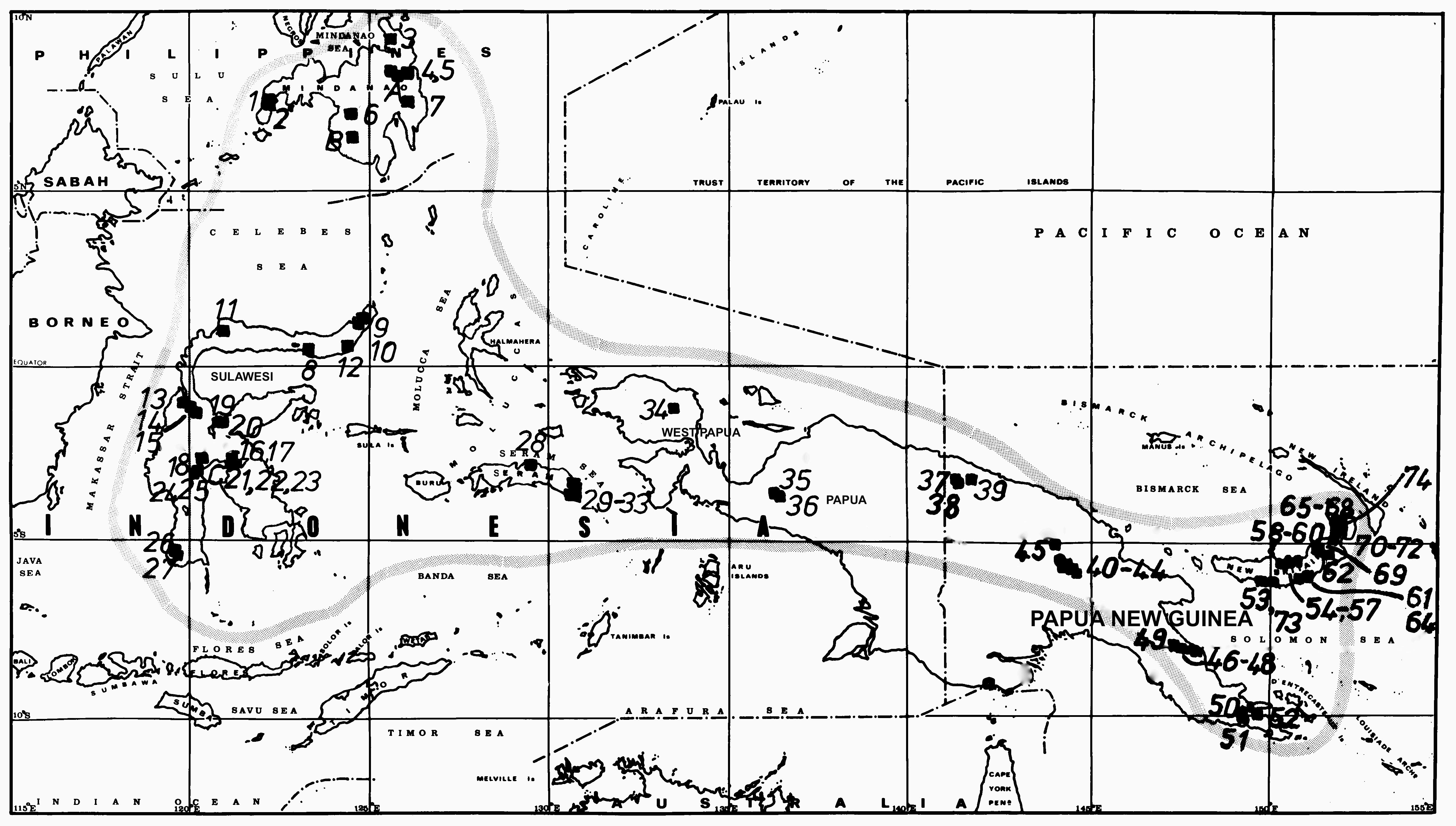
Herbarium collections: Mindanao. Zamboanga del Sur Province: (1)31 Caldera, near Zamboanga (Type of E. multiflora Rich (A Gray)), 1842, Rich 25483 (GH):32(2) No other information, 1911, Merrill 8063 (L); Agusan River catchment, New Bataan, 1968, Pryor 15495 (G) Sultan Kudarat Province: Milbuk, 1969, Cameron 111005, 6 (LAE); Zamboanga del Norte Province: Siocon, 1969, Cameron 111013 (LAE); Agusan Province: (3) Cabadbaran, Mount Urdaneta (Type of Eugenia binacag Elm.), 1912 Elmer 13865 (K, L, GH, A); No other information, 1915, Soriano, Ponce and Valderama FB 24486 (PNH): (5) Tungao So., San Mateo Bo., 1961, Mendoza 41982 (PNH) Cotabato Province: (6) Palimbam Valley, 1937, Henry, Aquino and Rodriguez 03778 80 (PNH) Davao del Norte Province: (7) Agusan catchment, 1968, Pryor 15495 (G, LAE).
Indonesia, Sulawesi:
Between about one 1° North and 2° South latitudes, E. deglupta was found on the plains and coastal rivers (for example near Dumoga (12), Tapa, Palu (14), Ongka, Toli toli (11), Balukan, Boloang, Kolawi, Saweiti, Tampak (25), Tibao, Ampibabo, Marantalo, Sausu, Pagowat (8), Lariang, Gorontalo, Kalonodale, Bongka, Ampana, Kabali, Batui, Poso (20) and Balanbal) and also at higher altitudes (for example at Gimpu and Pindolo).
Between 2° and 4° South latitude, the stands were scarce and small. They were mainly concentrated on the coastal plain from near Palopo (18), around the north of Bone Gulf, to Malili (21) (for example near Parara, Kaloukou, Tobou tobou, Todantana Padang, Mario and Kandoa). One stand had been located on the swampy plains of the west coast (near Sampaga).
South of 4° South latitude, E. deglupta occurred rarely. Scattered, single trees were found along the Wempalle and Berong Rivers, which flow towards the west coast. The southernmost stand on Sulawesi was located at Parenglui (near Sungguminasa (26)) on the southwest peninsula at 5° 15’ South.
The oldest and largest trees were found near Tobou tobou (65 80 m high, 40 45 m clear bole, 1 1.5 m diameter). The size of these trees impressed early botanists such as Reinwardt and Steup.33
Herbarium collections: Sulawesi. North Peninsula: (8) Toludujuno, Pagowat River (Type of E. deglupta Blume), 1821, Reinwardt 1020 (L); (9) Batumotolohu, 1929, Moha 6, N I F S bb. 13801 (L); (10) Bulemo, Popaja, 1931, Sukarman 25, N I F S bb. 15714 (L); Toli toli, Tende, 1940, Junus Mokodompit 2, N I F S bb. 32437 (L) Central: (13) Donggala between Lindu and Kulaui, 1930, Postumus 2553 (L); (14) Palu River, Karopu, 1932, Bish 36, N I F S bb. 17000 (L, A); (15) Maleku, 1935, Wateurandang E, 69, 70, N I F S bb.19585 6 (L, A); (16) Malili, Maleku, 1938, Weismann E, 242 N I F S bb. 23907 (L); (17) Mangkulande, 1938, Tobing E, 313, N I F S bb. 25544 (L); (18) Palopo, Tampa, 1938, Gangsuy 32, N I F S bb. 24137 (L); (19) Kali Tokararu 6km east of Lake Lindu, 1939, Bloembergen 216, N I F S bb. 28256 (L); (20) Poso, Bantuga, 1940, Moh. Ali 4 N I F S bb. 31904 (L); (21) Malili, Maleku, 1940, Reppie N I F S bb. 32354 (L, A); (22) Maleku, 1941, Irot 57, N I F S bb. 32615 (L, A); (23) Tomoni, 1941, Irot 57, N I F S bb. 32618 (L, A); (24) Kampong Tampa, 1941, Mangopang 5, N I F S bb.33080 (L); Tampak River, 28 km South of Palopo, 1969, Larsen 20641, 43 44 (FRI) South
31 Numbers in brackets in these sections refer to locations shown on the map of the geographic distribution of E. deglupta
32 Abbreviations for herbaria follow Lanjouw J and Stafleu F A 1964 Index Herbariorum. Part 1: Herbaria of the World, Utrecht, Netherlands, except for “FRI” (Herbarium of the Forest Research Institute, Canberra) and “G” (Gauba Herbarium, Department of Botany, Australian National University, Canberra).
33 Reinwardt C G C 1856 in de Vriese, Plantae Indiae Batavae Orientalis (1):65, and Steup F K M 1931 Bijdragen tot de kennis der bosschen van noord en midden Celebes. Tectona 24:1121 1135.
West Peninsula: (26) Sungguminasa, Malino, 1928, Burghardt N I F S bb. 12384 (L, BRI); (27) Gowa, Tombongi, 1940, Salverda N I F S bb. 32444 (L, A).
Indonesia, Seram:
On Seram (formerly Ceram), E. deglupta had been found at only a few sites on the northeast (28), east (29 32) and southeast (33) coasts. It was found along rivers, which are quite short (only 10 15 km long), arising in the high central mountains and flowing across a narrow coastal lowland strip (for example Samal, Matakabo, Boebi, Masiwang, Wahai, Tasikmi, Afing, Toloearang, Moeal, Isal, Lolo and Nif Rivers). E. deglupta had not been found in the western half of the island (west of the Wahai River) nor anywhere in the mountains of the island. The Agricultural Services in Ambon had documents reporting that the species occurred on the southeast coast of Seram, but no details were available on locations and appearance of those stands, the only definite record being the herbarium specimen collected from the vicinity of the Afing River (33) in 1918.
Herbarium collections: Seram. North: (28) Mual, 1917, Rutten 124 (L) East: (29) Matakabo River, 1917, Rutten 328 (L); (30) Between Waru and Masiwang, 1918, Kornasi 984 (L); (31) Semos River, 1938, Buwalda 607 (L, A); (32) West Tasikmi, tributary of Samos River, 1938, Buwalda 5962 (L, BRI, A) Southeast: (33) Afing River, 1918, Kornasi 991 (L).
Indonesia, Flores:
Christian Cossalter, in a report on an E. deglupta seed collection expedition in May 1975, mentions that Mr. Ardikoesoema, a forester from the Bogor Institute, had stated that natural stands of E. deglupta had been found on some mountains in the western part of Flores, in areas where rainfall is particularly high. If this information was correct, the natural limit of E. deglupta in Indonesia would reach 8°30' S, close to the northwest limit of the range of E. urophylla. Provenances from Flores would be, with provenances from Papua New Guinea, the least equatorial within the entire species range.34
Indonesia, Irian Jaya: Until 1975, only three collections had been made from Irian Jaya.35These were made in the Wissel Lakes area (now Lake Paniai) (35, 36), and one from the Vogelkop Peninsula (34).36In June 1975 Doug Boland of the CSIRO Tree Seed Centre and I made new collections of specimens including buds, flowers, fruits
34 See Cossalter C 1977 Location and ecological data of some provenances of Eucalyptus deglupta Blume in the Celebes and Ceram Islands characteristics of the natural stands. Forest Genetic Resources Information, FAO Rome 6:16 23. On a visit to the central and western parts of Flores in 1987 I was unable to locate any natural E. deglupta, but planted E. urophylla was quite common. There is no typical signature of any riverside E. deglupta visible on present day satellite imagery of western Flores. 35 Now Papua and West Papua Provinces, Indonesia (see map). The Lakes area is at the western end of the central cordillera in Papua. 36 Also now known as Bird’s Head Peninsula, Kepala Burung, or Doberai Peninsula in West Papua.
and seed from areas north of Lake Paniai (see earlier).37In the mountains the main occurrence was between 1,600 and 1,800 m altitude. Near the village of Mutitoh, E. deglupta occurred in broadleaf forest on mountain slopes along the Boro River at about 1,850 m altitude. This species was observed at several other places on nearby mountain slopes and ridges between 1,600 and 1,900 m altitude. Groups of E. deglupta occurred on a few steep ridges along the North Erome Valley and in the flat but narrow upper reaches of the Doria Creek (Kebo Valley) where it flows out of the high mountains (for example, Morauglito Summit: 2, 340 m altitude) and at Moritok, near Kebo.
Little is known of the extent of E. deglupta on the Bird’s Head Peninsula. The specimen (7946) was collected among trees growing at 1,800 m altitude in a riverain situation (Andjai and Wekari Rivers) and associated with Nothofagus sp conifer forest.
Leaf shapes of the specimens varied among the three locations. The collections by Zieck and Van Royen and Sleumer have ovate lanceolate leaves while the more rounded leaves of Eyma’s specimen are similar to those of specimens from the West Sepik District of PNG, for example from Ossima and Kilifas.
Herbarium collections: West Papua. Bird’s Head Peninsula: (34) Nettoti Range, East slope of Mount Nettoti, headwaters of Andjai and Wekari Rivers, 1961, Van Royen and Sleumer 7946 (LAE) Lake Paniai: (35) Bogesiga, 1939, Eyma 5360 (L), (36) Kebo, 1960, Zieck BW 3286 (L, CANB). Near Koebejo River, Wissel Lakes (35), Irian Jaya, altitude 1,850m, 10 June 1975, Davidson 1010 (WL1), (LAE, FRI); Near Koebejo River, Wissel Lakes, Irian Jaya, altitude 1,825m, 11 June 1975, Davidson 1011 (WL2), (LAE, FRI); Near Kebo, on slope near Koebejo River, Wissel Lakes, Irian Jaya, altitude 1,850 m, 12 June 1975, Davidson 1012 (WL3), (LAE, FRI); Near Kebo, on the bank of the Koebejo River, Wissel Lakes, Irian Jaya, altitude 1,750 m, 12 June 1975, Davidson 1013 (WL4), (LAE, FRI); Near Kedergboetoe, Wissel Lakes, Irian Jaya, altitude 1,750 m, 12 June 1975, Davidson 1014 (WL5), (LAE, FRI); Near Koebejo River, Wissel Lakes, Irian Jaya, altitude 1,850 m, 13 June 1975, Davidson 1015 (WL6), (LAE, FRI); Koebejo Valley, near Kebo, Wissel Lakes, Irian Jaya, altitude 1,750 m, 14 June 1975, Davidson 1016 (WL7), (LAE, FRI)
Papua New Guinea:
In eight districts of Papua New Guinea, E. deglupta occurs naturally; West Sepik (37 39); Eastern Highlands (40 41); Chimbu (42, 43); Western Highlands (44 45); Morobe (46 49); Milne Bay (50 52); West New Britain (53 57) and East New Britain (58 73). Best development of the species is found on New Britain. There, E. deglupta has extensively colonised recent volcanic deposits and landslide areas as well as sandbanks along more than 20 major streams. An interesting occurrence is found up to the tree line at 1,370 m altitude on the slopes of Mount Ulawun, an active volcanic cone rising from sea level to 2,298 m altitude in less than 10 km distance. Further information on locations,
factors affecting distribution and of forest types and associations in which E. deglupta occurs in Papua New Guinea is available from early parts of this report and from several other sources.38
Herbarium collections: West Sepik District: (37) Ossima, 1964, Sayers NGF 18009 (LAE, L, CANB, A, K, BOG, SING, SYD, UH, PNH, US); (38) Ossima, 1968, Davidson 303, 4 (LAE); (39) Southeast of Kilifas, Amanab, 1970, Foreman and Kumul NGF 48348 (LAE) Eastern Highlands District: Mt Wilhelm, east slopes, 1959, Brass 30764 (LAE); (40) Watabung, 1962, Simonett 42779 (LAE); (41) Keglsugl, 1964, Millar NGF 23161 (LAE, L, CANB, A, K, BOG, SING, SYD, UH, PNH, US, BISH, BRI) Chimbu District: (42) Kerowagi, 1968, Davidson 300 (LAE); (43) Koge Mission, Sina Sina, 1972, Hide 65, 66, NGF 3327 (LAE,L); Gembogl, 1966, Wade ANU 7495, 80378 (LAE) Western Highlands District: (44) Nondugl, 1951, Womersley NGF 4367 (LAE, L); (45) Jimmi Valley, 1967, Street and Manner 311 (LAE) Morobe District: (46) Jaduna, Waria River (Type of E. schlechteri Diels), 1909, Schlechter 19242 (K); (47) Morobe River, 1948, Womersley NGF 3134 (LAE); (48) No information other than “type locality E. schlechteri, Anonymous 8404 (LAE); (49) Saru River near Garaina, 1971, Howcroft NGF 25946 and 49 (LAE) Milne Bay District: Milne Bay, 1968, Pryor 101000 (LAE); Milne bay, 2 miles upstream Kutu River, Raba Raba, 1968, Pryor 101001 (LAE); (50) Kigara River, 1968 Arenz 105865 (LAE); (51) Ulumanu River, 1968, Arenz 105864 (LAE); (52) Raba Raba, 3 km upstream on the Kutu River, 1968, Pryor (G); Kaibola Village, Milne Bay, 1972, Frodin UPNG923, 233921 (LAE) West New Britain District: (53) Gasmata, Whiteman Range, upper Johanna River, 1966, Frodin NGF 26501, 2 (LAE, L, CANB, A, K, BOG, SING, SYD, UH, PNH, US, BISH, NEW YORK, BRI); (54) Hoskins, 1968, Pryor and Davidson 101602 3, 10 (LAE); Ko River near Hoskins, 1970, Davidson FRI 20348 (BRI); (55) Malilimi, 1972, Davidson 521 (LAE); Toiru River near Bialla, 1972, Davidson 511 (LAE); Wilelo, 2 km inland, 1973, Stephens and Lelean 206898, 58605 (LAE,L, CANB, A, K, EDINBURG, MUNICH SYD) East New Britain District: (58) Spacious Bay (Type of E. naudiniana F. Muell.), 1879, Turner (MELB, BRI); (59) Korindal, 1924, Lane Poole 797 (L, CANB, BRI, B); (60) Waterfall Bay, 1938, McAdam 94 (LAE); (61) Bulus River, 1945, Mair NGF 1823 (LAE, L, BRI, CANB); (62) Jacquinot Bay, 1945, Anonymous NGF 149 (LAE, BRI); (63) No further information, 1949, Heather 8399, 8403 (LAE); Unai River, Fulleborn Harbour, 1965, Sayers NGF 21827 (LAE, L, CANB, A, K, BOG, SING, SYD, PNH, BISH); Unai River Fulleborn Harbour, Kandrian 1966 Sayers NGF 26501 (LAE); (65) Sai River Pad 10, 1967, Davidson 258 (LAE); (66) Pad 2, 1967, Davidson 256 (LAE); Sai River (Open Bay Timber Area), 1975, Kumul NGF 38149, 38153 (L, CANB, A, LAE, K, BRI); Sai River (Open bay Timber Area), 1975, Kumul and Eddowes NGF 38153 (LAE); (67) Keravat River, 1968, Pryor and Davidson 101607, 9 (LAE); (68) Vudal River, 1968, Pryor and Davidson 101604 6 (LAE); (69) Asrogi River, 1972, Davidson 516 (LAE); Toriu River, 1972, Foreman 52166 (LAE, L, CANB, A, K, BOG); (71) Sai River 1972, Davidson 505 (LAE); (72) Coppice, Sai River, 1972, Davidson 503 (LAE); Aiwit River east of Fulleborn Harbour, 1973, Croft and Katik NGF 14986 (LAE, L, CANB, A, K, SYD, BISH, US, ED, MUN, ATHERTON); (74) Keravat River, 1974, Davidson 511 (LAE); Gazelle Peninsula, 1894, Schmiele (LAE, BRI); Keravat, sent to Canberra for illustrating Forest Tree Leaflet No. 175, 1974, Davidson (CANB).
Diels in his account of E. deglupta (as E. naudiniana)39cites a specimen from New Ireland as follows (translated): “Namatanai, near Vuna Marita, 70 m high tree. Local name “Kumurere” (Peekel n. 708 …. 19. November 1910)”. This citation probably has been responsible for several references to New Ireland being part of the natural distribution pattern for E. deglupta (for example, see Maiden 1903 1933 and Ferguson 1950).40
There is no Vuna Marita near Namatanai. The prefix Vuna is not applied to any place names in that region of New Ireland but is common, however, on the Gazelle Peninsula, New Britain. The quoted local
38 Including Davidson J 1972 loc. cit. and Davidson J 1973 A description of Eucalyptus deglupta Tropical Forestry Research Note SR7, Department of Forests, Port Moresby.
39 Diels L 1922 Die Myrtaceen von Papuasien. In Engler A (ed) Botanische Jahrbucher 57:423.
40 Maiden J H 1903 1933 A critical revision of the genus Eucalyptus, 8 volumes, Government Printer, Sydney; and Ferguson J H A 1950 Eucalyptus deglupta Blume. Tectona 40:51 61.
name “Kumurere” seems very similar in pronunciation to the Tolai name “Kamarere”, and the Tolai are the indigenous inhabitants confined to the Gazelle Peninsula and are not from New Ireland.
The National Herbarium of Papua and New Guinea was located in the building housing the Division of Botany, Department of Forests, in the grounds of the Lae Botanical Gardens, and seen here in 1972. It was opened on 12 April 1965.

Peekel paid an extended visit to New Britain in 1910, the year when his specimen 708 was collected.41Some maps of the Gazelle Peninsula, for example Department of Lands, Surveys and Mines 1956, reveal a mission station known as Vuna Marita on the north Bainings coast near Massawa and this is probably the correct locality of Peekel 708. Peekel, in his description of E. naudiniana, himself states that the species was found only on New Britain in the Bismarck Archipelago.42 The Reverend G Brown was reported to have seen eucalypts in New Ireland during his missionary travels43but it is not known whether these were planted trees or not and no contemporary evidence is available to support his observation. Extensive recent aerial surveys, even in such likely locations as the Weiten Kamdaru
41 Van Steenis C C G J Kruseman M J 1950 Cyclopaedia of Collectors. In Van Steenis C C G J (ed) Flora Malesiana 1(1), Djakarta.
42 Peekel P G 1947 Illustrierte Flora des Bismarck Archipels fur Naturfreunde (MS) 7:1341 1342. Original is in the Library of the Provinzialat of the Sacred Heart Mission, Wesphalia, Germany. A copy was held in the Library of the National Herbarium in Lae PNG.
43 See Von Mueller F 1886 Description of a hitherto unrecorded species of Eucalyptus from New Britain. Australasian Journal of Pharmacy 1(7):239 240.
Valleys, have failed to locate even a single tree, other than cultivated examples, of E. deglupta on New Ireland.
The error in locality of Peekel’s specimen was probably the result of mis labelling at the Botanical Museum in Berlin, where he sent most of his material for identification. Standard printed labels with the name “Neu Mecklenburg; Namatanai” were attached by technical staff and were also probably attached in error to the few collections made outside New Ireland in 1910. This cannot be checked as specimen 708, along with most of Peekel’s other specimens, were destroyed during an Allied air raid on Berlin in 1943.
Taxonomy of E. deglupta
Since the name Eucalyptus deglupta was published in 1850, a number of valid synonyms have been published. Some of these arose over time because of collections being made periodically in different parts of the range and to poor communication among collectors and herbaria. The table here summarises the situation as of 1975 when this work was done.
TAXONOMIC CHRONOLOGY OF PUBLISHED TAXA RELATED TO EUCALYPTUS DEGLUPTA BLUME
Year Published Year Specimen Collected
Name Author Publication Status
1743 1668 Arbor Versicolor Rumphius Herb. Amb. 3:122 Specimen destroyed in a fire in 1687
1850 1821 Eucalyptus deglupta Blume Mus. Bot. Lugd. Bat. 1:83 Validly published species
1850 No specimen Eucalyptus versicolor Blume Mus. Bot. Lugd. Bat. 1:84 Invalid synonym taken up from Rumphius
1854 1842 Eucalyptus multiflora Rich (A. Gray) Bot. U. S. Exp.:554 Invalid species (Name pre occupied)
1886 1879 Eucalyptus naudiniana F. von Mueller Aust. J. Pharm 1(7):239 240 Validly published synonym
1914 1912 Eugenia binacag Elmer Leaflets of Phil. Bot 7(3):2351 2352 Validly published synonym changed to Eucalyptus by Elmer, 1915
1915 1912 Eucalyptus binacag Elmer Leaflets of Phil. Bot. 8:2776 Validly published synonym
1922 1909 Eucalyptus schlechteri Diels Beitr. Z Flora Von Papuasien In Botanische Jahrbucher 57:423
Validly published synonym
In the next table I have compared the historical descriptions of the various taxa and added my own synthesis and additional information in the last column.
HISTORICAL DESCRIPTIONS BY AUTHORS OF VARIOUS TAXA COMPARED TO THE LATEST AVAILABLE DESCRIPTION FOR EUCALYPTUS DEGLUPTA BLUME
CHARACTER EUCALYPTUS DEGLUPTA Bl.
EUCALYPTUS SCHLECHTERI Diels
EUCALYPTUS NAUDINIANA F. Muell.
Tree height Tall tree; 15 61m 6 9m To 30m
EUCALYPTUS MULTIFLORA Rich (A. Gray)
EUGENIA BINACAG Elm.
EUCALYPTUS DEGLUPTA Bl. (latest) *
20 30m Large, tall tree, 35 60m, occasionally to 80m
Tree diameter To 2m 1 1.5m 0.5 2.0m, occasionally to 3m Tree shape
Trunk cylindrical and tapering, branched towards the top
Branching habit Compact, four angled margins on ultimate branches
Younger branches quadrangular
Branchlets somewhat angled Glabrous, green, angled, slender, usually ascending curved
Trunk cylindrical, sometimes fluted and buttressed
Crown of young trees conical with definite leaders; mature trees with long raking branches covered with epicormics. Leaves held horizontally; terminal branches held horizontally to ascending curved Terminal branches and twigs mainly square or flattened in cross section
Bark Smooth, reddish, aromatic outer bark stripping off in large sheets
Leaf arrangement, colour, shape (mature)
Sparse, alternate, petiolate, pale green, ovate lanceolate, acuminate
Scattered, alternate, shortly petiolate (5 8mm), ovate to elliptically ovate, obtuse or shortly acuminate
Smooth
Ovate lanceolate, acuminate, much paler underneath
Unequally alternate, oblong, acuminate or at least acute both ends, petiolate (1.25cm), equilateral, dull and of same hue both sides
Greenish grey when old, peeling in thin elongated plates
Alternate, oblong ovate, sub pendant, shallowly conduplicate, recurved at the acute to acuminate apex, base obtuse or obtusely rounded, glabrous, deeper green on upper surface, petiolate (1.25cm)
Gum, 3 8mm thick, decorticating in strips leaving smooth white to pale green surface which ages through many colours
Opposite to sub opposite, rarely alternate, shortly petiolate, ovate to ovate lanceolate, acuminate. Upper surface green to dark green, lower pale green and dull
Leaf thickness and texture Slightly leathery, smooth, finely reticulated veins underneath
Not very thick Loosely feather veined, the primary veins and mid rib prominent underneath
Papery Thin, primary veins and mid rib prominent underneath
Leaf length (mature) 5 14cm 9 10cm 7 10cm 10 12cm 12cm 10 20cm
Leaf breadth (mature) 2 7cm 6 8cm 3 5cm 4 5cm 5cm 6 10cm
Juvenile leaves (arrangement, shape, size)
Inflorescence type and size
Opposite, petiolate, ovate to oblong lanceolate, acuminate, thin, 5 x 5cm
Large terminal panicle Terminal panicle 15 18 x 15 18cm
Terminal or axillary panicles
Terminal and axillary paniculate cymes
Broadly lanceolate Opposite, thin, shortly petiolate, broadly ovate to ovate lanceolate and acuminate, 7 11 x 5 7cm
Profuse erect panicles, all terminal, 10 12cm long, glabrous, lower and longer branches subtended by leaves, branchlets opposite, large ones compressed and fluted along the edges
Terminal and axillary panicles, 5 20 x 5 18cm, branchlets compressed and fluted along the edges
Pedicels 2 3mm long
Bud shape, colour and size
Clavate to cylindrical acute, pedicellate, operculum acutely conical, as long as calyx tube, 5 x 4mm
Pedicellate, broadly elliptical to almost globular rostrate, 3 4 x 4 5mm, operculum hemispherical, shortly apiculate or rostrate, longer than the calyx tube
Umbellately fascicled, as long as the capsules
Obovoid, glabrous, yellowish green, calyx glabrous, short, cup shaped, 3 x 3mm
5mm long
Globular to sub clavate, apiculate, 0.2 0.4 x 0.2 0.5mm. Operculum hemispherical, apiculate, wider than long
HISTORICAL DESCRIPTIONS BY AUTHORS OF VARIOUS TAXA COMPARED TO THE LATEST AVAILABLE DESCRIPTION FOR EUCALYPTUS DEGLUPTA BLUME (Continued)
Bud arrangement 3 7 in umbel
Flowers
9 or fewer in umbel 3 5 in umbel Umbel 3 7 in umbel
Stamens inserted on the inner rim, strongly inflexed in the bud, widely spreading in anthesis, inner one much shorter
White to pale yellow, stamens 2 10mm long, strongly reflexed in the unopened bud
Anthers
Reniform with a small terminal gland
Fruit shape and size
Pedicellate, ovoid clavate or globose, 5 x 5mm, disc thin, valves as long as the calycine portion, protruding
Timber Reddish, sound, moderately durable
Type or reference specimens
Shortly pedicellate 3 x 3mm, disc minute, valves small, exsert, ovary three celled
Minute, roundish ovate, bursting longitudinally
Roundish ovate, tending auriculate, versatile, with terminal gland, translucent, dehiscing by separate slits
Pedicellate, globular, four celled Pedicellate, flatly globose Pedicellate, hemispherical, valves 3 5, thin deltoid, exserted to 2mm. Capsule 3 5 x 3 5mm
Reddish
Reinwardt, No. 1516, Pagowat R, Celebes, 1821
Sources of descriptions Blume, 1850; Miquel, 1855; Maiden, 1903 1933; Blakely, 1934 and 1935
Schlechter, No. 19242, Waria R. Morobe Province, PNG, 1909
Diels, 1922; Maiden, 1903 1933; Blakely, 1934 and 1935
Turner, Spacious Bay (Wide Bay), New Britain, PNG, 1879
Von Mueller, 1886; Maiden, 1903 1933; Peekel, 1947
Presumably Rich, Caldera, Mindanao, Philippines, 1842
Hard, heavy, slightly bitter, odourless, outer wood white, abrupt change to brown or reddish inner wood
Elmer No. 13865, Cabadbaran (Mt. Urdaneta), Agusan Province, Mindanao, Philippines, 1912
Density 0.3 to 0.9gms/cc. Heartwood pale brown to dark reddish brown, moderately durable
Davidson (various), Keravat, New Britain, 1974
Gray, 1854; Maiden 1903 1933 Elmer, 1914 Davidson 1973, Davidson this article
*Prepared by J. Davidson in 1975. Sources: Blume, Miquel, Maiden, Blakely, Diels, Von Mueller, Peekel, Gray, Elmer and Davidson; full citations are given elsewhere in the footnotes.
Taxonomic characters
Principal characters used to describe the separate taxa are listed in the table. The information given is derived mainly from original authors’ and later monographers’ descriptions, as indicated. It is proposed to discuss briefly the main characters mentioned in the table, namely tree height and shape and the dimensions and shape of buds, fruits and leaves.
Tree height and shape
Considerable overlapping occurs in reference to these characters. The small stature attributed to E. schlechteri has probably resulted from the description by Schlechter of a stand of young regeneration on the bank of the Waria River. Similar stands can be found on the river today. No large veteran tree exists in the locality where Schlechter collected his specimen and were probably absent also in 1909, since the shade intolerant regeneration was continually being crowded out by regenerating rainforest. Very few data were recorded for bole size or crown shape by the authors of the other taxa.
Bark
The bark is the most striking feature of this species but receives very little attention in the early descriptions except under the name Eugenia binacag. Blakely44 described the bark as “smooth, reddish, deciduous, somewhat similar to the bark of Angophora lanceolata”, while a more appropriate description was given by Elmer (for Eugenia binacag)45 “Greenish gray when old, peeling in elongated thin plates more or less twisting about the stem, usually one end separating and curved from the surface, leaving the brown nether side exposed, the plates finally falling and piling up around the base of the old trees”. Descriptions of the bark for the other related taxa are inadequate for comparison purposes.
Dimension and shape of buds
Where buds were available on the type material (E. binacag and E. schlechteri), or have been described since (E. naudiniana), they are stated a being close to globular in shape, clublike, with calyptra that are conical to hemispherical and have acute apices. Sizes given by authors range from 5 x 5 mm for E. deglupta to 4 x 4 mm for E. schlechteri. Calyptra size and shape are poor diagnostic characters, as they depend to a large extent on the stage of bud development at the time of collection.
Dimensions and shape of fruit
All authors, in describing the fruit, agreed it was pedicellate and ovoid, globose or clavate. Sizes stated varied from 5 x 5 mm for E. deglupta to 3 x 3 mm for E. schlechteri and E. binacag. The small fruit of E. schlechteri when compared to the other taxa, especially E. deglupta, was quite noticeable in the type locality. Near Lake Paniai in West Papua, the fruit was larger, the ovary half inferior and the valves were not strongly exserted.
Dimensions and shape of leaves
No distinction was made between juvenile and adult leaves by the original authors. This is necessary when considering the taxonomy of eucalypts. Both Blakely and Maiden later in their expanded descriptions do make this important distinction. There is considerable overlapping of leaf dimensions of the five taxa. Shapes described vary from ovate lanceolate and acuminate to oblong ovate and
44 Blakely W F 1934 A Key to the Eucalypts. Sydney, The Workers Trustees. Reprinted by the Forestry and Timber Bureau, Canberra, 1955.
45 Elmer A D E 1914 Myrtaceae Leaflets of Philippine Botany 7:2351.
acuminate. The rather broad leaves described for E. schlechteri have significance as broad leaves have been seen also at higher altitudes in PNG and in West Papua, Indonesia.
Measurements on E. deglupta leaves preserved as herbarium specimens
Available herbarium sheets and photographs of herbarium specimens were divided among fifteen locations where it was possible to obtain five sheets or 1:1 scaled photographs of sheets, each with at least six well developed, adult leaves attached. Sample size among locations was determined more by availability of specimen sheets than by consideration of precision. On each leaf, the nine parameters listed were measured as shown in the figure:
Mean, maximum and minimum values for each measured parameter together with standard deviation, standard error and coefficient of variation are given in the table.
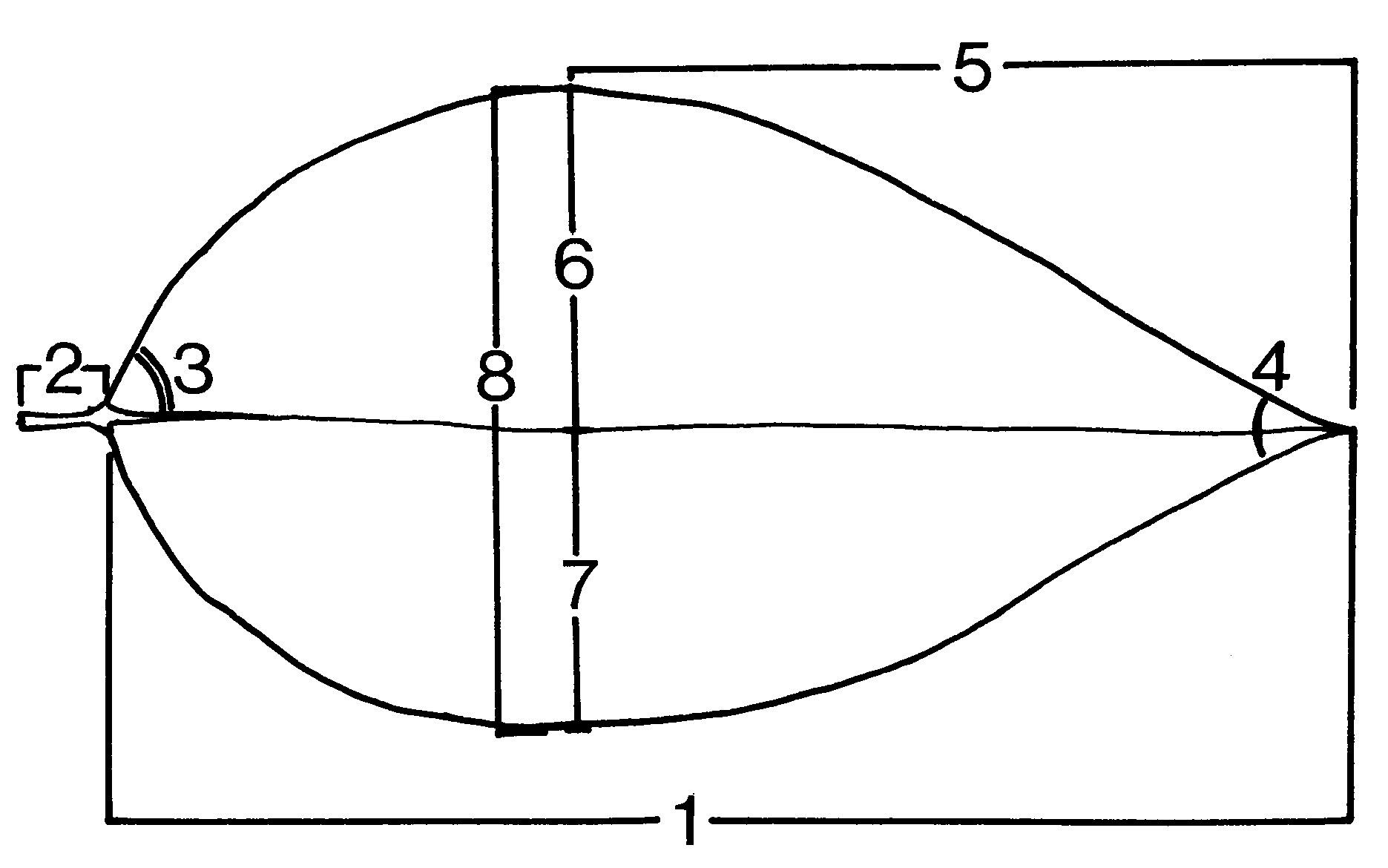
MEANS, MAXIMUM AND MINIMUM VALUES, STANDARD DEVIATIONS, STANDARD ERORS AND COEFFICIENTS OF VARIATION FOR NINE PARAMETERS MEASURED ON LEAVES OF E. DEGLUPTA ON HERBARIUM SPECIMENS FROM FIFTEEN LOCATIONS
Specimen Locations
1.Blade length (mm) 2.Petiole length (mm) 3.Base angle (°) 4.Tip angle (°) 5.Distance of widest point from tip (mm) 6.Half blade width, wider half (mm) 7.Half blade width, narrower half (mm) 8.Blade width, widest part (mm) 9.Ratio 5/1
1.Waria River 70.0* 7.0 61.2 123.4 37.4 23.4 21.5 44.9 0.53 96 8 76 160 54 30 28 58 0.63 48 6 45 98 25 13 12 25 0.46 16.2 0.7 9.0 18.6 10.6 4.7 5.1 9.7 0.04 3.0 0.1 1.6 3.4 1.9 0.9 0.9 1.8 0.01 23.2 10.3 14.7 15.1 28.3 20.0 23.8 21.6 7.62
2.Lake Paniai 80.3 6.7 68.1 84.3 44.6 27.2 23.9 51.1 0.56 109 12 100 170 68 39 36 74 0.75 54 4 5 30 28 15 12 29 0.42 13.3 2.2 17.3 37.6 9.4 6.7 6.7 13.1 0.07 2.4 0.4 3.2 6.9 1.7 1.2 1.2 2.4 0.01 16.6 32.6 25.3 44.6 21.1 24.6 28.0 25.7 12.82
3.Ossima 100.0 10.2 68.8 64.4 58.5 31.7 29.5 61.3 0.59 160 16 90 100 85 50 47 94 0.67 42 5 60 32 25 13 11 24 0.34 26.2 2.6 7.2 18.8 14.7 8.3 7.9 16.0 0.06 4.8 0.5 1.3 3.4 2.7 1.5 1.4 2.9 0.01 26.2 25.9 10.4 29.1 25.2 26.0 26.8 26.1 10.48
4.Kigara River 113.7 9.9 62.1 67.0 64.5 31.0 28.8 59.8 0.56 153 13 75 135 94 39 38 77 0.64 89 5 50 20 44 23 22 45 0.39 17.9 2.1 6.5 31.3 13.7 4.0 4.2 7.9 0.06 3.3 0.4 1.2 5.7 2.5 0.7 0.8 1.5 0.01 15.8 21.4 10.4 46.7 21.2 12.9 14.5 14.8 10.32
5.Kutu River 119.6* 8.8 53.5 67.4 68.7 33.3 30.1 63.7 0.57 146 12 70 135 104 40 38 76 0.71 86 6 43 20 42 27 23 52 0.49 15.1 1.7 7.4 33.0 13.7 3.8 3.6 6.8 0.05 2.8 0.3 1.3 6.0 2.5 0.7 0.7 1.3 0.01 12.6 19.5 13.8 49.0 20.0 11.5 11.9 10.7 9.56
6.Toriu River 124.6 12.0 49.9 34.7 72.7 30.5 28.5 59.3 0.58 155 17 65 82 105 44 39 83 0.68 97 7 36 15 49 21 18 40 0.48 16.3 3.2 7.9 17.9 13.9 4.8 4.7 9.1 0.05 3.0 0.6 1.4 3.3 2.5 0.9 0.9 1.7 0.01 13.1 26.5 15.8 51.4 19.1 15.8 16.6 15.3 8.69
7.Lolobau Island 134.2 9.9 67.3 30.0 85.7 31.6 29.9 61.5 0.64 155 12 85 37 103 39 37 76 0.71 95 7 53 18 58 22 17 42 0.48 13.0 1.4 6.8 4.3 9.7 4.0 4.4 8.3 0.04 2.4 0.3 1.3 0.8 1.8 0.7 0.8 1.5 0.01 9.7 14.5 10.2 14.2 11.4 12.5 14.8 13.4 6.50
8.Asrogi River 136.8 12.0 52.6 24.2 89.0 27.3 25.6 53.0 0.65 180 17 65 38 124 34 32 65 0.73 90 6 34 13 56 17 16 33 0.55 21.5 3.1 7.5 6.8 17.6 4.0 3.9 7.7 0.04 3.9 0.6 1.4 1.2 3.2 0.7 0.7 1.4 0.01 15.7 25.7 14.2 28.1 19.8 14.6 15.0 14.5 6.19
MEANS, MAXIMUM AND MINIMUM VALUES, STANDARD DEVIATIONS, STANDARD ERORS AND COEFFICIENTS OF VARIATION FOR NINE PARAMETERS MEASURED ON LEAVES OF E. DEGLUPTA ON HERBARIUM SPECIMENS FROM FIFTEEN LOCATIONS (Continued)
9.Sai River (1) 134.3 13.0 50.6 15.8 89.2 26.1 24.5 50.6 0.66 160 15 70 34 114 31 30 61 0.73 98 9 40 11 62 19 19 38 0.57 14.9 1.7 8.5 4.4 13.4 2.7 2.6 5.0 0.04 2.7 0.3 1.6 0.8 2.4 0.5 0.5 0.9 0.01 11.1 13.0 16.7 28.0 15.0 10.5 10.7 9.9 6.74
10.Sai River (2) 116.0 13.8 51.2 30.0 73.3 27.3 25.9 53.2 0.63 159 17 66 83 96 41 37 78 0.69 84 9 35 11 45 20 18 38 0.54 14.7 1.7 6.8 13.7 11.9 4.0 3.6 7.4 0.04 2.7 0.3 1.3 2.5 2.2 0.7 0.7 1.4 0.01 12.7 12.3 13.3 45.7 16.3 14.5 13.9 14.0 6.46
11.Keravat River 111.1 9.7 66.5 40.8 69.0 28.7 27.0 55.6 0.63 154 17 90 70 102 39 36 75 0.88 83 6 45 30 52 21 20 42 0.54 18.7 3.1 16.4 8.4 12.7 4.4 4.1 8.2 0.07 3.4 0.6 3.0 1.5 2.3 0.8 0.7 1.5 0.01 16.8 31.6 24.6 20.6 18.4 15.3 15.0 14.8 10.33
12.Sulawesi 102.8 10.7 67.7 62.1 65.1 28.8 25.2 54.0 0.62 170 14 90 120 138 44 40 84 0.83 50 6 45 15 35 13 12 25 0.45 31.7 2.1 16.3 34.9 30.2 9.4 8.5 17.6 0.11 5.8 0.4 2.8 6.2 5.5 1.7 1.5 3.2 0.02 30.8 19.6 24.0 56.2 46.4 32.8 33.5 32.6 18.65
13.Philippines 122.0 9.8 49.0 26.1 80.2 25.0 23.3 48.4 0.65 161 14 70 90 119 34 36 70 0.76 86 6 35 10 46 14 12 26 0.52 19.3 2.1 7.0 17.5 17.2 4.2 4.8 8.9 0.07 3.5 0.4 1.3 3.2 3.1 0.8 0.9 1.6 0.01 15.8 21.4 14.3 67.1 21.4 16.8 20.6 18.4 10.9
14.Pali River 104.7 9.4 57.4 23.1 68.3 23.9 22.7 46.5 0.65 144 13 75 36 93 39 38 77 0.72 66 5 40 12 40 13 11 25 0.55 20.8 2.1 10.7 6.8 14.5 6.8 6.4 13.1 0.05 3.8 0.4 2.0 1.2 2.7 1.2 1.2 2.4 0.01 19.8 22.7 18.6 29.3 21.2 28.5 28.3 28.2 7.12
15. Malilimi 95.2 12.2 44.4 38.6 55.9 23.7 21.8 45.6 0.58 152 19 66 90 102 38 35 71 0.68 42 6 31 15 21 12 12 24 0.48 28.9 3.4 8.7 21.0 20.7 6.2 5.4 11.5 0.05 5.3 0.6 1.6 3.8 3.8 1.1 1.0 2.1 0.01 30.4 28.2 19.6 53.5 37.0 26.3 24.8 25.3 9.47
Location Nos 1 15 correspond to the leaf numbers in the figure showing “average leaf models”
*For each locality: Row 1 = Means; Row 2 = Maximums; Row 3 = Minimums; Row 4 = Standard deviations; Row 5 = Standard errors; Row 6 = Coefficients of variation.
Coefficients of variation are a combination of variation among the six leaves of a specimen and from among specimens at a locality. Greatest variation was shown in the angle at the tip of the leaf while the ratio parameter varied least. Further, specimens from Sulawesi varied more than the others. Least variable were specimens from Lolobau Island.
MAXIMUM, MINIMUM AND MEAN COEFFICIENTS OF VARIATION FOR THE NINE PARAMETERS MEASURED ON LEAVES OF HERBARIUM SPECIMENS
Parameter (arranged according to magnitude of mean coefficient of variation)
Coefficients of Variation
Maximum Minimum Mean
Tip angle 67.09 (Mindanao) 14.72 (Lolobau Island) 38.57
Distance from widest point to tip 46.40 (Sulawesi) 11.36 (Lolobau Island) 22.77
Petiole length 32.56 (Lake Paniai) 10.31 (Sulawesi) 21.69
Half blade width, narrower half 33.52 (Sulawesi) 10.72 (Sai River (1)) 19.88
Blade width, widest part 32.62 (Sulawesi) 9.89 (Sai River (1)) 18.92
Half blade width, wider half 32.76 (Sulawesi) 11.53 (Kutu River) 18.82
Blade length 30.81 (Sulawesi) 9.68 (Lolobau Island) 18.01
Base angle 25.32 (Lake Paniai) 10.15 (Lolobau Island) 17.84
Ratio of the distance of the widest point from the tip to total blade length
18.65 (Sulawesi) 6.19 (Asrogi River) 9.46
The best parameters to use for comparisons among localities were blade length (parameter 1) and width (parameter 8) and the ratio distance of the widest point from the tip / blade length (parameter 9) because these differ markedly among locations while having low coefficients of variation within localities.
I used the means of the data to construct an “average leaf model” for each locality (see figure). These diagrams enable the variation in leaf shape and size among localities to be more easily understood.
The ratio of the distance from the widest point from the tip to total length (parameter 9) was found significantly different among provenance locations (at the 5% probability level in an analysis of variance). Leaves with higher values for the ratio (above 0.63 in the table) came from New Britain (Nos 7 11, 14). Leaves with the lower values of the ratio (below 0.60 in the table) came from mainland PNG (Nos 1, 3 5). Those from Lake Paniai, West Papua, Indonesia (No. 2, ratio 0.56) were within the range of the mainland PNG group. Leaves from Sulawesi, Indonesia (No. 12, ratio 0.62) and Philippines (No. 13, ratio 0.65) were within the range found for the New Britain group.
“Average leaf models” for 15 locations of herbarium specimen collections. 1. Waria River, Morobe Province, PNG (46); 2. Lake Paniai, West Papua Province, Indonesia (35); 3. Ossima, West Sepik (Sandaun) Province, PNG (37); 4. Kigara River, Milne Bay Province, PNG (50); 5. Kutu River, Milne Bay Province, PNG (52); 6. Toriu River West New Britain Province, PNG (56); 7. Lolobau Island, West New Britain Province, PNG (60); 8. Asrogi River, East New Britain Province, PNG (69); 9. Sai River (1), East New Britain Province, PNG (72); 10. Sai River (2) East New Britain Province, PNG (71); 11. Keravat, East New Britain Province, PNG (74); 12. Sulawesi, Indonesia (18); 13. Mindanao, Philippines (45); 14. Pali River, border of East and West New Britain Provinces, PNG (60); 15. Malilimi River, West New Britain Province, PNG (55). All to the same scale at about 40% actual size. Numbers in brackets are locations shown on the map of the natural distribution.
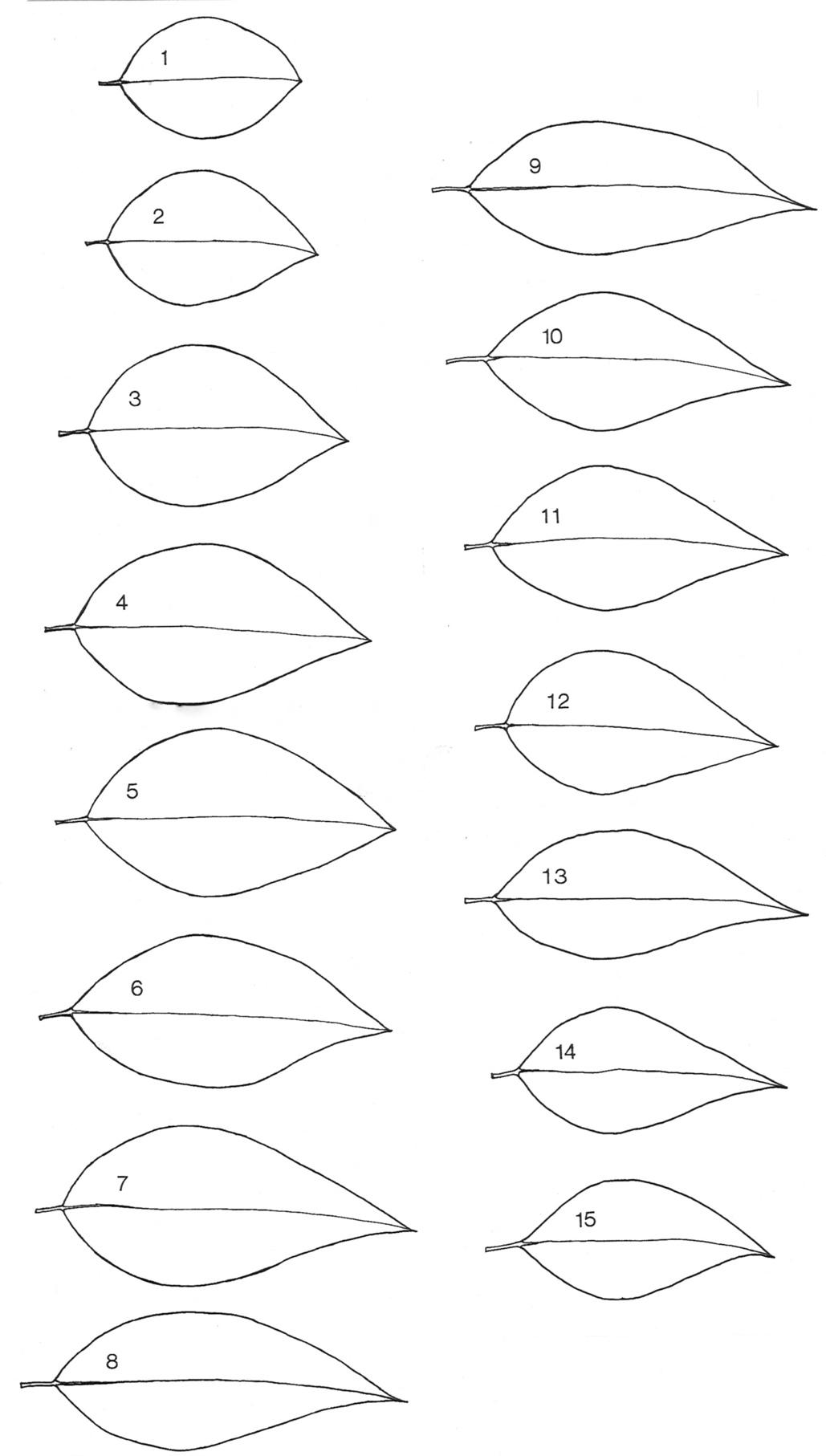
Measurements on leaves from a provenance trial at Keravat
Eight provenances in four replications of 36 tree plots had been grown at Keravat. In late 1974, at age 2.5 years, leaves were harvested from eight trees in each plot in each of the four replications per provenance. Six leaves were taken from each tree, the third, fourth and fifth pairs from the tip of one of the terminal branches in the upper crown: leaves x trees x replications x provenances = total leaves sampled 6 8 4 8 1,536
On each leaf, the 12 parameters listed and shown on the figure were measured:
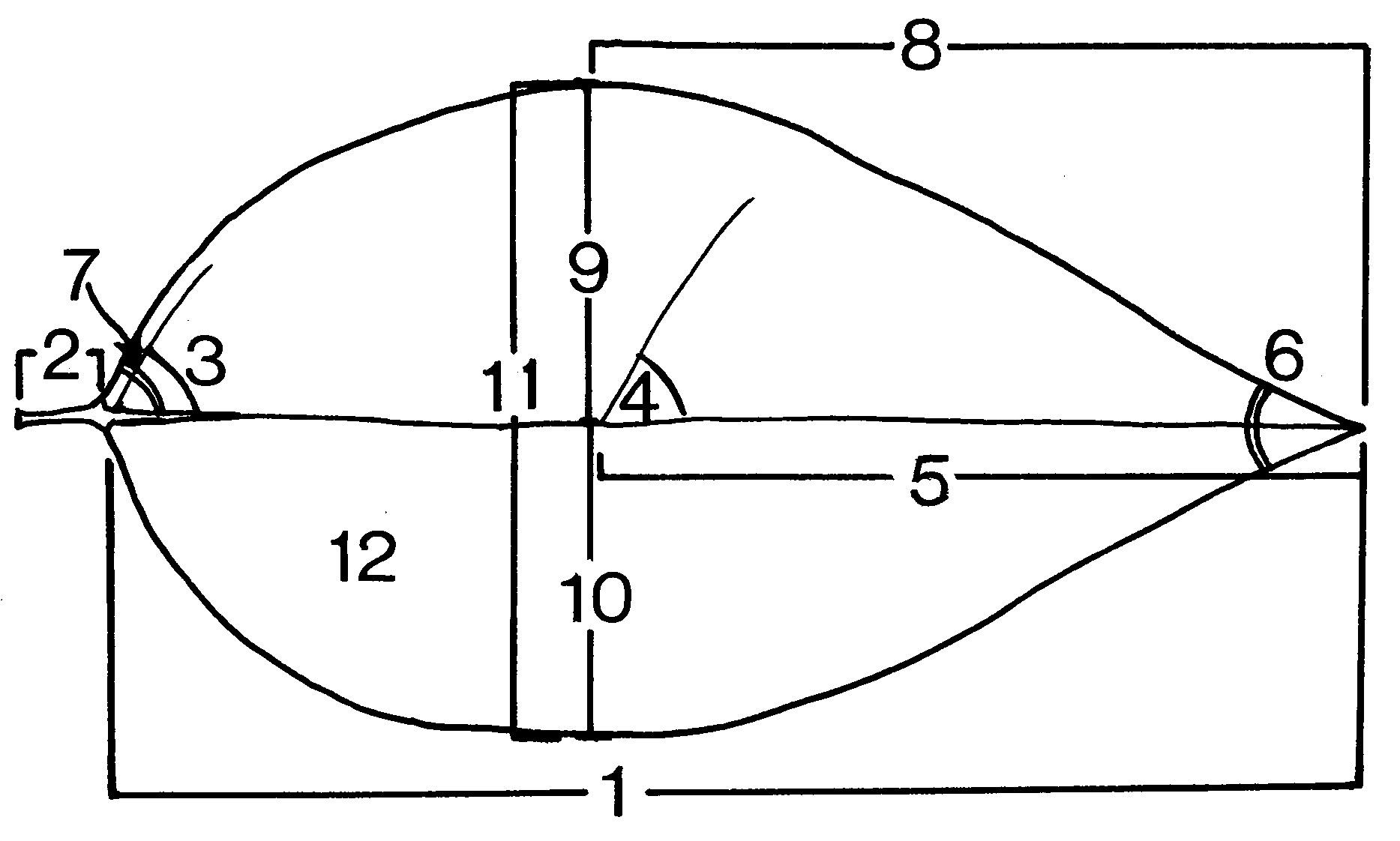
Blade length
Petiole length
Angle of first lateral vein to mid rib
Angle of fourth lateral vein to mid rib
Distance of fourth lateral vein from tip
Tip angle
Base angle
Distance of widest part from tip
9. Half blade width, wider half
10. Half blade width, narrower half
11. Leaf width, widest part
12. Leaf area
Mean, maximum and minimum values, for each parameter, together with standard deviation, standard error and coefficient of variation are given in the table. Coefficients of variation are a combination of variation among the six leaves from a tree and from among the eight trees within a provenance.
The tip angle (parameter 6) and leaf area (parameter 12) varied within provenances more than any other parameter (table). The two parameters quantifying angles of lateral veins to the mid rib (parameters 3 and 4) varied least within provenances, but differences among provenances were slight. Leaf length (parameter 1) and width (parameter 11) were the most suitable parameters for comparison of provenance localities as the means among provenances varied greatly while the means within provenances varied little (tables).
Because the provenances from eight localities were grown at a single locality (Keravat), much of the variation in leaf shape resulting from growth in the original different environments was reduced. Nevertheless, some differences were still observed as a result of the different genetic makeup among the provenances.
Mean leaf lengths varied from 127.4 mm (Mindanao (1) provenance) to 145.1 mm (Raba Raba provenance), a range of 13.9%. Mean leaf widths varied from 58.3 mm (Mindanao (1) provenance) to 72.4 mm (Mingende provenance), a range of 24%. In general, the mainland sources from PNG had broader leaves than the New Britain PNG and Sulawesi Indonesia sources.
MEAN, MAXIMUM AND MINIMUM VALUES, STANDARD DEVIATIONS, STANDARD ERRORS AND COEFFICIENTS OF VARIATION FOR TWELVE PARAMETERS MEASURED ON LEAVES OF E. DEGLUPTA FROM A TRIAL OF EIGHT PROVENANCES AT KERAVAT
Provenance Location
1.Blade length (mm) 2.Petiole length (mm) 3.Angle of first lateral vein to midrib (°) 4.Angle of fourth lateral vein to midrib (°) 5.Distance of fourth lateral vein from tip (mm) 6.Tip angle (°) 7.Base angle (°) 8.Distance of widest part from tip (mm) 9.Half blade width, wide r half (mm) 10.Half blade width, narrower half (mm) 11.Leaf width, widest part (mm) 12.Leaf area (cm 2 )
1.Keravat 140* 8.8 56.0 61.0 77.9 34.0 59.5 91.0 36.0 32.1 68.1 67.8 192 14 90 79 128 98 91 132 56 47 101 135.7 63 4 20 40 32 11 20 38 13 11 24 12.1 25.5 1.9 11.5 6.9 20.5 16.6 15.4 20.2 7.0 6.7 13.3 22.9 1.8 0.1 0.8 0.5 1.5 1.2 1.1 1.5 0.5 0.5 1.0 1.7 18.2 21.4 20.6 11.4 26.3 38.7 25.8 22.2 19.5 21.0 19.6 33.8
2.Mingende 142.3 7.2 57 59 80.8 48.1 66.6 86.4 38.5 33.8 72.4 75.4 183 13 79 74 112 87 99 125 51 50 101 104.9 87 3 45 45 41 21 40 51 27 20 53 33.2 20.9 2.4 6.1 6.0 14.4 17.3 13.6 15.0 5.6 5.0 9.7 18.1 1.5 0.2 0.4 0.4 1.0 1.2 1.0 1.1 0.4 0.4 0.7 1.3 14.7 33.2 10.7 10.3 17.8 35.9 20.4 17.3 14.6 14.9 13.4 24.0
3.Mt Hagen 135.2 6.6 60.0 59.0 78.2 41.0 58.6 84.7 35.1 30.1 65.2 65.2 194 11 75 79 124 91 99 140 53 44 94 132.1 76 3 29 40 37 15 19 41 15 12 30 17.9 25.1 1.6 7.5 6.6 18.7 15.3 14.1 17.9 7.1 6.3 12.8 21.9 1.8 0.1 0.5 0.5 1.4 1.1 1.0 1.3 0.5 0.5 0.9 1.6 18.5 24.1 13.2 11.2 23.9 37.3 24.0 21.2 20.2 20.9 19.6 33.6
4.Mindanao (2) 133.8 8.4 61 61 80.0 32.1 65.4 90.7 34.7 30.5 65.4 61.0 188 14 87 71 121 90 90 134 53 52 105 127.4 92 5 44 45 44 10 45 54 24 20 45 25.7 15.5 2.0 7.9 5.1 15.0 14.6 11.3 14.0 5.1 5.1 9.3 14.9 1.1 0.1 0.6 0.4 1.1 1.1 0.8 1.0 0.4 0.4 0.7 1.1 11.6 23.3 13.0 8.4 18.7 45.5 17.3 15.4 14.6 16.8 14.4 24.4
5.Sulawesi 130.2 6.9 60 60 79.4 32.2 62.6 83.3 34.3 29.7 63.8 57.9 189 12 80 79 134 75 90 127 53 44 89 100.8 81 3 45 46 41 15 35 41 18 11 31 15.6 21.4 1.5 7.7 5.5 17.8 14.7 11.7 17.1 5.9 6.0 11.8 17.1 1.5 0.1 0.6 0.4 1.3 1.1 0.8 1.2 0.4 0.4 0.8 1.2 16.5 22.2 12.8 9.1 22.4 45.8 18.7 20.6 17.4 20.2 17.4 29.5
6.Raba Raba 145.1 8.3 61 62 87.7 44.5 67.7 89.5 37.3 34.4 71.4 74.3 182 12 81 89 136 91 94 129 52 50 102 124.3 81 3 45 50 37 20 29 39 18 17 35 19.9 19.3 1.9 7.0 5.9 18.5 12.1 11.2 15.7 6.8 6.4 12.7 20.6 1.4 0.1 0.5 0.4 1.3 0.9 0.8 1.1 0.5 0.5 0.9 1.5 13.3 22.4 11.6 9.6 21.1 27.3 16.6 17.6 18.1 18.5 17.9 27.8
7.Mindanao (1) 127.4 8.7 55 58 74.1 36.6 50.3 80.9 30.9 27.5 58.3 52.7 193 16 80 75 116 90 90 142 55 50 100 125.8 72 4 30 40 31 10 18 38 13 12 25 9.2 23.6 2.4 8.6 6.3 19.5 14.9 17.6 18.4 7.7 7.4 14.9 23.1 1.7 0.2 0.6 0.5 1.4 1.1 1.3 1.3 0.6 0.5 1.0 1.7 18.5 27.6 15.6 10.7 26.3 40.8 35.1 22.8 25.0 27.0 25.6 43.9
8.Wilelo 128 6.6 54.0 58.0 71.3 50.1 54.7 81.9 32.0 28.2 60.1 57.7 216 17 80 77 123 97 94 144 55 43 98 116.7 59 3 30 29 32 21 21 30 17 13 30 16.2 29.1 2.3 9.7 7.5 21.3 20.0 13.9 22.9 6.8 6.0 12.5 22.1 2.1 0.2 0.7 0.5 1.5 1.4 1.0 1.7 0.5 0.4 0.9 1.6 22.6 35.1 18.1 12.9 29.8 39.9 25.5 27.9 21.1 21.4 20.8 38.4
* Row 1 = means; Row 2 = maximums; Row 3 = minimums; Row 4 = Standard deviations; Row 5 = Standard errors; Row 6 = Coefficients of variation.
“Average leaf models” for leaves from eight provenances grown in a replicated provenance trial at Keravat, East New Britain Province, PNG. 1. Keravat, East New Britain Province, PNG; 2. Mingende, Chimbu Province, PNG; 3. Mt Hagen (a land race from Keravat/Warangoi), East New Britain Province, PNG; 4. Mindanao, Philippines (2); 5. Sulawesi, Indonesia; 6. Raba Raba, Milne Bay Province, PNG; 7. Mindanao, Philippines (1); 8. Wilelo, West New Britain Province, PNG. All to the same scale at about 50% actual size.
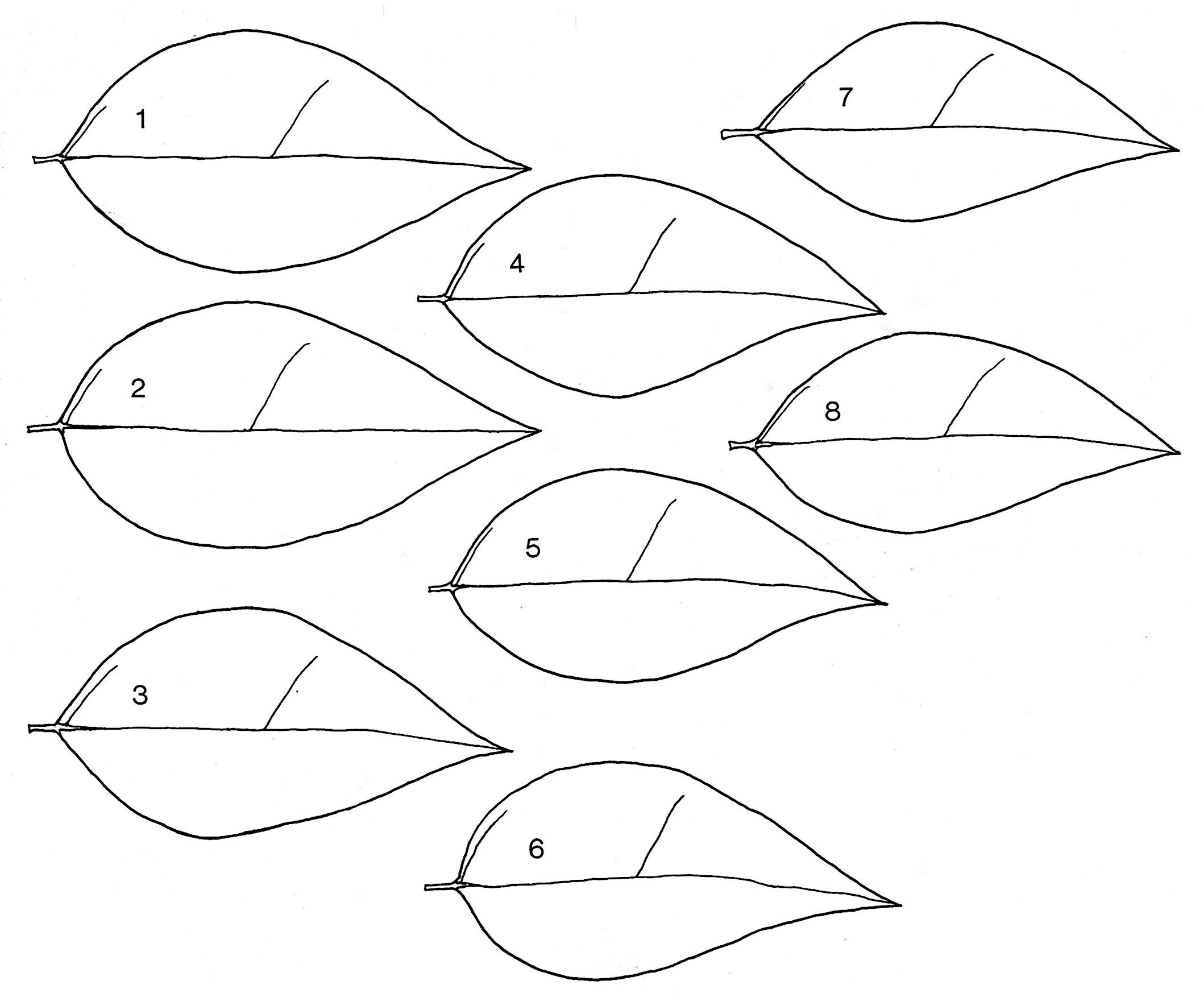
MAXIMUM,
MINIMUM AND MEAN COEFFICIENTS OF VARIATION FOR THE TWELVE PARAMETERS MEASURED ON LEAVES FROM EIGHT PROVENANCES IN A PROVENANCE
Parameter (arranged according to magnitude of mean coefficient of variation)
TRIAL AT KERAVAT
Coefficients of Variation
Maximum Minimum Mean
Tip angle 48.7 (Keravat) 27.3 (Raba Raba) 40.5
Leaf area 43.9 (Philippines (1)) 24.0 (Mingende) 31.9
Petiole length 35.1 (Wilelo) 21.4 (Keravat) 26.2
Distance 4th lateral vein from tip 29.8 (Wilelo) 17.8 (Mingende) 23.3
Base angle 35.1 (Philippines (1)) 16.6 (Raba Raba) 22.9
Distance widest point from tip 27.9 (Wilelo) 15.4 (Philippines (2)) 20.6
Half blade width, narrower half 27.0 (Philippines (1)) 14.9 (Mingende) 20.1
Half blade width, wider half 25.0 (Philippines (1)) 14.6 (Mingende, Philippines (2)) 18.8
Total blade width 25.6 (Philippines (1)) 14.4 (Philippines (2)) 18.6
Blade length 22.6 (Wilelo) 11.6 (Philippines (2)) 16.7
Angle of 1st lateral vein to mid rib 20.6 (Keravat) 10.7 (Mingende) 14.5
Angle of 4th lateral vein to mid rib 12.9 (Wilelo) 8.4 (Philippines (2)) 10.5
Single taxon at the level of species for E. deglupta
“We cannot form an idea of a species from a single individual, nor of a genus from a single one of its species.” G. Bentham (1800 1884).
With E. deglupta, we have the situation of a number of different species described to represent it over a relatively long period of time that appear separate when judged from the often inadequate original descriptions but fail to stand up to critical examination, particularly after further studies in the field. Although some phenotypic characters do appear to vary continuously, notably the width, length and tip angle of leaves, the required application of the type concept in plant classification tends to obscure these differences in E. deglupta, which, under the rules of botanical nomenclature, has to be seen as a taxonomically distinct, though variable, single species.
The results of the numerical studies on leaves give no evidence of meaningful groupings that could be the basis for formal taxa such as sub species. However, I considered the variety, “a weakly defined
entity”46an appropriate category, should it be desired for practical purposes, to refer to the populations with shorter and broader leaves as E. deglupta var. schlechteri and the populations with longer and narrower leaves tapering more acutely to pronounced drip tips as E. deglupta var. deglupta. This idea was not new. Heather47in 1955 had included the following note: “Specimens of Eucalyptus collected from the Morobe District are considered by the Forest Botanist, Mr J. S. Womersley, to have a close affinity to E. schlechteri Diels than to E. deglupta ”
This may explain why the Herbarium in Lae was sending out duplicates of specimens collected from the Waria River in Morobe Province in 1949 still labelled as “E. schlechteri”, as in the case of the sheet sent to the Herbarium Australiense, Canberra (see photograph of the specimen presented earlier in this account).
Reprinting of my PhD thesis
My PhD thesis was reprinted by the Department of Forests in 1975. It was widely distributed around PNG and copies were posted overseas to members of the IUFRO Working Party on Breeding Tropical and Subtropical Species.

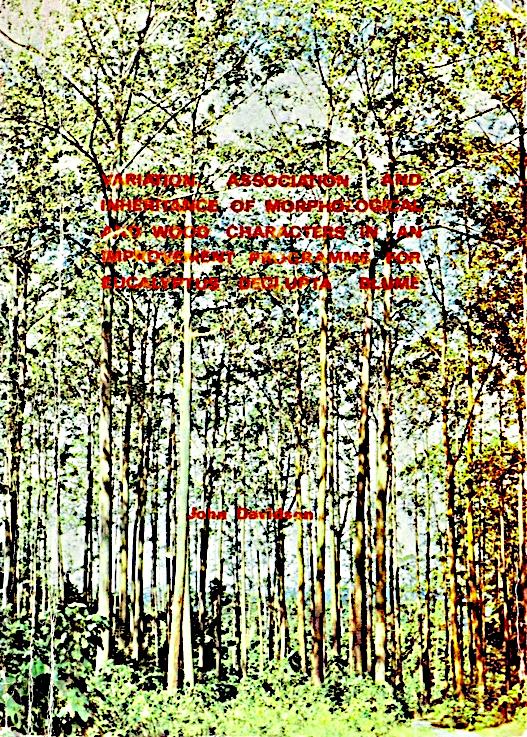
46 See Böcher T W 1967 Continuous variation and taxonomy. Taxon 16:255 258. 47 Page 256 In Heather W A 1955 The kamarere forests of New Britain. The Empire Forestry Review 34(3):255 278.
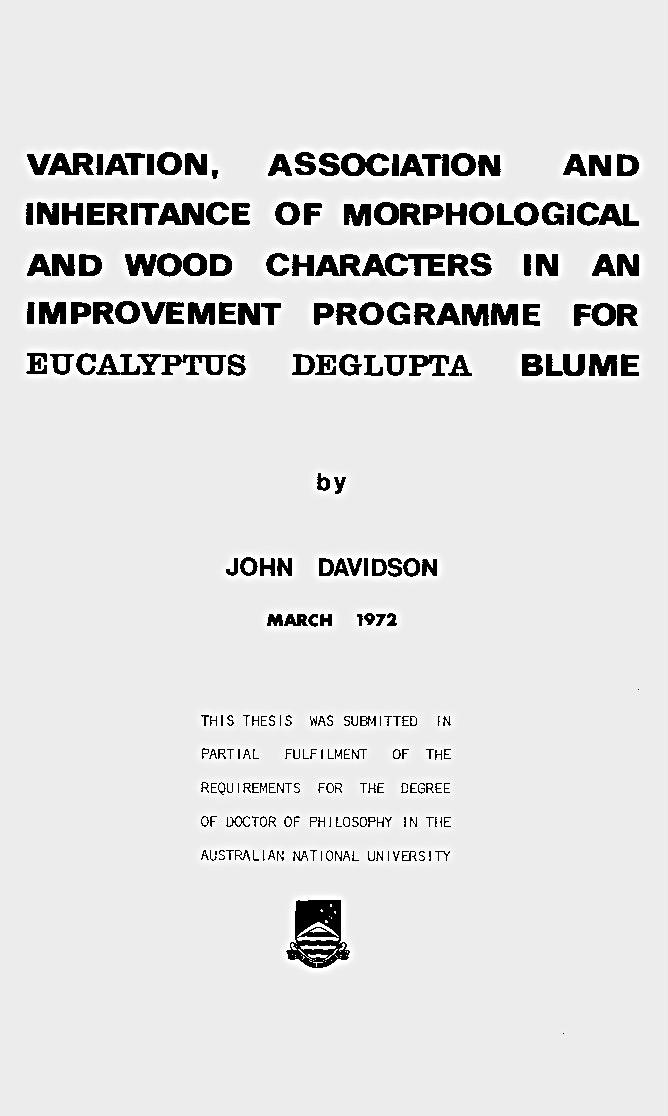
Comparison of two ecotypes of Kamarere: E. deglupta var. deglupta left and E. deglupta var. schlechteri right. The drawings on the left are typical of the New Britain, Indonesian Islands and Mindanao localities while those on the right are typical of localities on mainland PNG and in Papua and West Papua Indonesia (except possibly Vogelkop peninsula for which there are too little data to determine). a. Terminal, flowering branchlets; b. Green capsules, side view; c. Green capsules, end view; d. Longitudinal sections of flowers following anthesis; e. Inner calyptra; f. Transverse sections of ovaries; g. End views of mature fruits with four open valves. (Drawings by N Howcroft, Bulolo, 1973.)
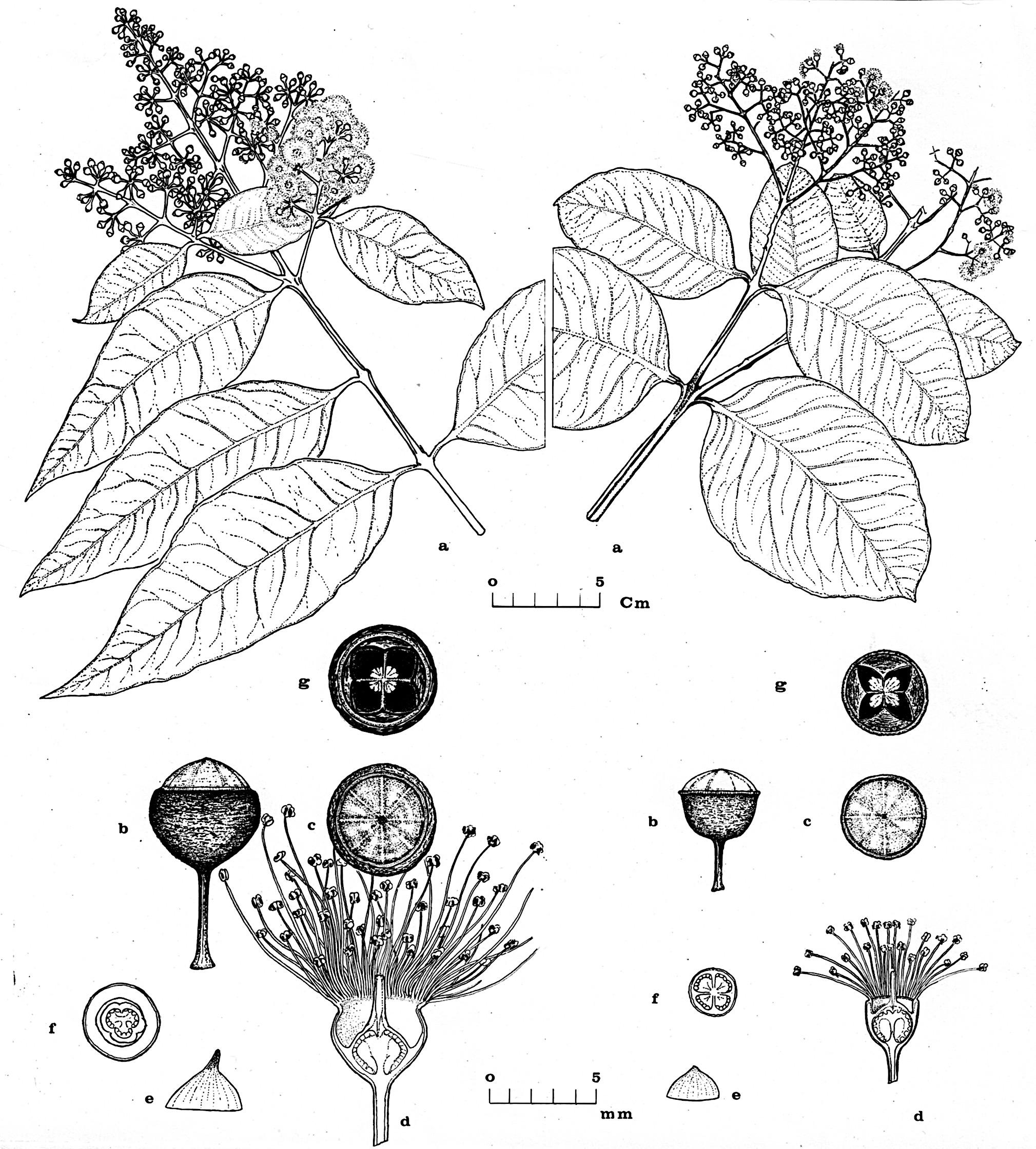
Permission to publish my work on E. deglupta
As I would soon be leaving the Department, on 20 May 1975 I wrote from the University in Lae to the Director, Department of Forests seeking approval to later publish my work on E. deglupta after it had been written up. I provided a tentative list of possible papers and subjects involving research at Keravat, Bulolo and Gogol. Permission was granted on 19 June 1975 (left).

